Shows
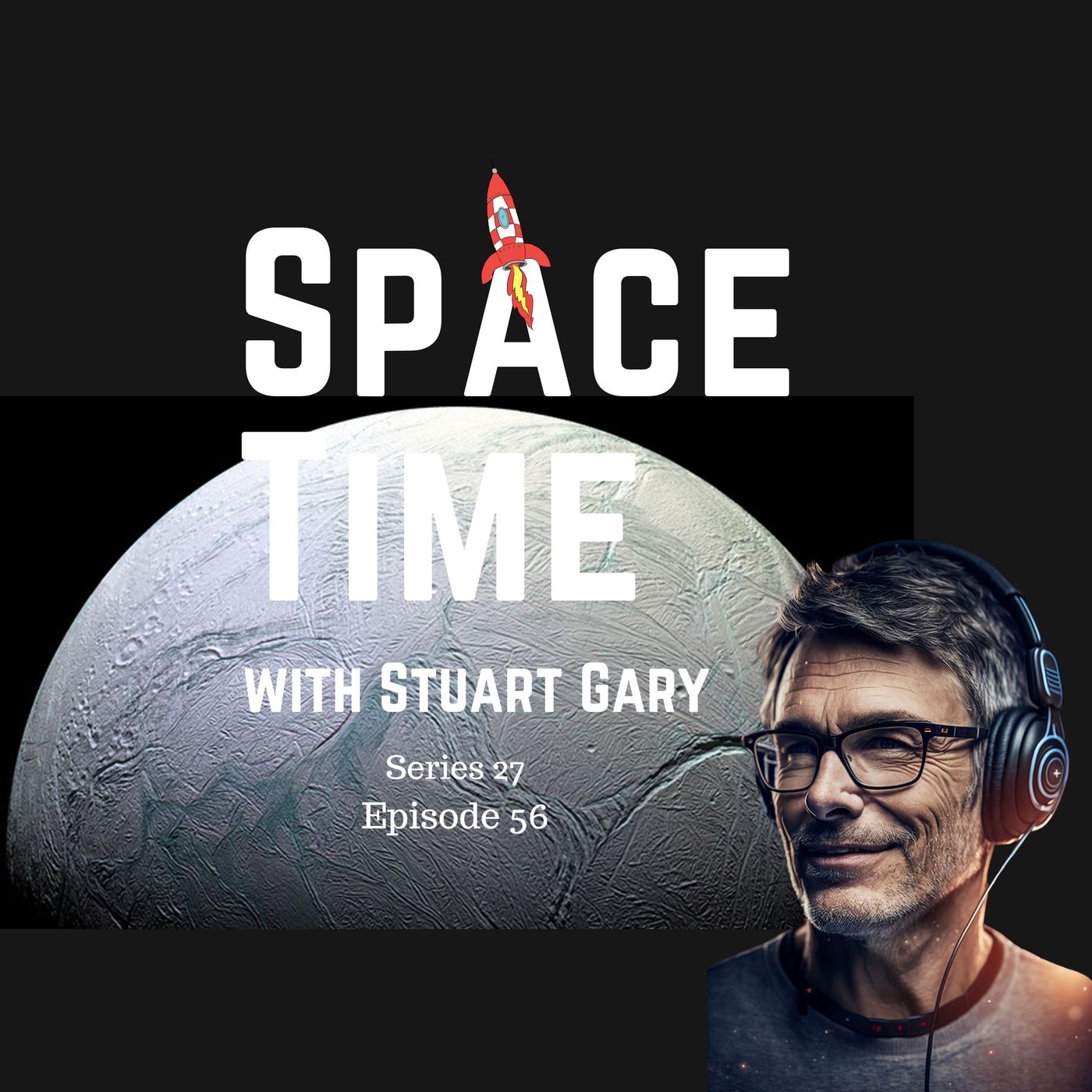
SpaceTime with Stuart GaryS27E56: Saturn's Geyser Moon Mysteries: Tidal Forces and Life's PotentialEmbark on an interstellar odyssey with SpaceTime Series 27 Episode 56, where we delve into the enigmatic geysers of Saturn's icy moon Enceladus. Unravel the mystery behind these spectacular jets as new research draws parallels with Earth's own San Andreas Fault, suggesting a strike-slip motion akin to our tectonic shifts may be powering these icy eruptions. Discover how this celestial phenomenon could hold the keys to conditions ripe for life beneath Enceladus's frozen crust.The episode then shifts to the dusty red plains of Mars, where NASA scientists brace for the onslaught of solar storms as our Sun approaches its fiery...
2024-05-0823 min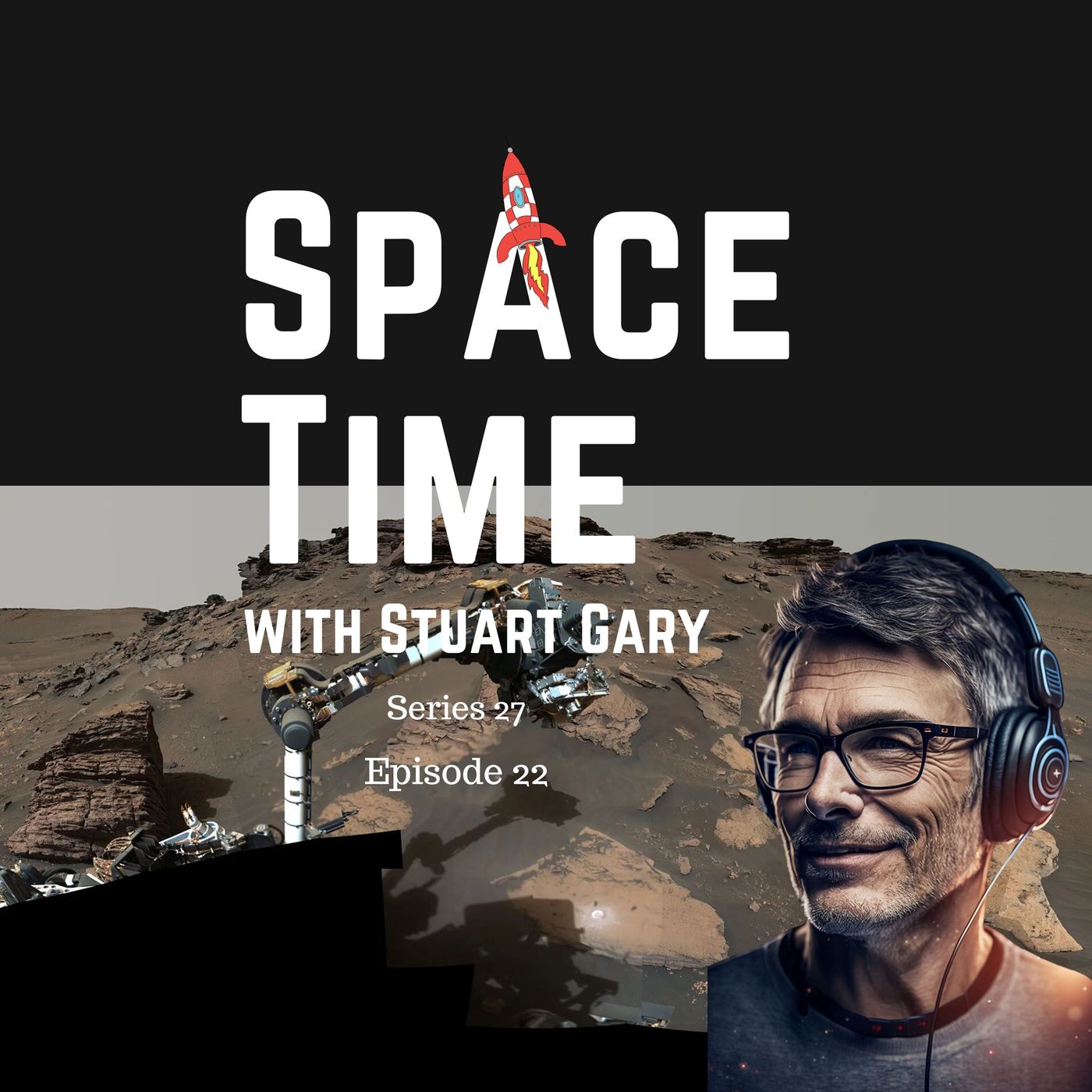
SpaceTime with Stuart GaryS27E22: Red Planet Hiccup: Perseverance's Dusty Dilemma and the Sherlock ConundrumSpaceTime Series 27 Episode 22*Technical Troubles for NASA's Mars Perseverance RoverNASA's Mars Perseverance rover faces a new challenge as engineers work to stabilize a dust cover on one of the rover's crucial science instrument cameras. The Sherlock instrument's cover remains partially open, hindering its quest to find signs of past microbial life in Jezero Crater. Will the team overcome this cosmic hiccup? Stay tuned.*Was Snowball Earth Triggered by an Asteroid Impact?A new study suggests that Snowball Earth events, which turned our planet into an icy wasteland, could have been sparked by an asteroid impact...
2024-02-1931 min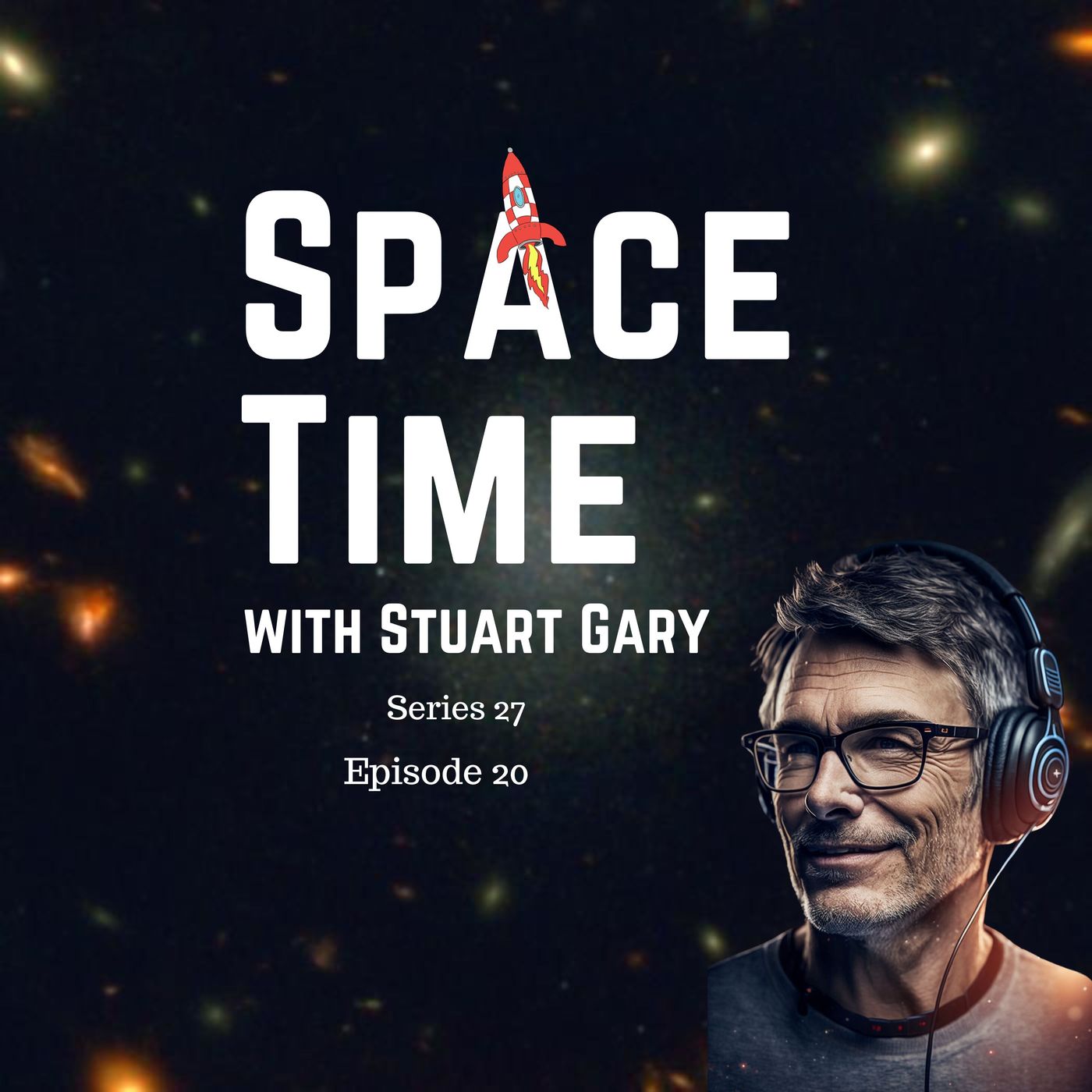
SpaceTime with Stuart GaryS27E20: The Improbable Galaxy: Unveiling the Enigma of Pearl SDGFor peace of mind when online and know you are protected get our special 60% off deal on Incogni. Visit www.incogni.com/stuartgary to get the dealThe Space, Astronomy & Science Podcast.SpaceTime Series 27 Episode 20*The Enigma of Pearl SDG: A Galaxy That Defies ExpectationsAstronomers are baffled by the discovery of Pearl SDG, a quiescent dwarf galaxy that exists against the odds, isolated and star-formation-free. Detected by NASA's Webb Space Telescope, this galaxy challenges our understanding of galactic evolution and could redefine scientific theories on how galaxies form.*Virgin Galactic's Space Tourism Hits Another...
2024-02-1424 min
SpaceTime with Stuart GaryS27E19: Saturn's "Death Star" Moon Hides a Watery SurpriseThe Space, Astronomy, and Science Podcast.SpaceTime Series 27 Episode 19*Saturn’s Moon Mimas Hides a Watery SecretMimas, once known merely as the Death Star look-alike, has revealed a startling secret. New research from the Cassini mission data shows that beneath its icy facade, this diminutive moon harbors a youthful subsurface ocean. Only 400 kilometers wide, Mimas's aquatic interior is geologically green, estimated to be a mere 5 to 15 million years old.*Juno's Daring Dance with the Volcanic IoNASA's Juno spacecraft has just grazed past the fiery surface of Io, Jupiter's most volcanic moon. During its in...
2024-02-1227 min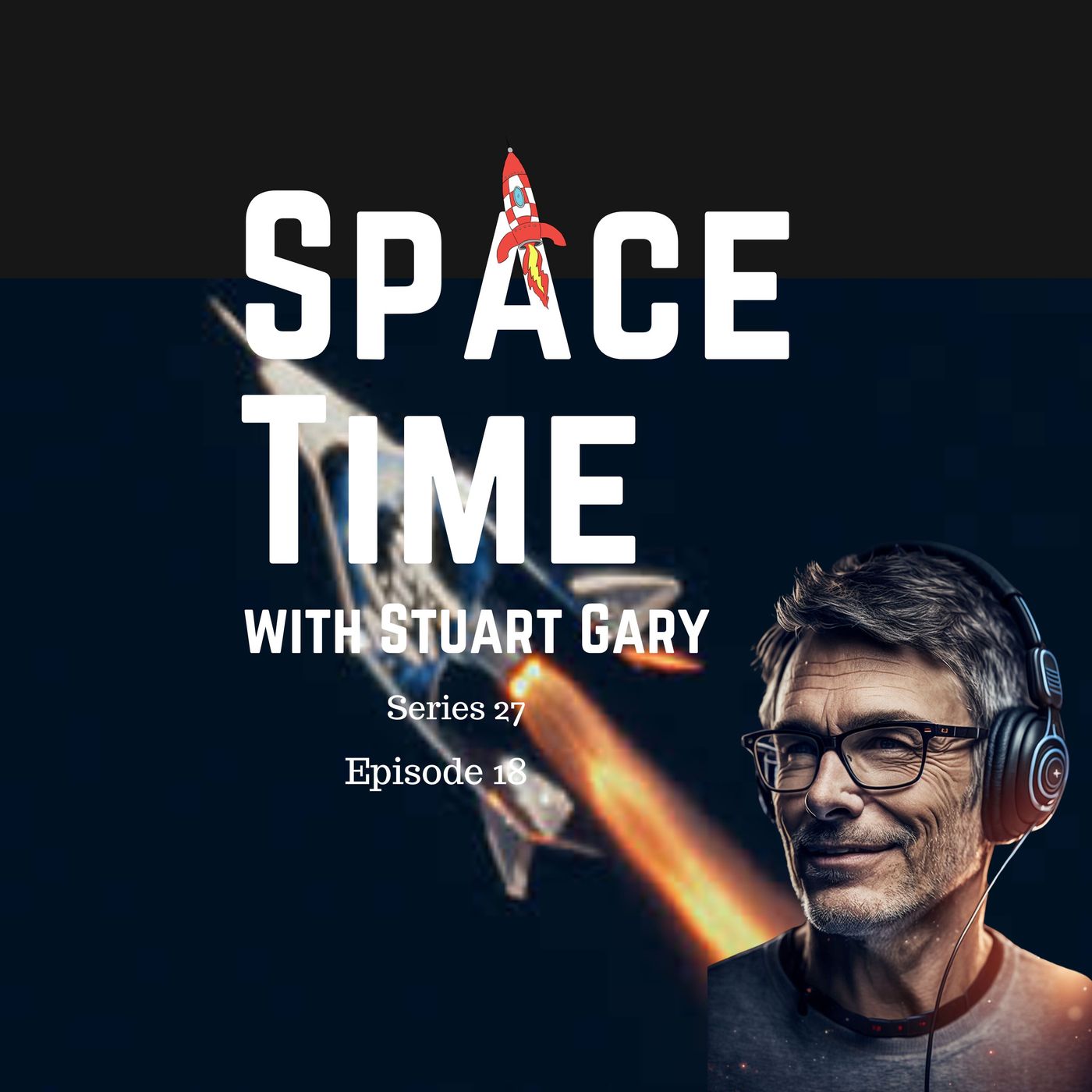
SpaceTime with Stuart GaryDark Matter Secrets Revealed with Lopsided Galaxies: S27E18The Space, Astronomy & Science Podcast.SpaceTime Series 27 Episode 18*Revealing Dark Matter through Lopsided GalaxiesA groundbreaking study unveils how asymmetric galaxies could be the key to unlocking the mysteries of dark matter, the elusive substance that dominates the universe's matter content and binds galaxies together.*Virgin Galactic's 2024 Space Tourism TriumphVirgin Galactic soars into the new year with a successful space tourism flight, reaching the fringes of space and marking a milestone for commercial space travel.*Reflecting on the SunRISE-3 MissionWe revisit the ambitious SunRISE-3 mission, which despite its untimely end, aimed...
2024-02-0937 min
SpaceTime with Stuart GaryMagellanic Clouds' Secret & Eris's Squishy Core | S27E02**Host:** Stuart Gary **Special Guest:** Technology Editor Alex Zaharov-Reutt ### Episode Highlights:1. **The Dual Nature of the Small Magellanic Cloud**: New research suggests that what was previously thought to be a single galaxy, the Small Magellanic Cloud, is actually two distinct galaxies. This groundbreaking discovery, based on studies of stellar motion and the interstellar medium, challenges previous astronomical beliefs.2. **The Dwarf Planet Eris's Unexpected Composition**: A recent study has indicated that Eris, a distant dwarf planet, might possess a more 'squishy' internal structure than previously assumed. This insight opens new avenues in understanding the formation and composition...
2024-01-0228 min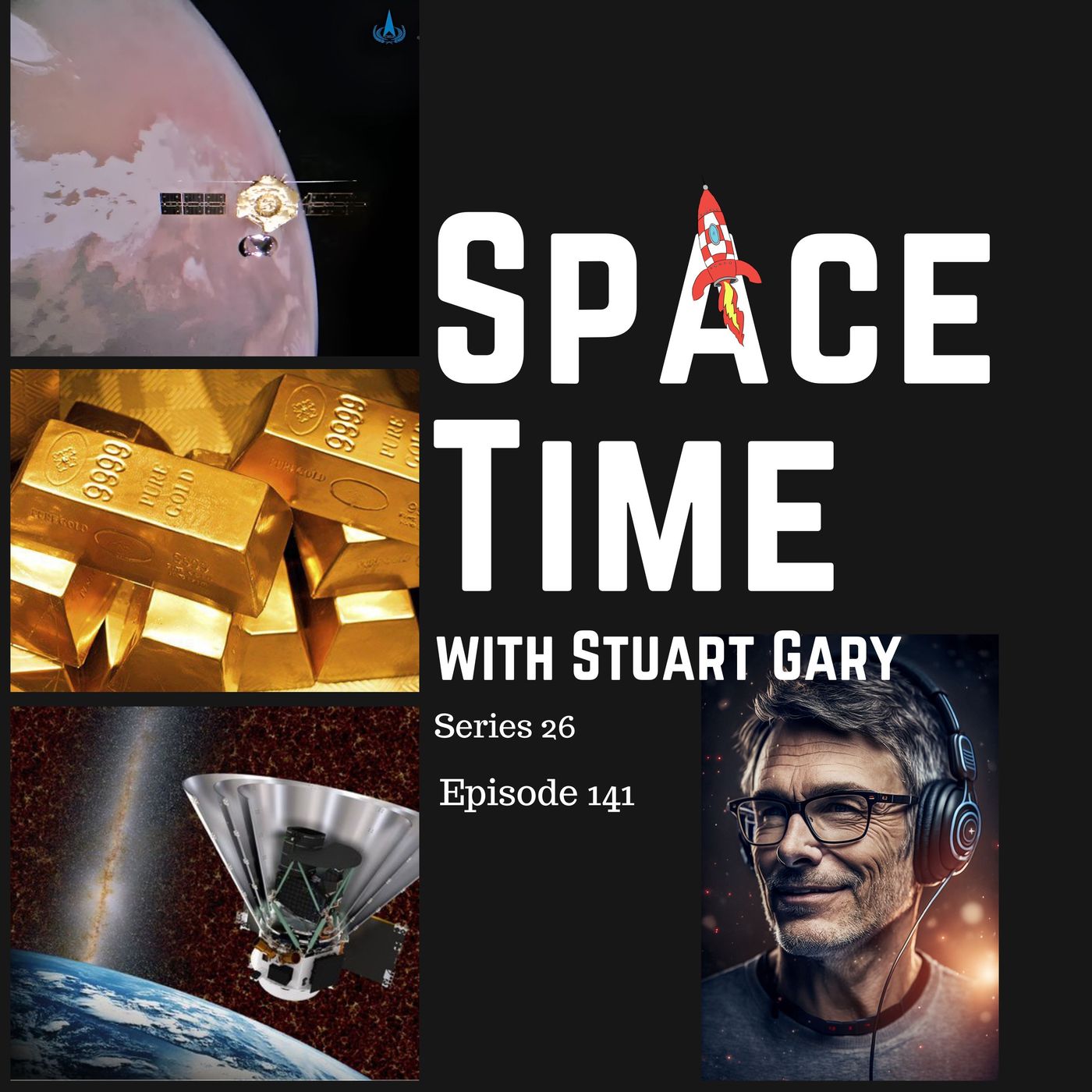
SpaceTime with Stuart GaryChina's Mars Race, Neutron Star Gold & NASA's SPHEREx | S26E141Welcome to the show notes for Episode 141 of the "Spacetime" podcast, hosted by Stuart Gary. In this episode, we delve into China's ambitious Mars mission, a novel cosmic source for gold, and NASA's upcoming SPHEREx mission. **Episode Highlights:** 1. **China's Mars Sample Return Mission**: Summary: China announces plans to conduct a Mars sample return mission, potentially beating NASA and ESA. The mission, named Tianwin Three, involves complex logistics and builds on the success of Tianwin One. 2. **Alternative Cosmic Source for Gold**: Cosmic Gold, Neutron Stars, Astrophysics, Heavy Elements, Gold Synthesis, Stellar Explosions. - Summary: Astrophysicists propose a new...
2023-11-2427 min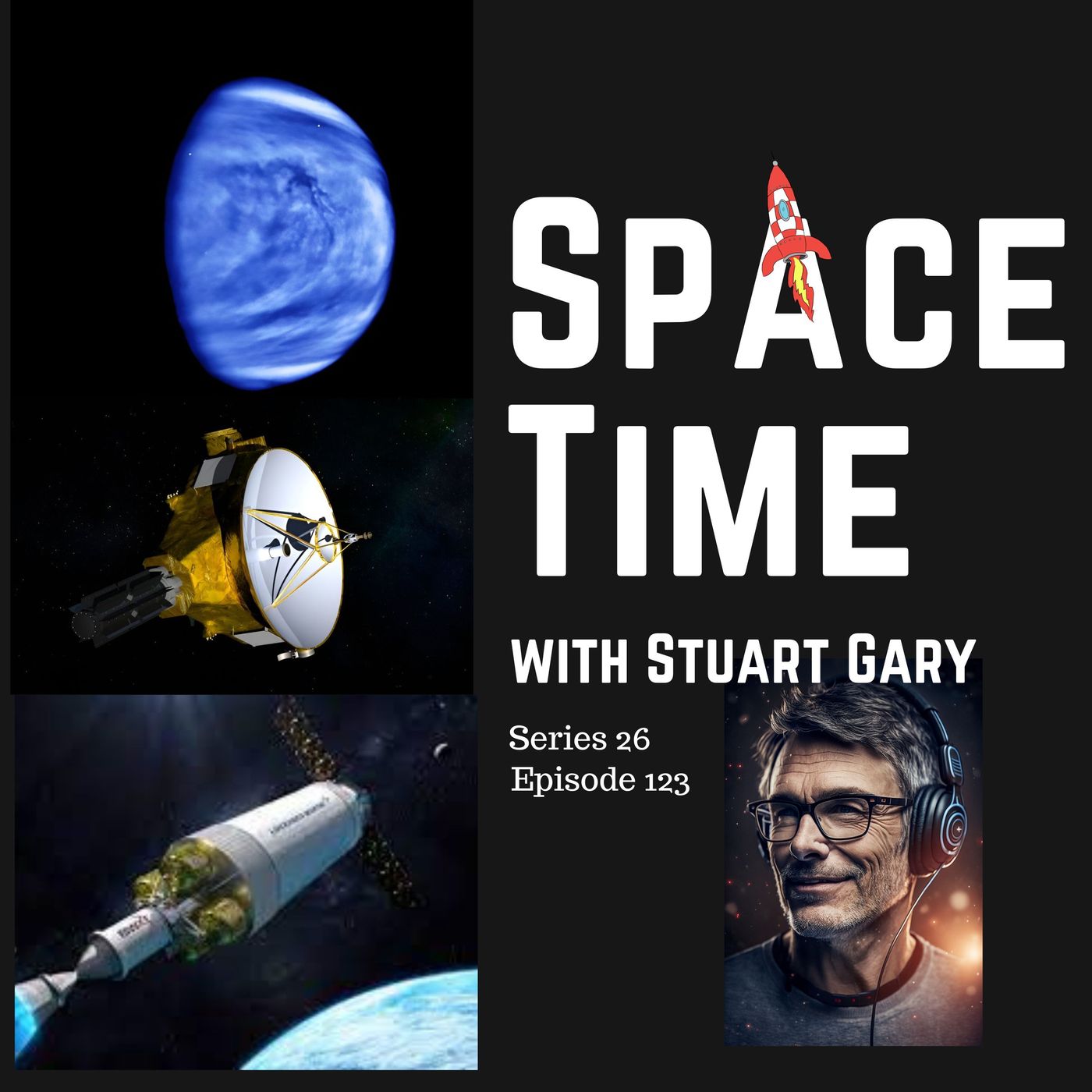
SpaceTime with Stuart GaryVenusian Lightning, Arrokoth's Secrets, and Surviving Aussie Zombies: S26E123**SpaceTime with Stuart Gary Series 26 Episode 123 Show Notes** --- **1. Lightning Mysteries on Venus** - A recent study has cast doubt on the long-held belief regarding lightning on Venus. - The thick acidic cloud cover of Venus, previously thought to generate significant lightning, is now under scrutiny. --- **2. Arrokoth's Mysterious Mounds** - The distant Kuiper Belt world of Arrokoth is home to intriguing mound structures. - Scientists speculate that these mounds might be the primordial building blocks for planetesimal formation. --- **3. Lockheed Martin & NASA's Nuclear-Powered Rocket** - NASA, in collaboration with the US military, has chosen Lockheed Martin as a partner...
2023-10-1323 min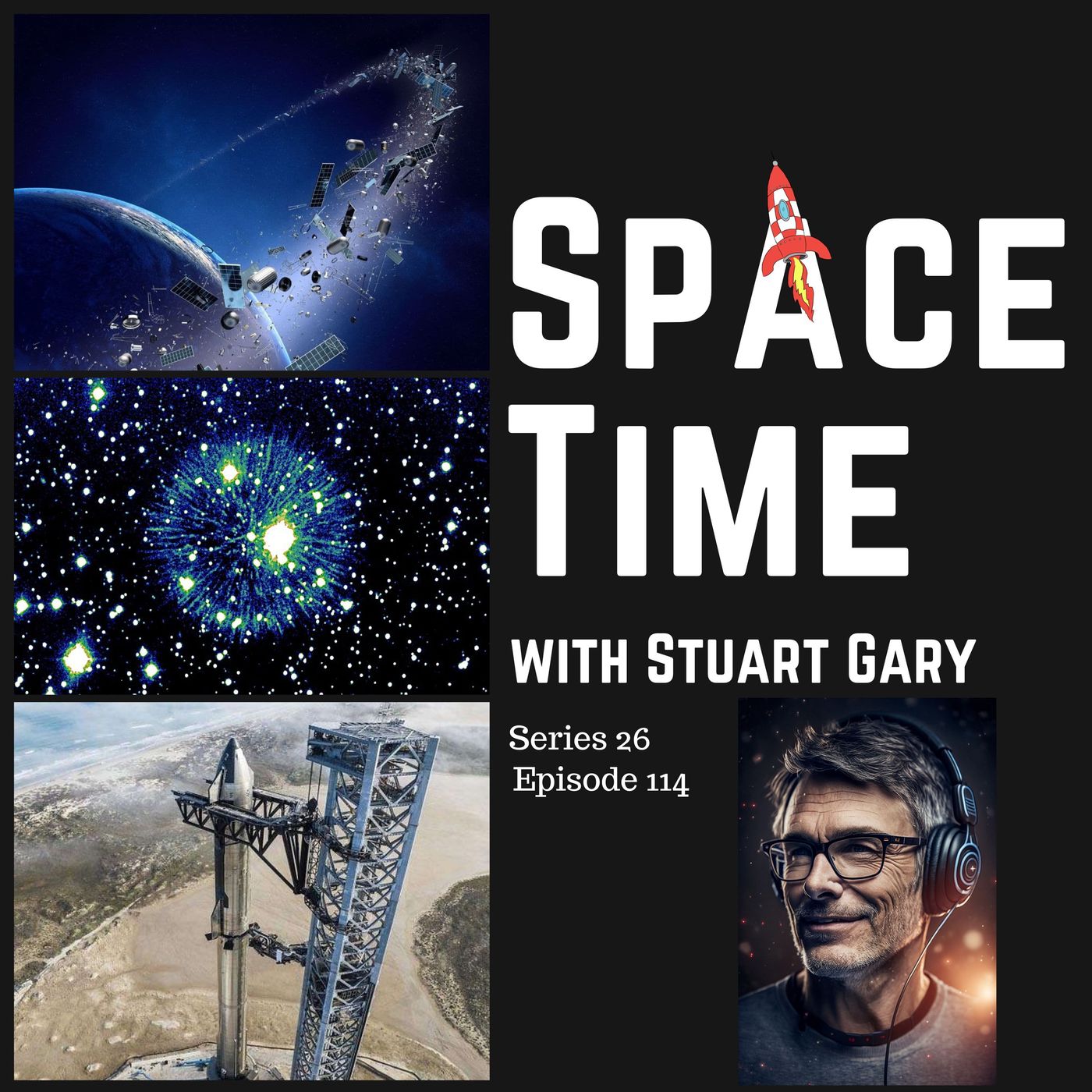
SpaceTime with Stuart GaryOrbital Collisions, Unique Supernovas, and Starship's Return: SpaceTime S26E114This episode of SpaceTime is brought to by Incogni...protecting you and your data online. Use code STUARTGARY at the link below to get an exlusive 60% off an annual Incogni plan: https://incogni.com/stuartgary**SpaceTime with Stuart Gary - Series 26 Episode 114 Show Notes:** - **Orbital Satellite Collision:** Another satellite collision has occurred in space, adding to the growing concern of space debris and the looming threat of the Kessler syndrome. - **Mysterious White Dwarf Supernova:** Astronomers have discovered an extraordinary remnant from a supernova explosion observed in the Far East nearly 850 years ago, marking it as one...
2023-09-2230 min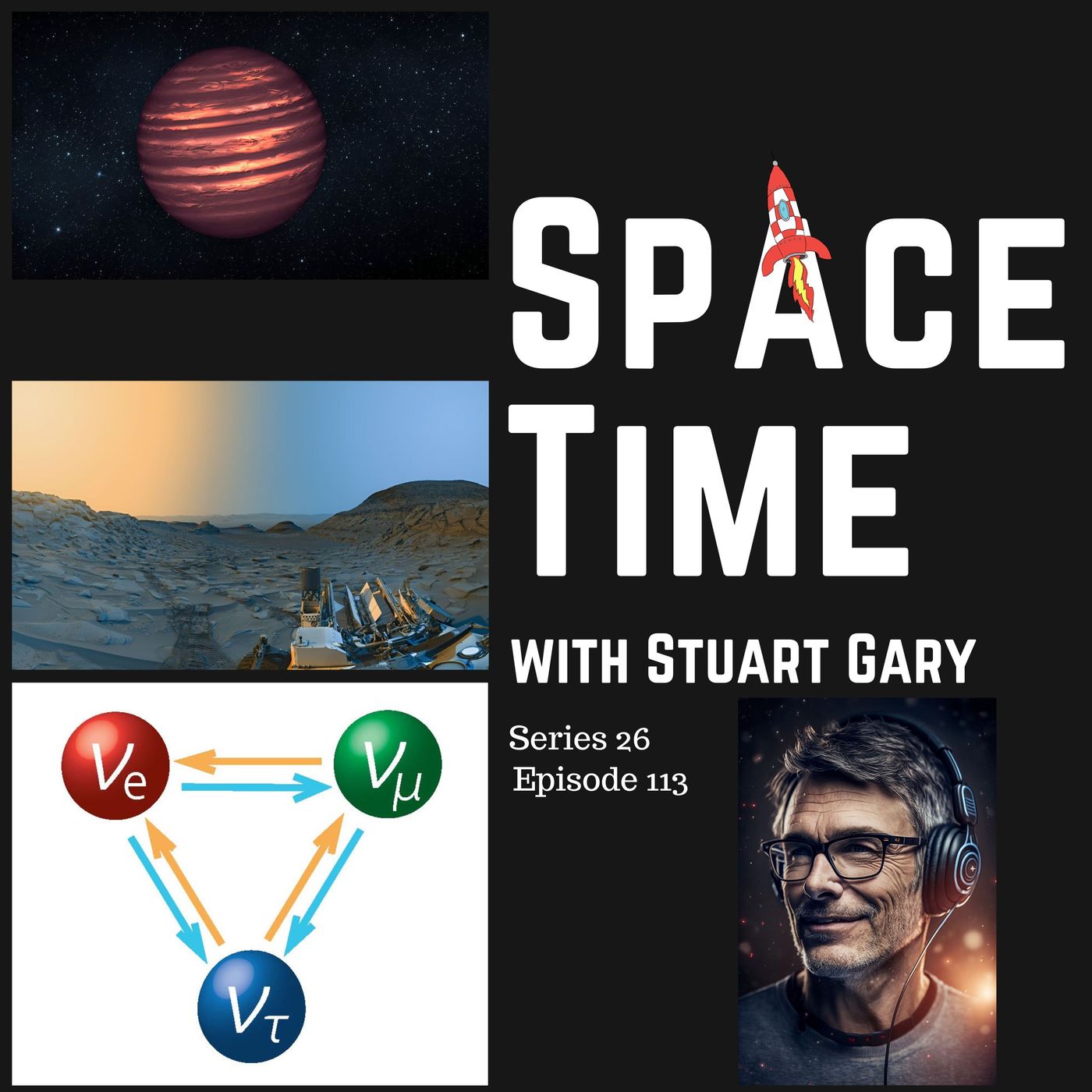
SpaceTime with Stuart GaryS26E113: Webb's Dwarfs, Mars' Mineral Mystery, and the Neutrino EnigmaThis episode of SpaceTime is brought to you with the help of Incogni - safeguarding your privacy online. To get a whopping 60% off your subscription as a SpaceTime listener, just visit www.incogni.com/stuartgarySpaceTime with Stuart Gary Series 26 Episode 113 Show Notes - **Webb Telescope's Local Discoveries**: NASA's James Webb space telescope, renowned for peering into the distant universe, has unveiled a closer mystery. Astronomers report the discovery of 21 intriguing brown dwarfs. - **Mars' Mineral Mystery**: Earth boasts nearly 6,000 known minerals. Yet, Mars, a planet with many Earth-like qualities, has revealed only 161 minerals in over half a...
2023-09-2033 min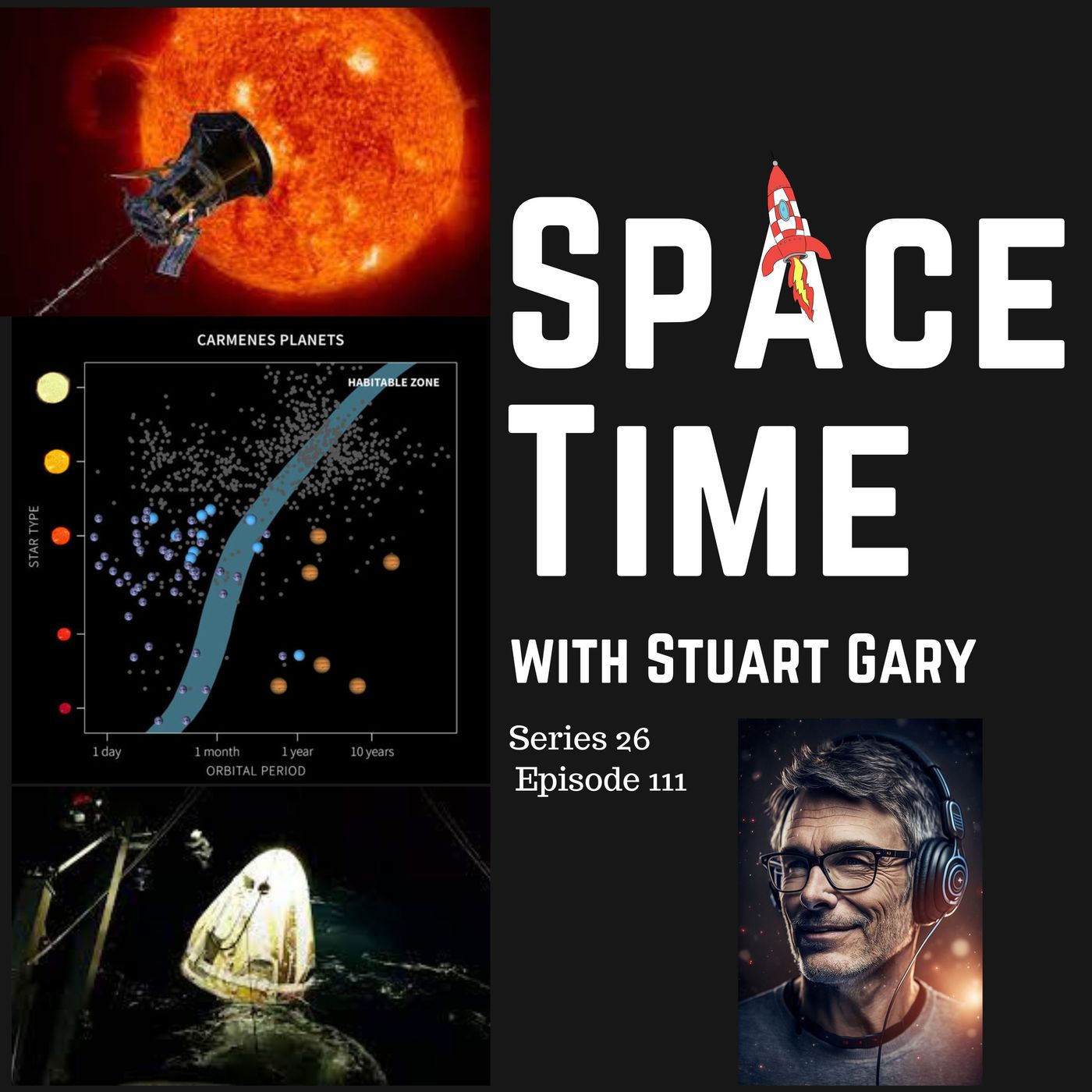
SpaceTime with Stuart GaryS26E111: Space Probes, New Planets, and Mysteries of Mind & Matter: A Galactic Dive**SpaceTime with Stuart Gary Series 26 Episode 111 Show Notes** 1. **Parker Solar Probe's Venus Flyby:** Dive into the details of the Parker Solar Probe's recent gravity-assist flyby of Venus. This maneuver has propelled the spacecraft into a series of record-setting flights around the Sun commencing this month. 2. **Discovery of 50 New Exoplanets:** Astronomers have unveiled a significant discovery! Explore the treasure trove of 50 new exoplanets located in our galactic neighborhood. These celestial bodies orbit stars distinct from our Sun. 3. **NASA's SpaceX Crew-6 Safe Return:** After an impressive 186 days in orbit, NASA's SpaceX Crew-6 has made a triumphant return. Learn about their safe splashdown...
2023-09-1526 min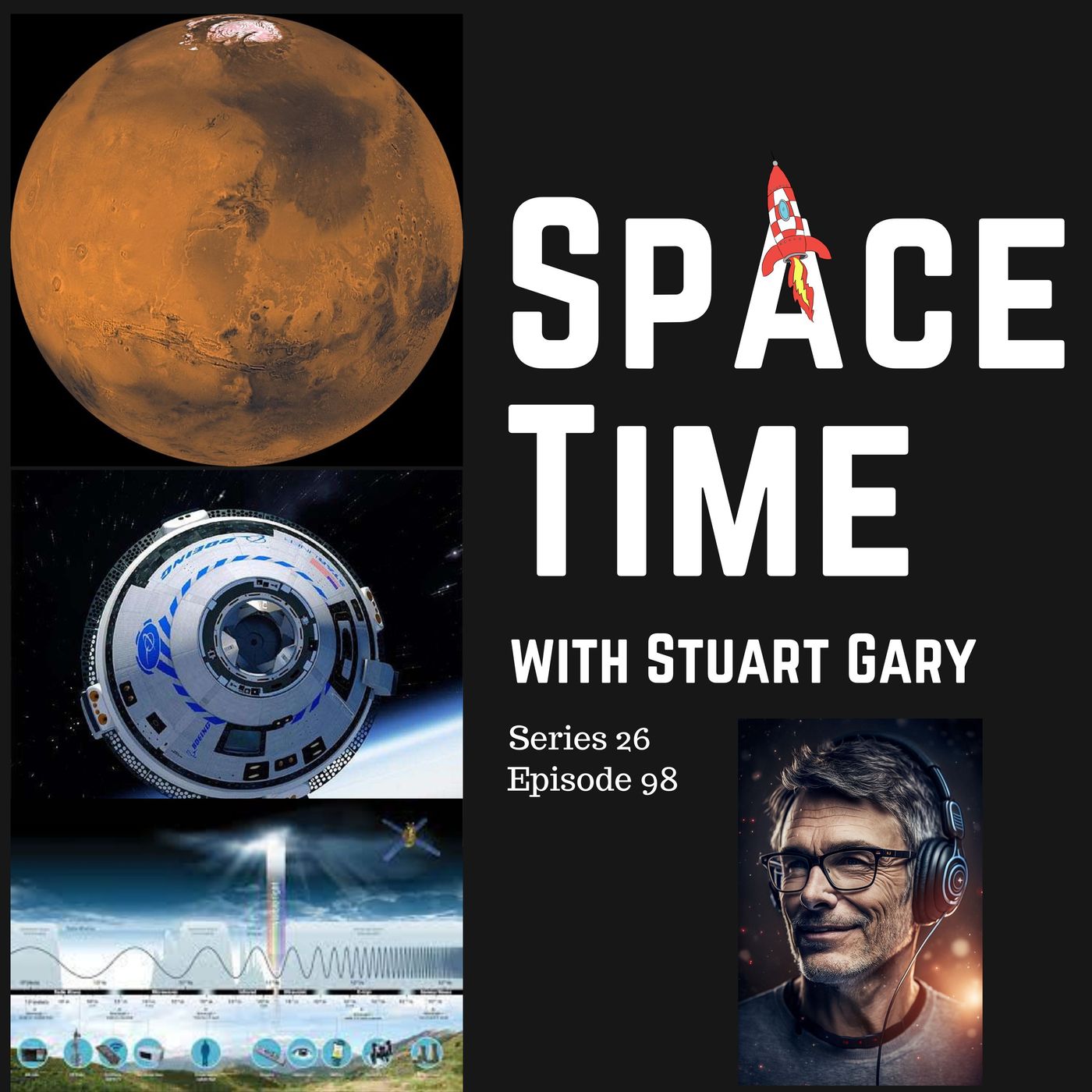
SpaceTime with Stuart GaryS26E98: Mars Ingenuity's Comeback, Starliner Delays, and Deep Space DiscoveriesThis episode of SpaceTime is brought to you with the support of NordVPN. To check out the special SpaceTime deal Stuart talks about, just visit www.nordvpn.com/stuartgary and help support the show. You can also find link details on the SpaceTime website.**Mars Ingenuity Back in Action**: After an unexpected landing last month, NASA's Mars Ingenuity helicopter is once again soaring the Martian skies.**Boeing's Starliner Setbacks**: The launch of Boeing's CST-100 Starliner to the International Space Station faces further delays, with crewed flights postponed until at least March 2024.**Deep Space Network's...
2023-08-1631 min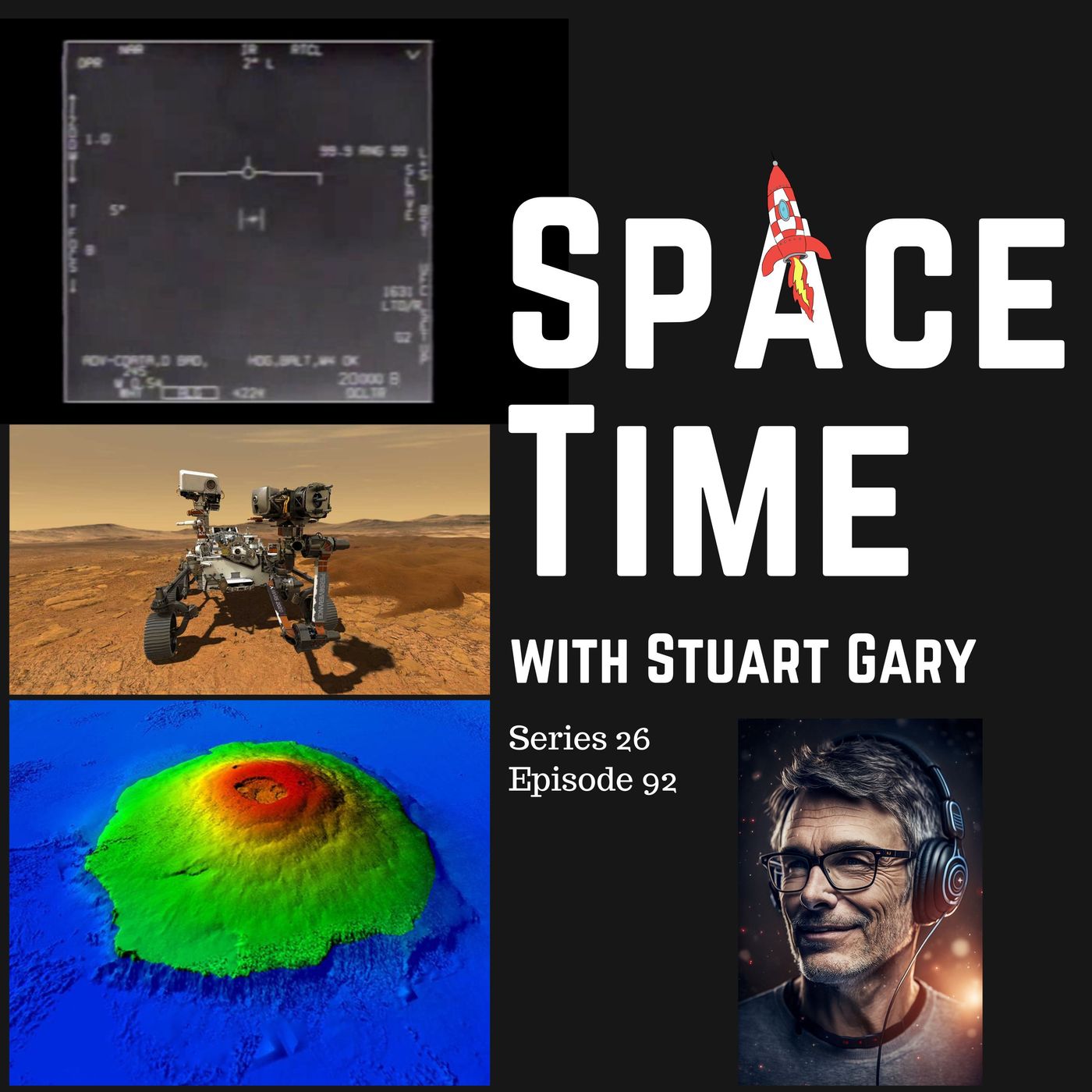
SpaceTime with Stuart GaryS26E92: Unidentified Flying Anomalies // Martian Organics // Olympus MonsIn this exciting episode of SpaceTime with Stuart Gary, we delve into the latest groundbreaking discoveries and revelations in the world of space and science. First, we explore the long-dismissed realm of Unidentified Anomalous Phenomena, as the United States Congress holds historic hearings on the matter. Senior military and intelligence officials testify to having collected crashed remains of unidentified flying objects and non-human bodies, challenging the conventional notions surrounding these enigmatic encounters. Next, we uncover astonishing evidence from a new study that has detected a wide array of organic molecules on the Martian surface, fueling the ongoing quest for signs...
2023-08-0230 min
SpaceTime with Stuart GaryStellar Enigma Unveiled: Two-Faced Star & Ancient Asteroid Secrets | NASA's Psyche Mission and More!SpaceTime with Stuart Gary S26E89Two-faced star exposed: Astronomers make an intriguing discovery of a unique two-faced white dwarf star. The star's unusual characteristics pose interesting questions for astronomers and astrophysicists. 2. NASA's Psyche Mission update: As the launch date of October 5th approaches, engineers and technicians at Cape Canaveral are diligently preparing the NASA Psyche spacecraft for its upcoming mission. The podcast explores the significance of this mission and its objectives. 3. Pre-solar silicate grains in Ryugu samples: Scientists have made a groundbreaking discovery of ancient silicate grains within samples of the asteroid Ryugu. These grains predate the solar...
2023-07-2626 min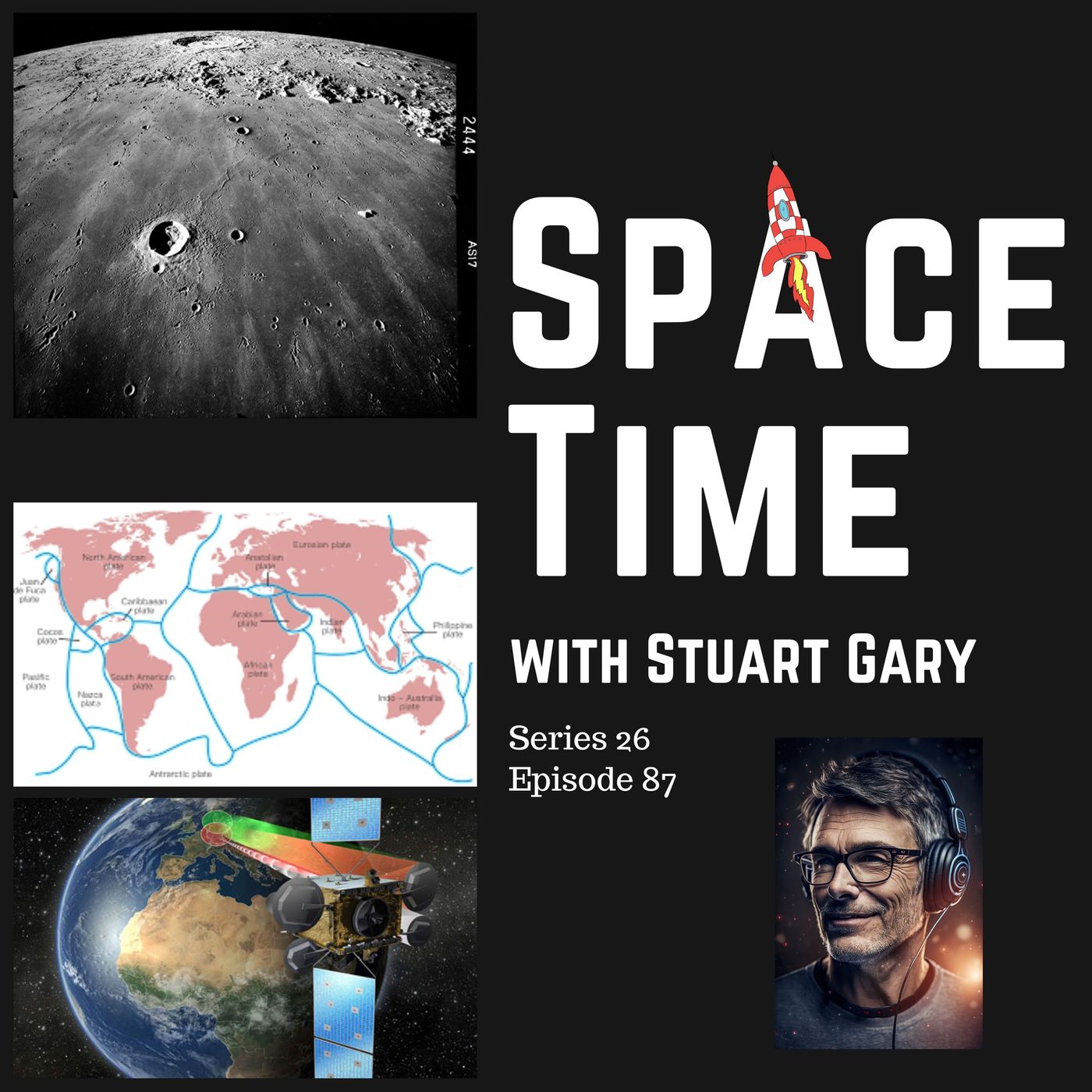
SpaceTime with Stuart GaryRevisiting Moon's Age, Earth's Tectonics & Ariane 5's Farewell | S26E87In the engaging 87th episode of SpaceTime Series 26 with Stuart Gary, journey through intriguing celestial and terrestrial revelations. Discover the 'Man in the Moon' as we uncover its ancient secrets, revealing that its famed surface is approximately 200 million years older than previously believed. The episode also dives into Earth's early history, examining new evidence that suggests plate tectonics and subduction began around 3.8 billion years ago. As we bid farewell to the venerable Ariane 5, join us in reliving its last flight, a successful mission carrying two telecommunications satellites. In our compelling Science Report, explore how our oceans' hues have been turning...
2023-07-2121 min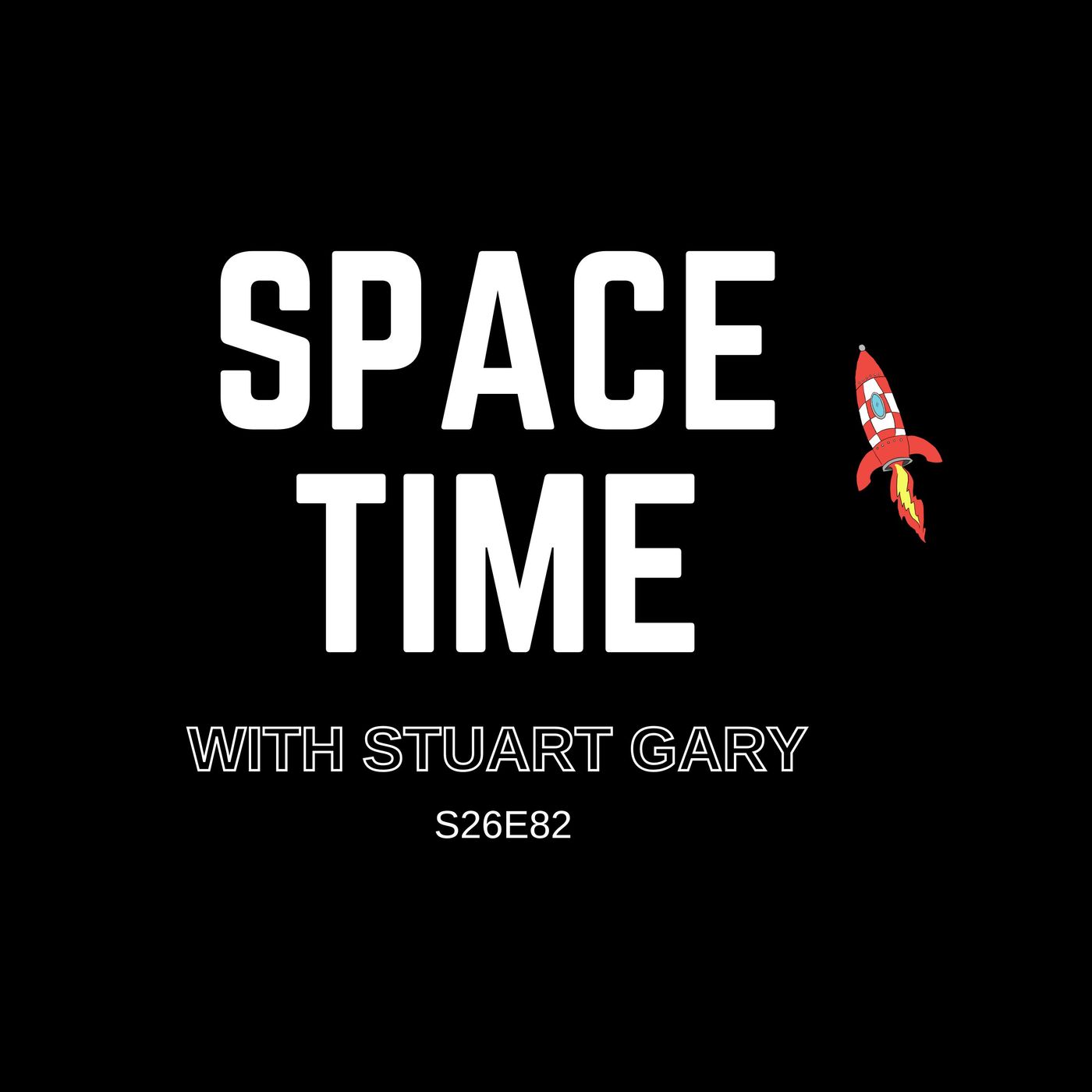
SpaceTime with Stuart GaryS26E82: Unveiling the Impossible: Space Secrets and Science AdvancesWelcome to episode 82 of the 26th series of SpaceTime with Stuart Gary. In this episode, we delve into the surprising discoveries, alarming incidents, and intriguing developments in the world of astronomy and space science. Here's a sneak peek: ### 1. Discovery of the Impossible Planet In an unbelievable discovery, astronomers have unearthed the existence of a planet that, against all odds, is alive and kicking. Located at a distance of 520 light-years from us, this celestial object, 8 Ursae Minoris b, is in orbit around a red giant star - a star that should have devoured it long ago. ### 2. Sun's Powerful Solar Flare Our...
2023-07-1031 min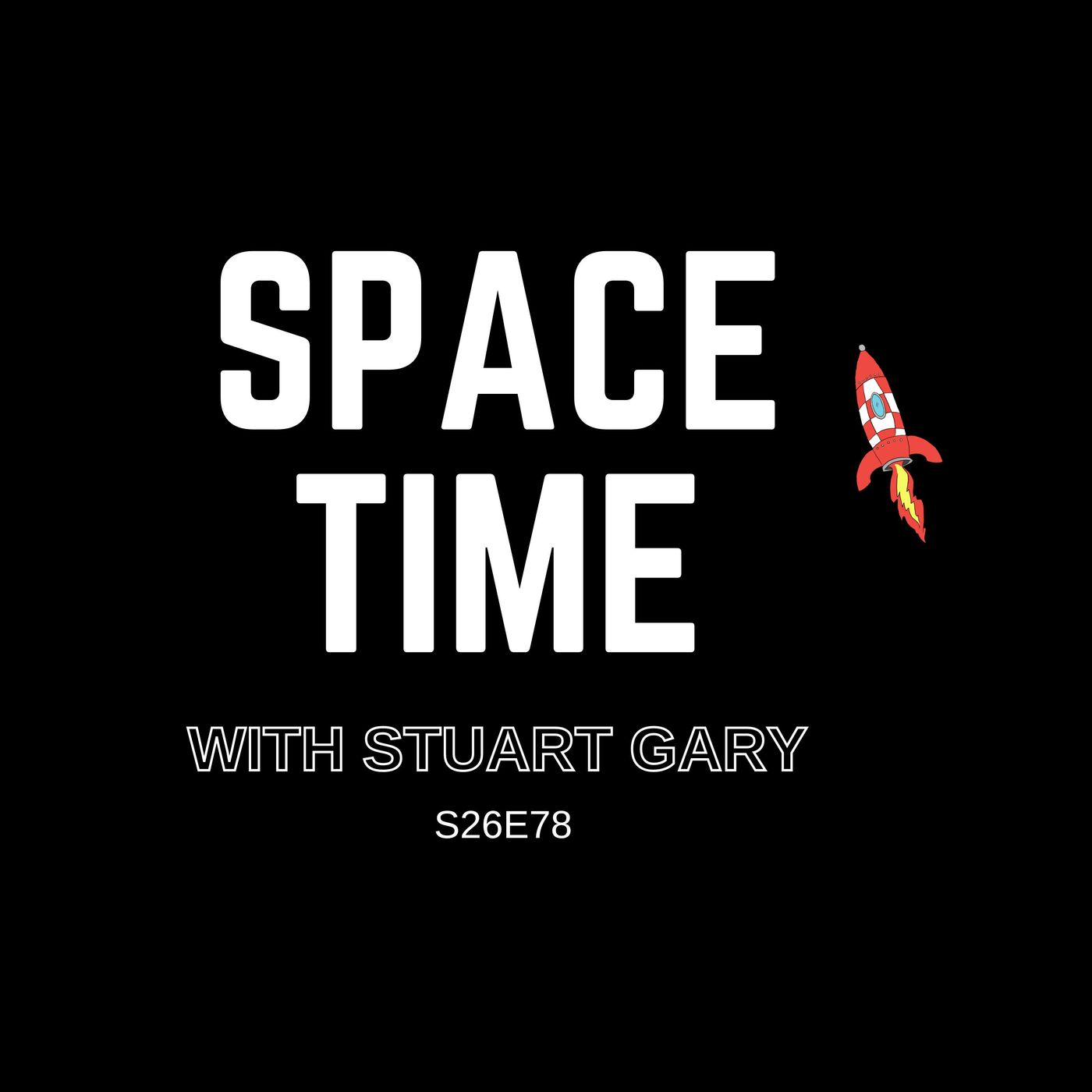
SpaceTime with Stuart GaryS26E78: Life's Building Blocks in Deep Space // NASA Upgrades // Rocket Lab's Cyclone SatellitesS26E78 of SpaceTime with Stuart Gary brings exciting discoveries and advancements in the realm of space and science. In a groundbreaking revelation, astronomers have found tryptophan, one of the essential amino acids for life, in the depths of interstellar space. This finding provides intriguing insights into the potential origins of life beyond our planet. Meanwhile, NASA's Deep Space Network is undergoing significant upgrades, allowing for enhanced communication with a greater number of spacecraft and adapting to evolving mission requirements.Rocket Lab has achieved another successful launch, deploying a constellation of satellites dedicated to monitoring tropical cyclones for NASA...
2023-06-3025 min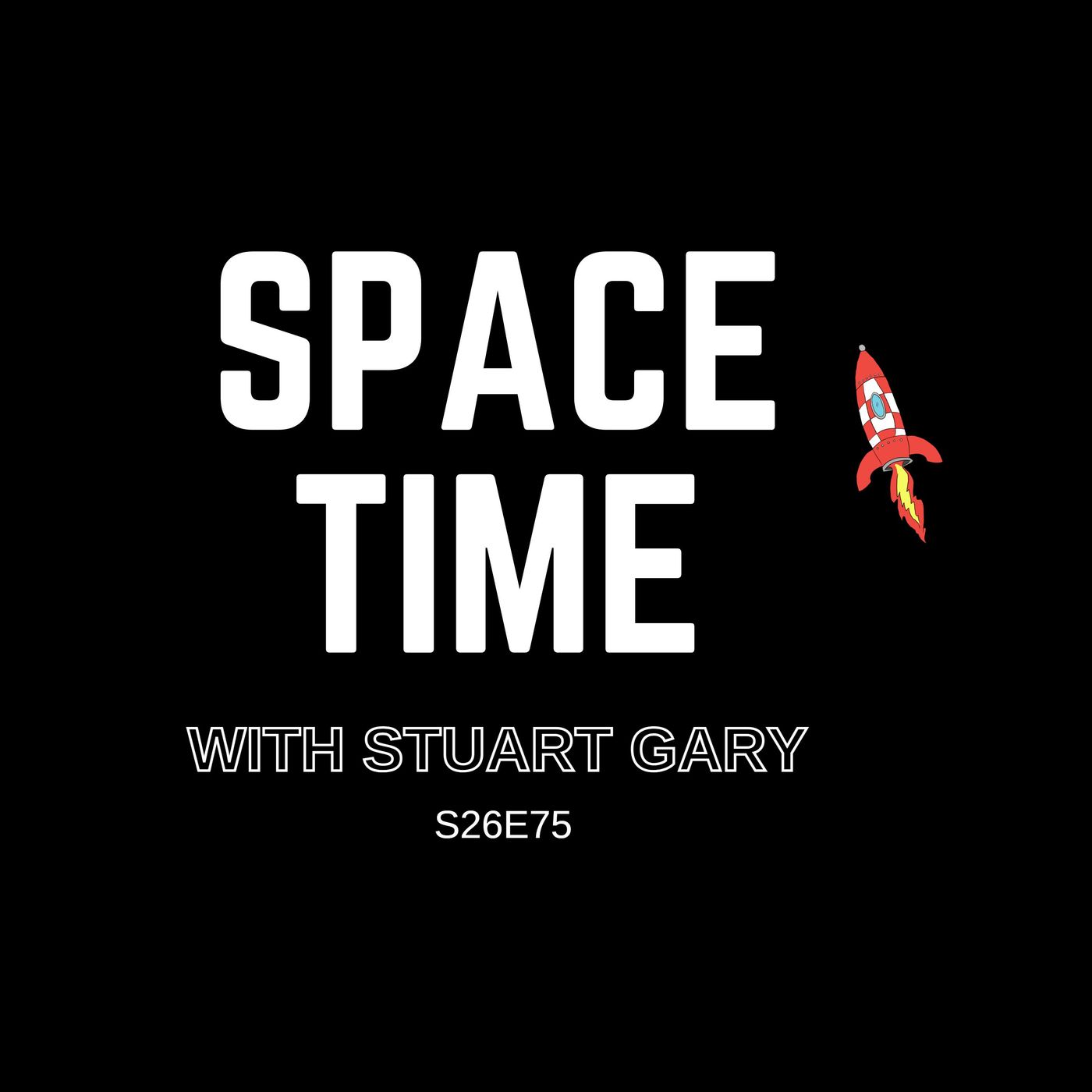
SpaceTime with Stuart GaryS26E75: Exploring Earth's Origins // Matter-Antimatter Asymmetry // Satellite Woes, and More!Join Stuart Gary in this episode of SpaceTime as he unveils intriguing discoveries and controversies from the world of science. Discover how an asteroid's surprising composition of Sodium chloride, commonly known as table salt, provides clues about the origin of Earth's water. Delve into the mind-boggling matter-antimatter asymmetry conundrum, as the CERN atom smasher refines measurements, challenging our understanding of the universe's creation. Astronomers express outrage over a new super-bright satellite, highlighting the detrimental effects on crucial scientific research caused by the increasing presence of satellites in Earth's orbit. In the Science Report, learn about the correlation between intelligence and...
2023-06-2328 min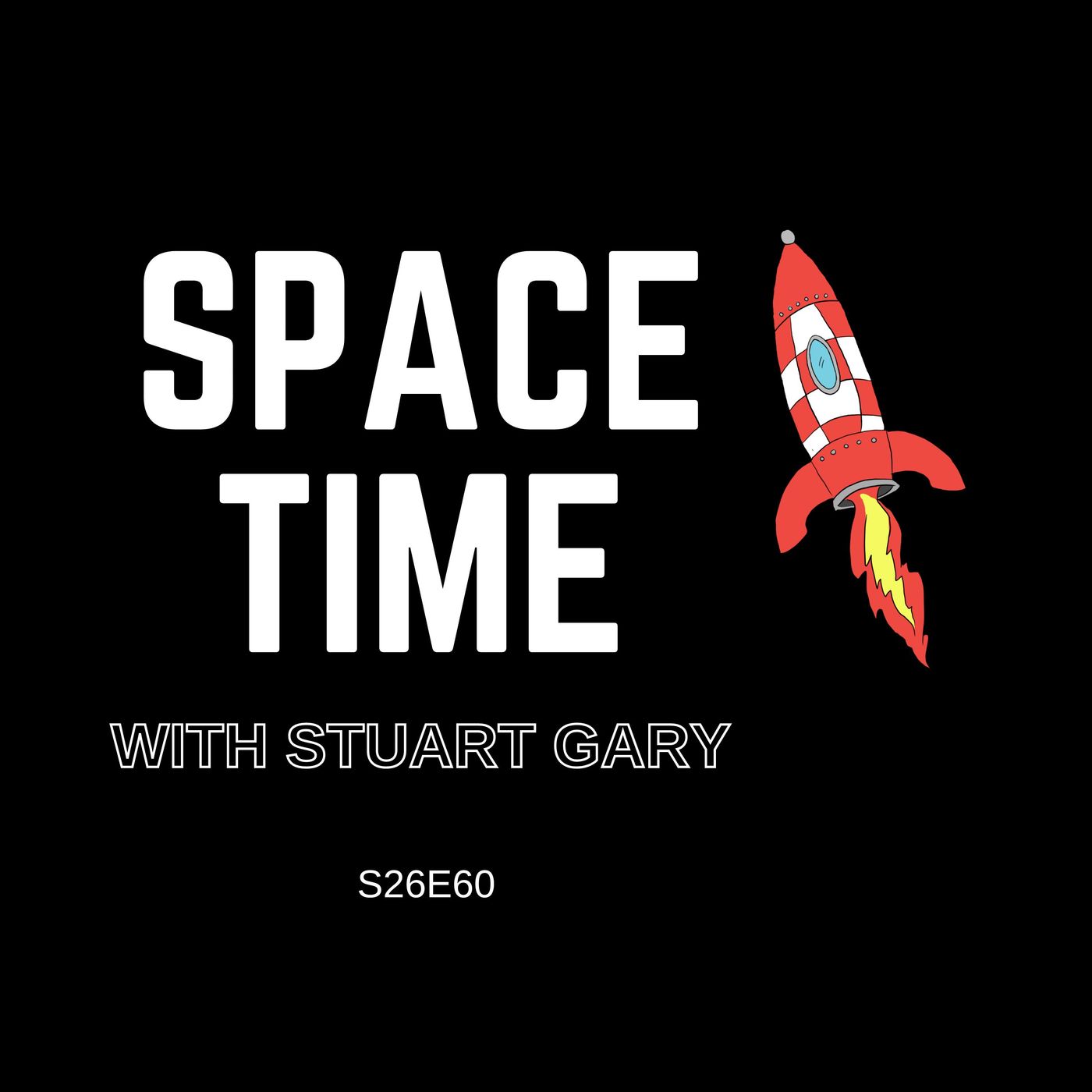
SpaceTime with Stuart GarySimulating Black Hole Jets // NASA's Storm Chaser Satellites // Virgin Galactic's Space Flights ResumedS26E60: In this episode of SpaceTime with Stuart Gary, we explore the fascinating world of astrophysics and space exploration.Astronomers have used powerful supercomputer simulations to accurately recreate the mesmerizing jets emanating from supermassive black holes. Additionally, Rocket Lab successfully launched NASA's new storm-chasing satellites, while Virgin Galactic announces the resumption of flights to the edge of space. Segment 1: Recreating Black Hole Jets Using Supercomputer Simulations Astrophysicists have harnessed the power of supercomputer simulations to replicate the awe-inspiring jets that emanate from supermassive black holes. By accurately recreating these cosmic phenomena, scientists gain valuable insights into the...
2023-05-1938 min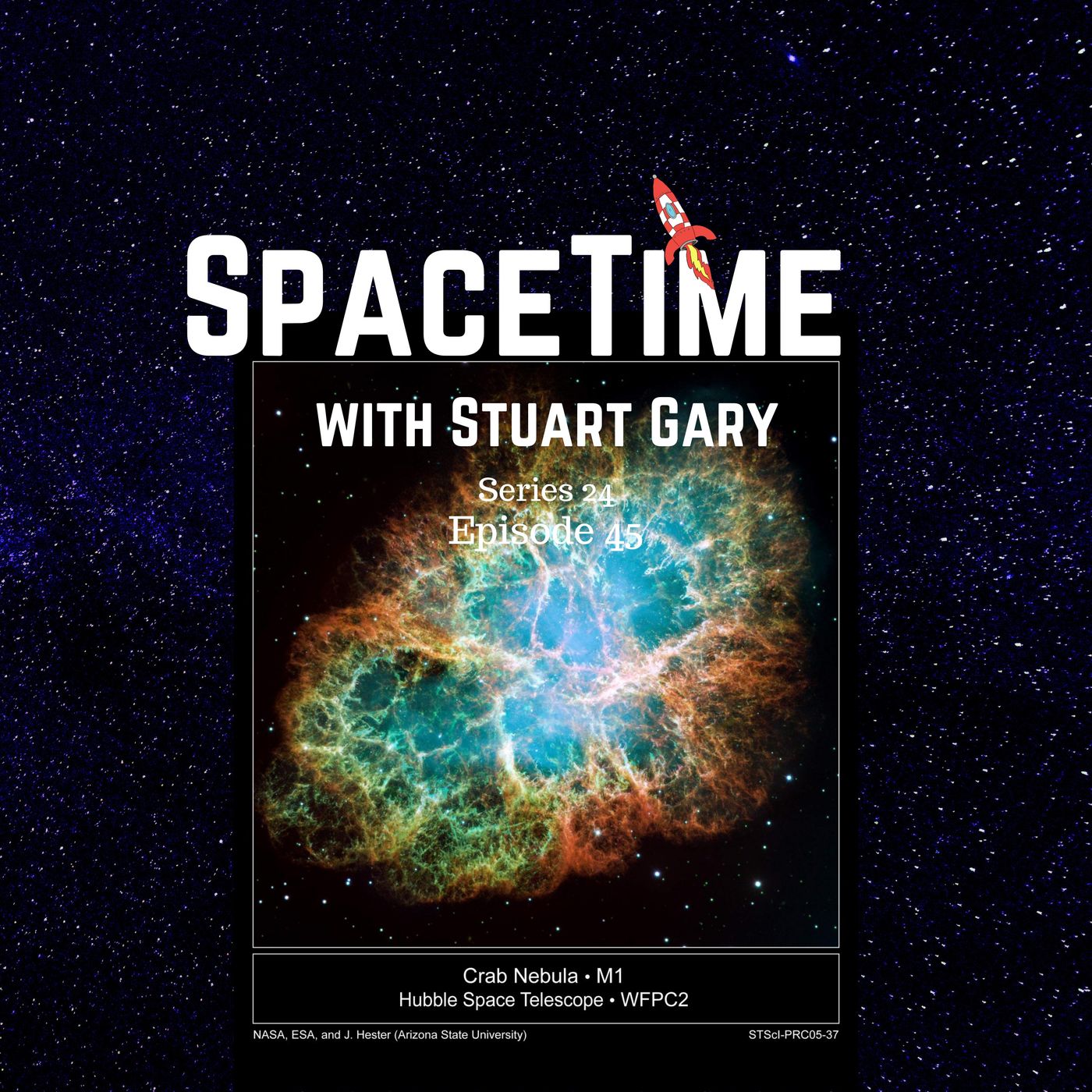
SpaceTime with Stuart GaryX-Ray Blasts Discovered Being Emitted by the Crab PulsarThe Astronomy, Technology and Space Science News Podcast.SpaceTime with Stuart Gary Series 24 Episode 45*X-ray blasts discovered being emitted by the crab pulsarAstronomers studying the pulsar at the heart of the famous crab nebula have discovered blasts of X-ray are being emitted when the pulsar experiences a sudden glitch called a giant radio pulses.*How much extraterrestrial dust falls on Earth each yearA new study has calculated that some 5200 tonnes of space dust falls on to the Earth every year.*China’s latest top secret rocket launchChina has launched another cl...
2021-04-2320 min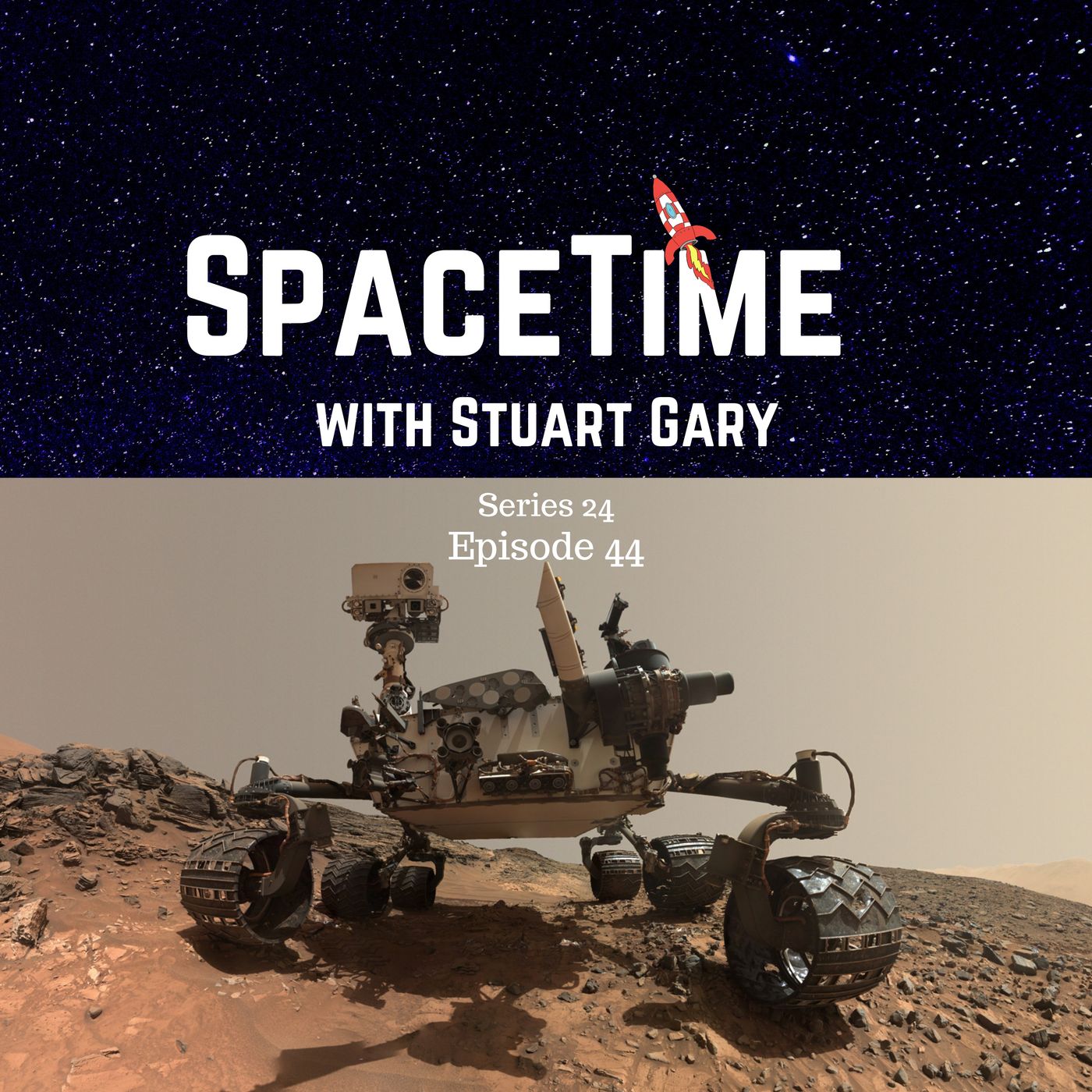
SpaceTime with Stuart GaryMars Did Not Dry Up All at OnceThe Astronomy, Technology and Space Science News Podcast.SpaceTime with Stuart Gary Series 24 Episode 44*Mars did not dry up all at onceA new study shows that Mars didn’t lose its water all at once, but over a series of wetter and dryer periods ending about three billion years ago.*Space junk conferenceThe European Space Agency is currently hosting the 8th European Conference on Space Debris in Darmstadt, Germany.*Starlink 24 launchSpaceX has launched its 24th Starlink mission carrying 60 more broadband satellites into orbit. *The Science ReportStudies confirm kid...
2021-04-2129 min
SpaceTime with Stuart GarySpace HurricaneThe Astronomy, Technology and Space Science News Podcast.SpaceTime with Stuart Gary Series 24 Episode 25*Astronomers discover a space hurricane for the first timeAstronomers have discovered what they’re calling a space hurricane high up in the Earth’s upper atmosphere.*Space Machines Company signs its first customerSpace Machines Company has secured a contract for its new Optimus 1 orbital transfer unit.*SpaceX’s spectacular starship explosion after a successful flight testThe SpaceX SN10 Starship prototype test article has exploded in a spectacular orange fireball less than ten minutes after completing a succes...
2021-03-1031 min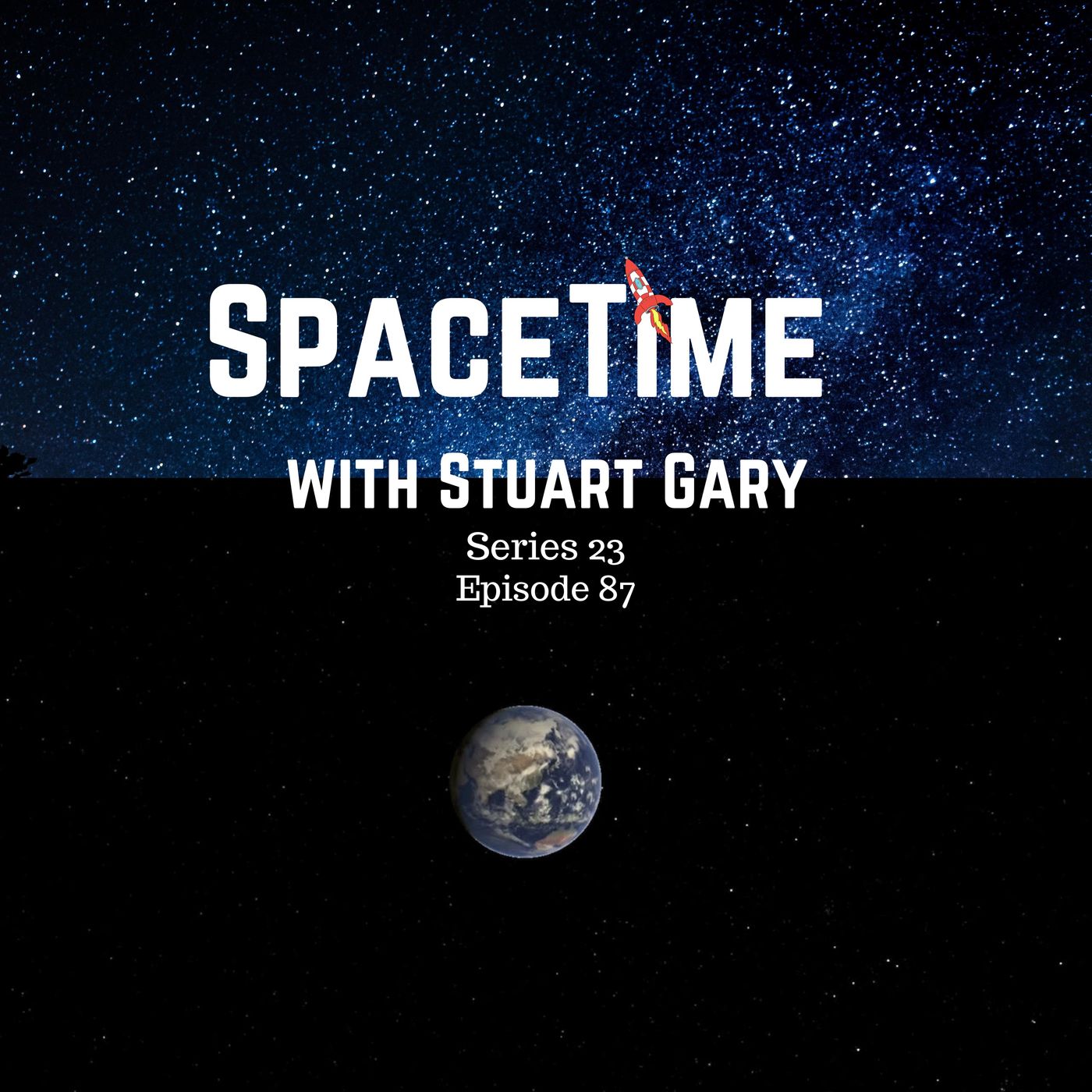
SpaceTime with Stuart GaryA Close Call for Planet Earth*New record for a close call for planet Earth with an asteroidPlanet Earth’s just had another close call with an asteroid the size of a small truck narrowly missing the planet.*The ultimate rave data set releasedSome call it the ultimate rave – the release of the sixth and final data set from the RAdial Velocity Experiment or RAVE -- the largest systematic spectroscopic survey of motions of star in the Milky Way galaxy.*Ariane 5 launches another satellite mission extension vehicleArianespace has launched a mission extension vehicle and two new telecommunications satellites into...
2020-08-2626 min
SpaceTime with Stuart GaryDangerous Alien Life Warning*New study warns that alien life would be dangerous to EarthlingsDiscovery that alien peptides containing two amino acids commonly found in carbonaceous meteorites would pose a serious threat to human health.*NASA looking at a new mission to VenusThe proposed mission named VERITAS would transform sciences understanding of the internal geodynamics that shaped Earth’s sister planet Venus.*The Kremlin tests its new anti-satellite weaponMoscow has conducted a space-based anti-satellite weapons test-firing a projectile from its Cosmos 2543 satellite.*China growing eyes in the skyChina has launched another high-resolution surveillance sa...
2020-08-1923 min
SpaceTime with Stuart GaryA Neutron Star at the Heart of Supernova 1987A*A neutron star at the heart of supernova 1987AThere’s growing evidence that a neutron star was created from the explosion of supernova 1987A*SpaceX Dragon completes its first mission carrying crew to the space stationThe first-ever privately operated manned orbital space flight has returned safely to Earth.*Stunning early morning Proton launchA Proton rocket has transported two new telecommunications satellites into space in a spectacular nighttime launch.*August SkywatchThe annual Perseids meteor shower is among the highlights of the night skies of August. For more SpaceTime vis...
2020-08-1436 min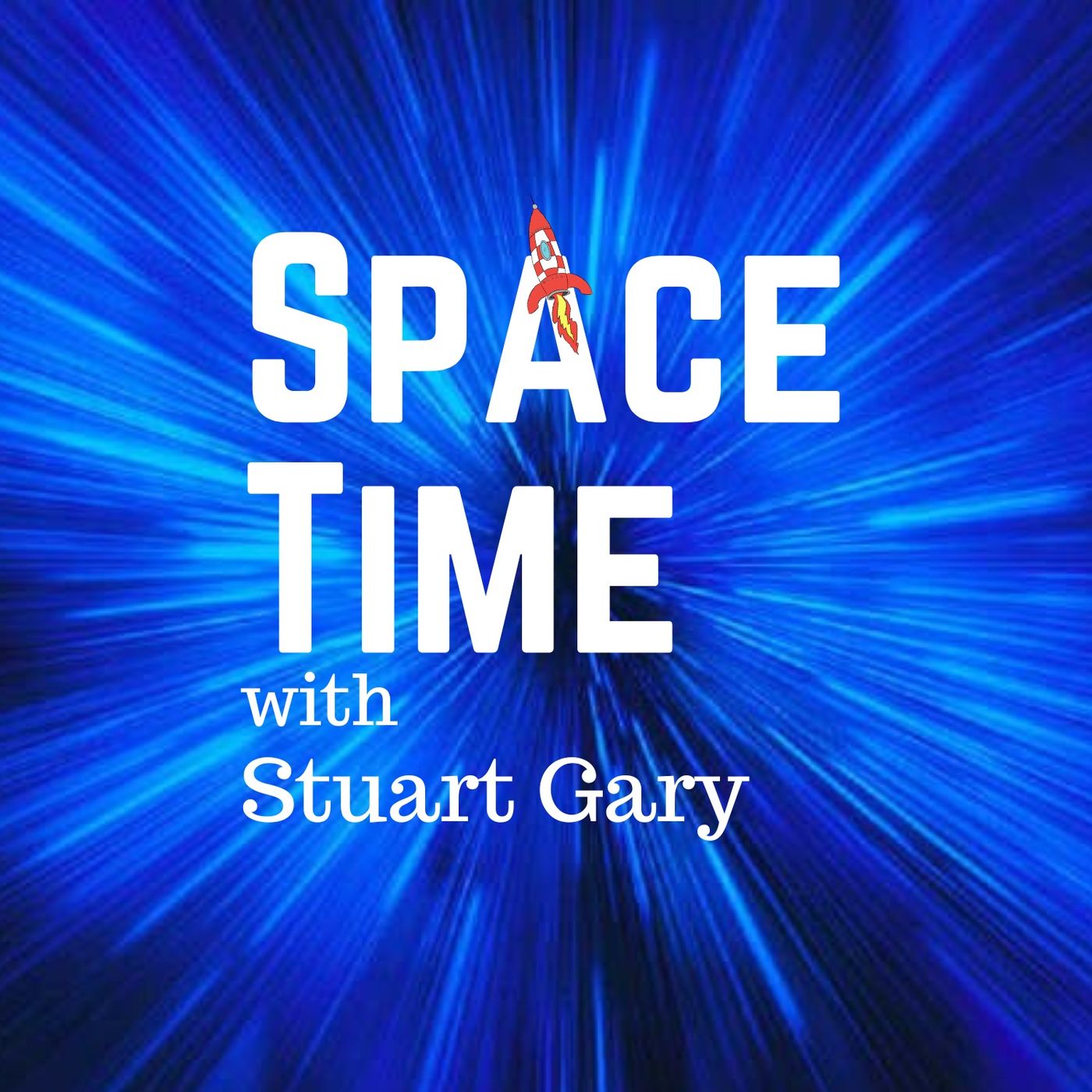
SpaceTime with Stuart GaryDiscovery of a Mysterious Ancient Stellar ClusterSpaceTime with Stuart Gary Series 23 Episode 80*Discovery of a mysterious ancient stellar clusterAstronomers have discovered the shredded remains of an ancient globular star cluster that was torn apart by our own Milky Way galaxy more than two billion years ago.*NASA launches the most sophisticated ever mission to MarsAfter more than a decade of preparation NASA's Mars 2020 Perseverance rover mission has finally blasted off on its way to the Red Planet to search for signs of alien life.*Mars sample return missionESA has contracted Airbus to build an Earth Return Orbiter...
2020-08-1043 min
SpaceTime with Stuart GaryHayabusa-2 Asteroid Sample Return Capsule to Land in AustraliaSpaceTime with Stuart Gary Series 23 Episode 78*Hayabusa-2 asteroid sample return capsule to land in AustraliaThe Australian Space Agency confirms Japan’s Hayabusa 2 asteroid sample return capsule will land in the Woomera Rocket Range in outback South Australia on December the 6th.*NASA’s James Webb Space Telescope set to fly on October 31st 2021After decades of development NASA's James Webb space telescope has completed one of its final ground tests before next year’s launch.https://spacetimewithstuartgary.tumblr.com/post/624156206518419456 *Deep Sky imagingWe often talk about the spectacular panoramic vista provided by the...
2020-07-3129 min
SpaceTime with Stuart GaryStunning First Images by Solar OrbiterSpaceTime with Stuart Gary Series 23 Episode 77*Stunning first images of the Sun sent back by Solar OrbiterThe European Space Agency’s Solar Orbiter has sent back its first stunning close-up images of the Sun revealing miniature omnipresent solar flares – which have been named campfires.https://spacetimewithstuartgary.tumblr.com/post/624157305271992320 https://spacetimewithstuartgary.tumblr.com/post/624157540277764096 https://spacetimewithstuartgary.tumblr.com/post/624157878096429057 *Venus showing signs of being volcanically activeA new study has identified 37 recently active volcanic structures on Venus.*All systems go for the first helicopter flight on another planetWhen NASA's Mars 20...
2020-07-2840 min
SpaceTime with Stuart GaryConstruction Starts on NASA’s Psyche SpacecraftSpaceTime with Stuart Gary Series 23 Episode 73*Construction starts on NASA’s Psyche spacecraftConstruction is now underway on NASA’s new spacecraft to explore the metal-rich main-belt asteroid 16 Psyche.*A new hypothesis to try to explain the Tunguska eventScientists have come up with a new explanation for the lack of debris from the Tunguska event – the largest asteroid impact with Earth in recent history.*Space station forced to change course because of space junkThe International Space Station has been forced to make an unscheduled course correction to avoid a possible collision with a piec...
2020-07-1731 min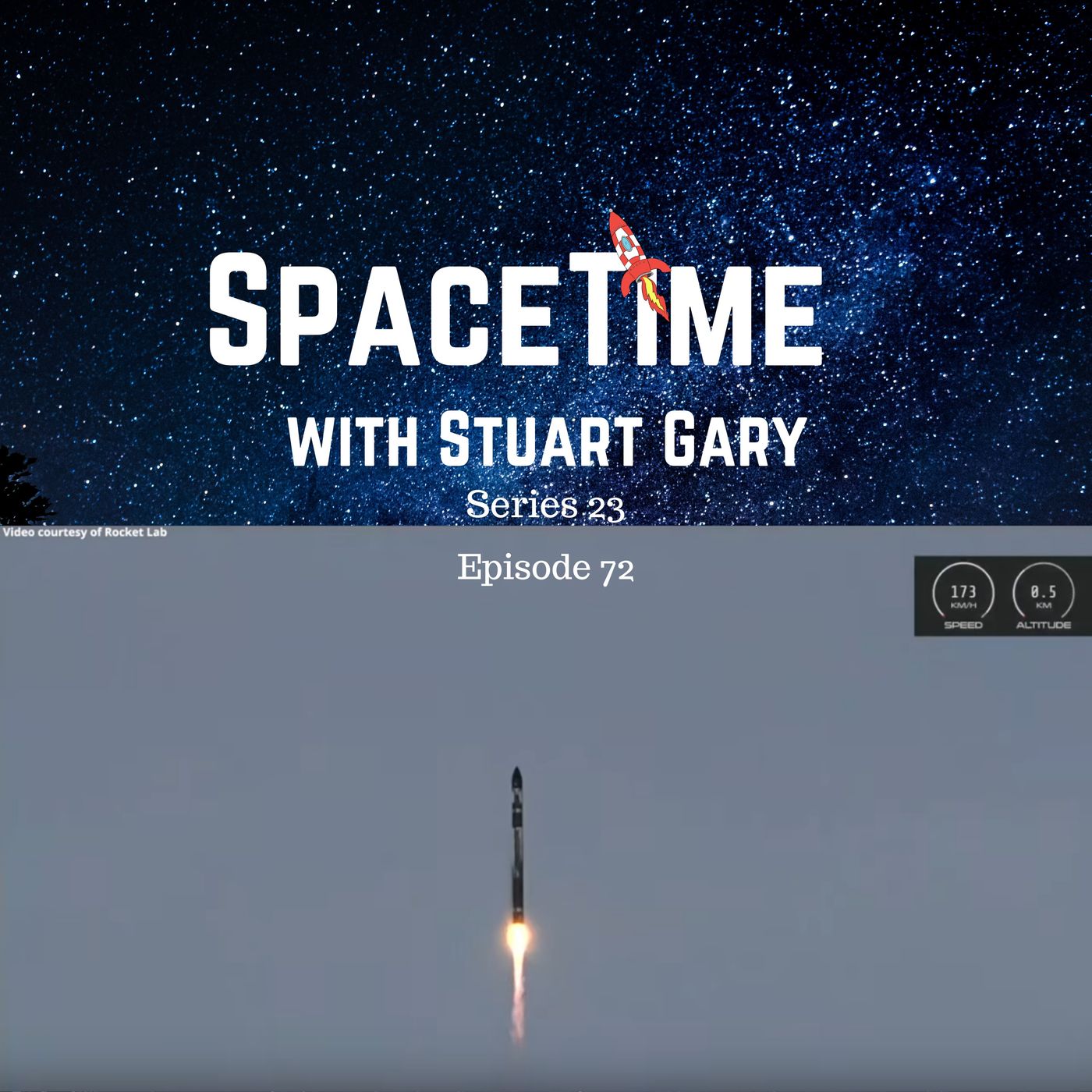
SpaceTime with Stuart GaryRocket Lab Failure*Rocket Lab fails on its latest missionA full accident investigation is now underway to determine what caused the failure of an Electron rocket during the second stage of its journey to orbit.*Strange galactic structure near the centre of the Milky WayAstronomers studying a strange unexplained structure known as the tilted disk located near the centre of the Milky Way galaxy.*Studying the red supergiant AntaresAstronomers have created the most detailed map yet of the red supergiant star Antares.*The Science ReportHeatwaves becoming hotter, longer, and more frequent, all...
2020-07-1523 min
SpaceTime with Stuart GaryAustralian Space Agency to Develop New-Generation Space Suits*Australian Space Agency to develop new-generation space suitsThe Australian Space Agency is working with NASA and the European Space Agency on a new generation of Space Suites for astronauts.*New type of subatomic particle discoveredScientists have discovered a new never before seen subatomic particle.The exotic particle is made up of four charm quarks*New space toilet – to go where no one has gone beforeNASA is seeking expressions of interest in developing a new lunar loo for its Artemis astronauts exploring the Moon.*July SkyWatchEarth reaches aphelion it’s mo...
2020-07-1040 min
SpaceTime with Stuart GaryDiscovery of a Cosmic Ring of Fire*Discovery of a cosmic ring of fireAstronomers have captured an image of a super-rare type of galaxy -- described as a “cosmic ring of fire”.https://spacetimewithstuartgary.tumblr.com/post/619166208183402496 *The black hole that generated lightAstronomers have for the first-time detected light coming from the merging of a pair of black holes. *A new name for an asteroid that’s about to be hit by a missileThe International Astronomical Union has approved an official name for a tiny asteroid moon set to become the first-ever target of an asteroid deflectio...
2020-07-0634 min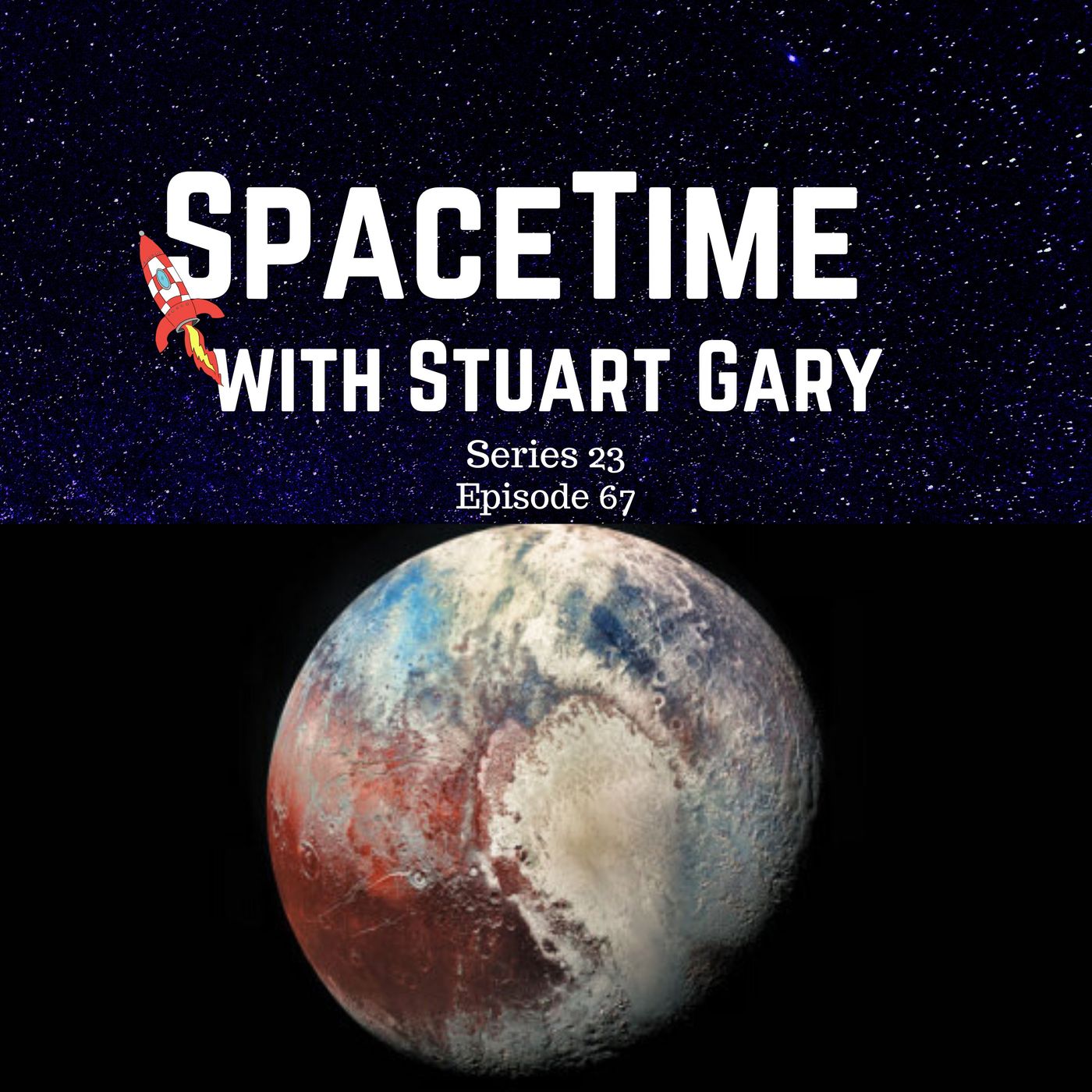
SpaceTime with Stuart GaryPluto’s Liquid Ocean*Pluto’s liquid oceanAstronomers say there’s growing evidence that Pluto and other large Kuiper belt objects started out with liquid oceans which have slowly frozen over. *NASA looking at a mission to NeptuneNASA is considering a mission to study the distant world of Triton -- one of the moons of the planet Neptune. *New study says there could be dozens of intelligent alien civilizations out there – or maybe notIt’s one of the ultimate questions -- Is there anyone out there – or are we alone in the universe? New guesstimates...
2020-07-0333 min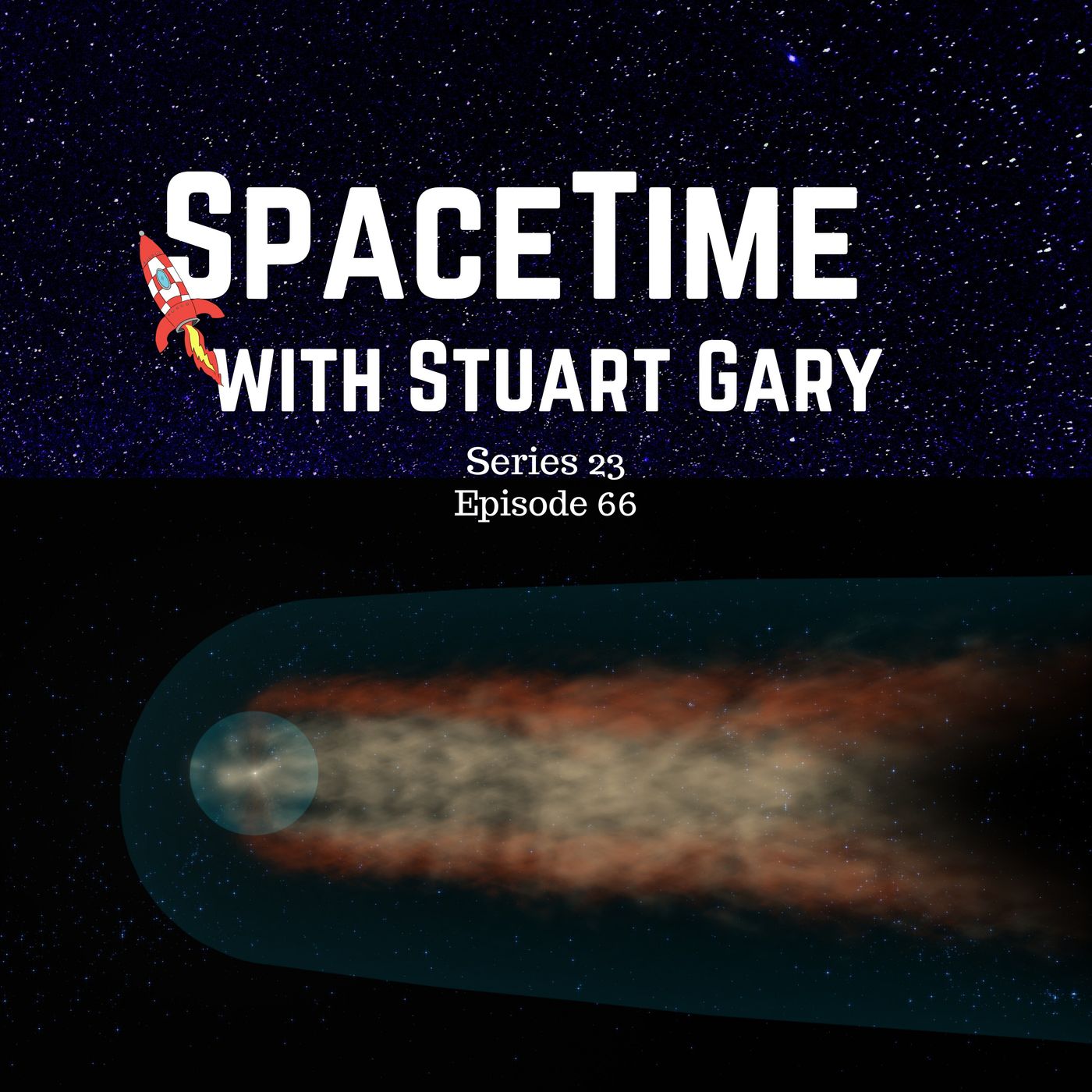
SpaceTime with Stuart GaryExploring the Mysteries at the Edge of the Solar System*Exploring the mysteries at the edge of the solar systemNASA’s IBEX spacecraft has confirmed the Sun’s heliosphere is shaped like a giant comet.https://spacetimewithstuartgary.tumblr.com/post/621539151474507776*The lifespan of NeutronsA new mission to Venus could finally determine the life span of the neutron.*ESA’s mission to study the Earth’s hydrological cycleThe European Space Agency Soil Moisture and Ocean Salinity or SMOS satellite has now been in orbit for more than a decade studying Earth’s water cycle and climate.*China completes its military satellite navigation...
2020-07-0126 min
SpaceTime with Stuart GaryAncient Milky Way Eruption Still Shines Bright*Ancient eruption at the heart of the Milky Way still shines bright millions of years laterAbout 3.5 million years ago, the supermassive black hole at the center of our Milky Way galaxy unleashed an enormous burst of energy, lighting up the surrounding space. *OSIRIS-Rex asteroid sample collection set for October 20NASA has set October 20 as the date when the OSIRIS-Rex spacecraft will manoeuvre down to the rugged boulder strewn surface of the asteroid Bennu and attempt to collect a sample of the ancient space rock for return to Earth. *Annular solar eclipse sweeps across Af...
2020-06-2926 min
SpaceTime with Stuart GaryNew Hints of Hypothetical Axion Particles*New hints of hypothetical axion particlesScientists from the international XENON collaboration has come up with some exciting results that just might be opening a new window on a hypothetical particle called the axion that’s been linked to dark matter. *Solar Orbiter makes first close approach to the SunESA’s Solar Orbiter spacecraft has undertaken its first close approach to the Sun reaching a comfortable 77 million kilometres from the visible solar surface. *NASA’s new water hunting Lunar roverNASA is developing a water seeking robotic lunar rover which could be explorin...
2020-06-2625 min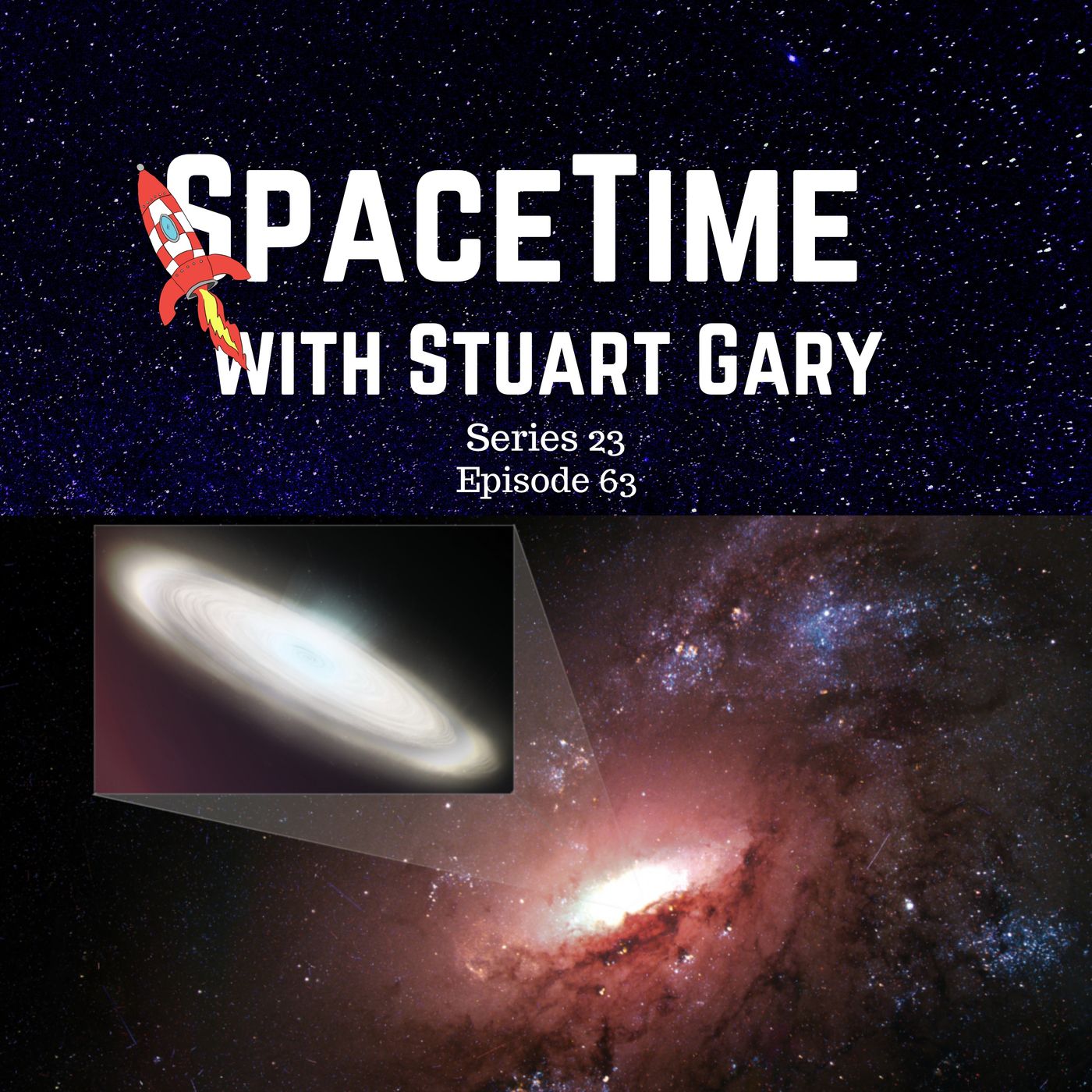
SpaceTime with Stuart GarySerious Questions Continue*Serious questions continue over sciences understanding of cosmic historyIt’s becoming increasingly clear that scientists will need to rethink their understanding of the fundamental history of the Universe. A new set of precision distance measurements reported in the Astrophysical Journal Letters have reinforced discrepancies in two competing values for the Hubble constant which describes the expansion rate of the universe. *Pilbara meteor lights up early morning outback skiesWell, despite what you may have heard elsewhere, the bright green fireball which streaked across the remote Pilbara skies last weekend was not space junk or the gian...
2020-06-2436 min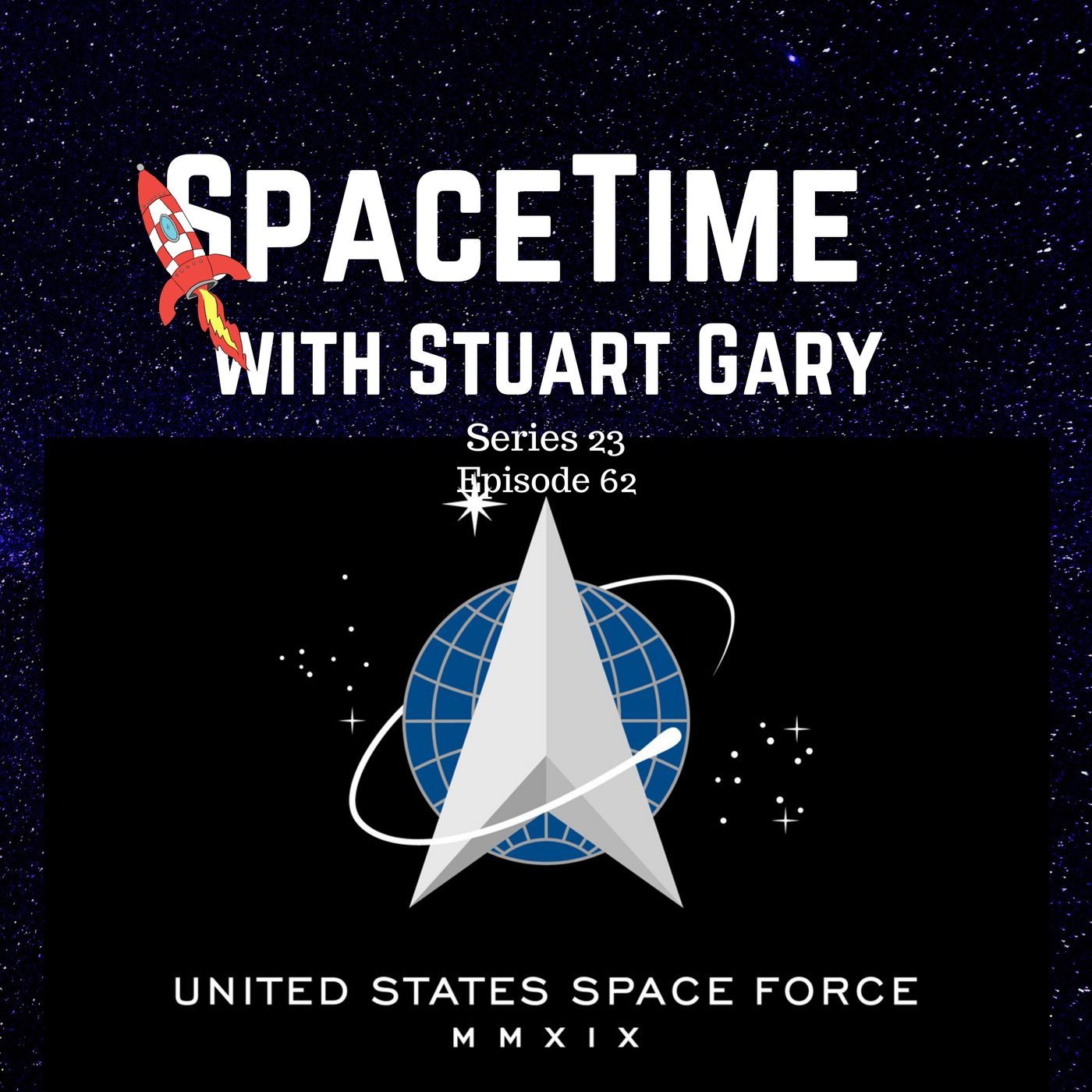
SpaceTime with Stuart GaryThe Need to Weaponize Space*The need to weaponize space The United States found the need to create a separate defence arm for the space warfare arena last year – in order to meet the growing threat posed by existing Russian and Chinese space forces which have already weaponized space. The new branch will defend American space assets including communications, navigation, Intelligence, Surveillance and Reconnaissance satellites. And with Australia having contributed significant funding towards some of these spacecraft, as well its on going ground support role – comes the obvious question -- should Australia have its own space force within the ADF. *Evidence of recent...
2020-06-2230 min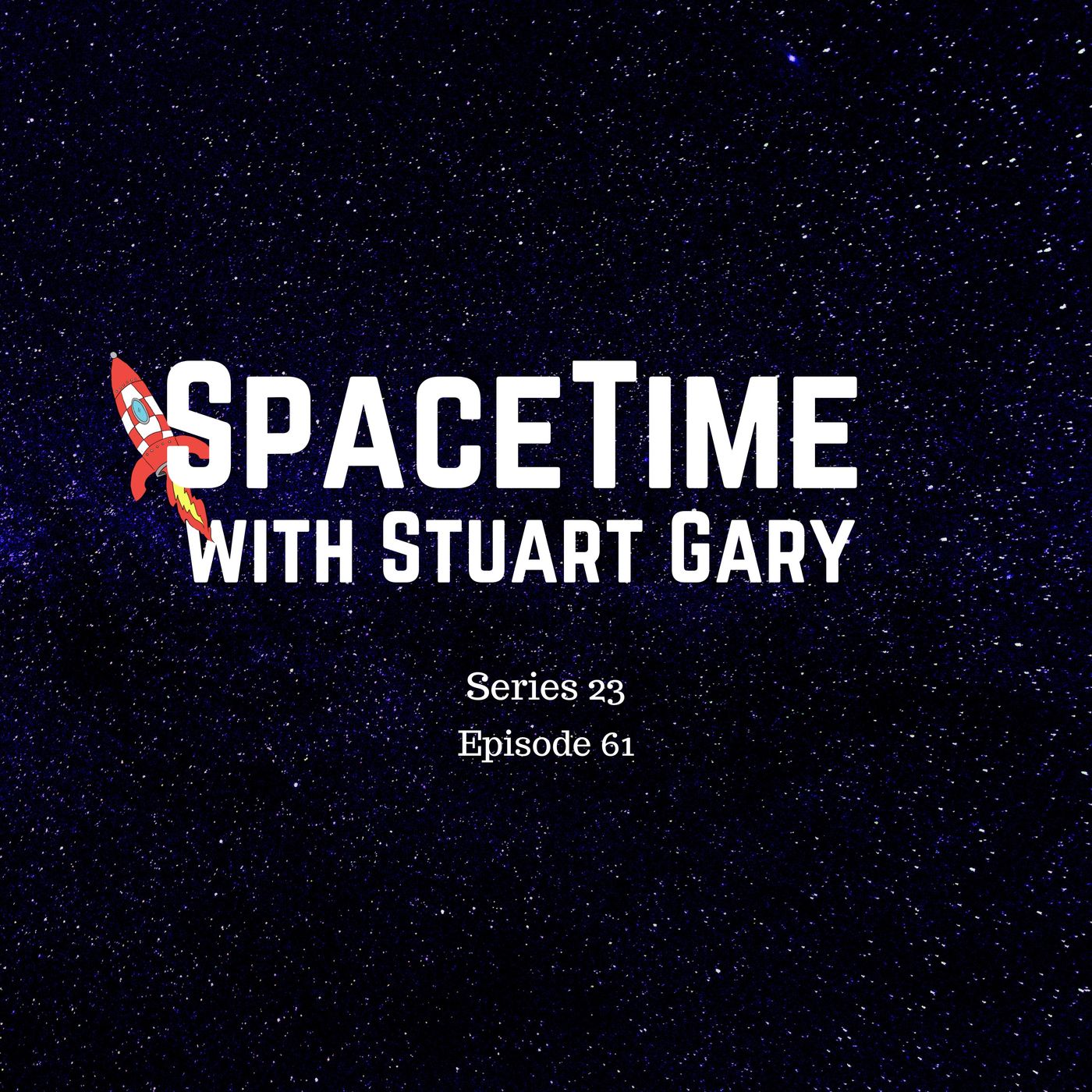
SpaceTime with Stuart GaryFirst Stars Began Shining Earlier Than Thought*First stars began shining earlier than thoughtA new study using some of the deepest images ever taken by NASA’s Hubble Space Telescope suggests the first stars in the universe began to shine far earlier than previously thought.https://spacetimewithstuartgary.tumblr.com/post/620269228147245056 https://spacetimewithstuartgary.tumblr.com/post/620269364009189376 https://spacetimewithstuartgary.tumblr.com/post/620269506080784384 *Planet Nine may not existA new study suggests that the long sort after planet 9 may not exist after all. Astronomers first hypothesised the existence of a mysterious planet 9 in 2016 after observing the strange elongated orbits for 13 distant Kuiper Belt ob...
2020-06-1936 min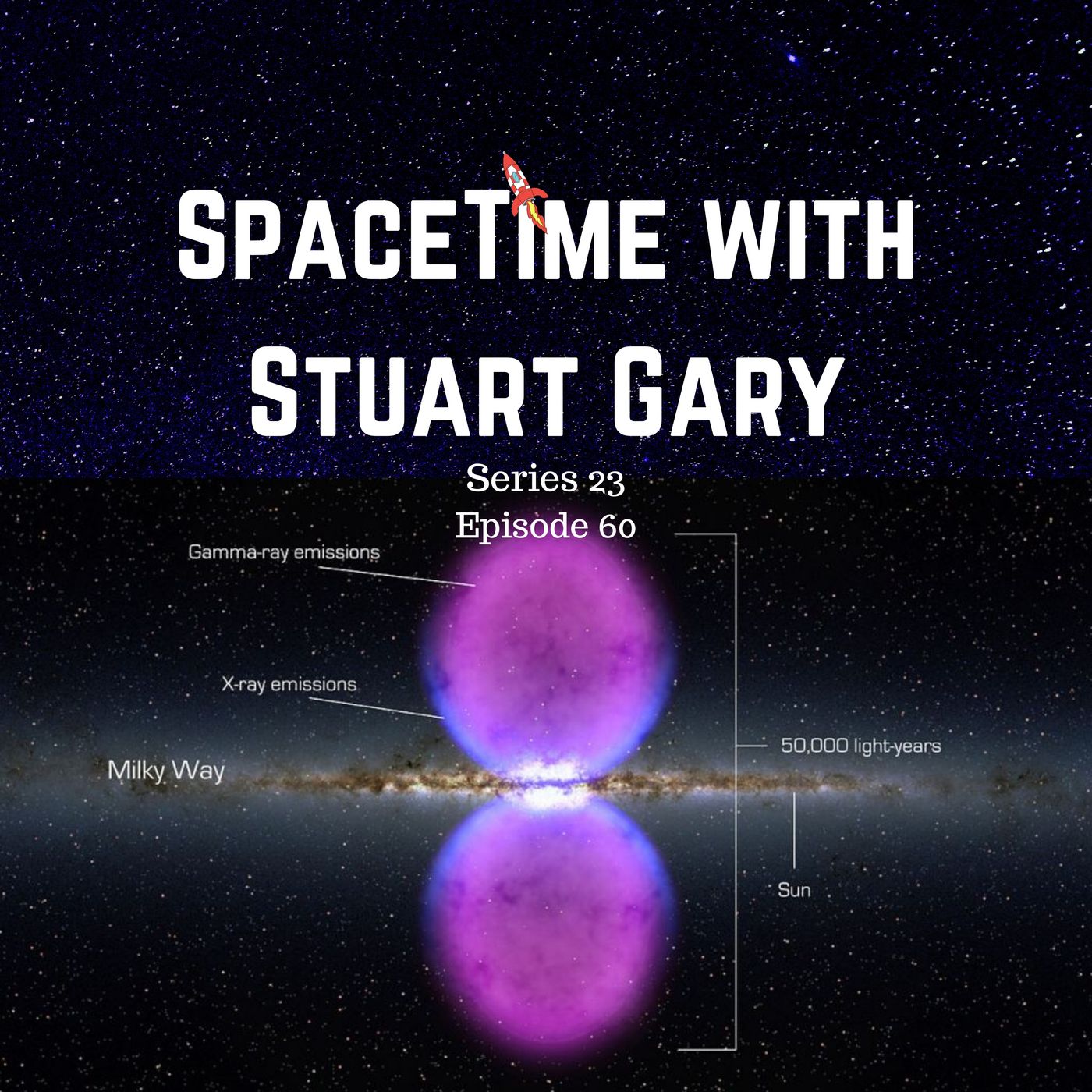
SpaceTime with Stuart GaryProbing the Mysteries of the Galaxy’s Fascinating Fermi Bubbles*Probing the mysteries of the galaxy’s fascinating Fermi BubblesAstronomers have studied the Milky Way galaxy’s mysterious Fermi Bubbles in visible light for the first time. *NASA’s new Lunar Gateway space stationNASA has finalized its contract for the crew module of its new Gateway lunar orbiting Space Station. *Work begins on the Artemis 3 service module to take humans back to the lunar surface.Work is about to get underway on the European Space Agency Service module that will power the Orion spacecraft to carry the first astronauts to walk on the M...
2020-06-1728 min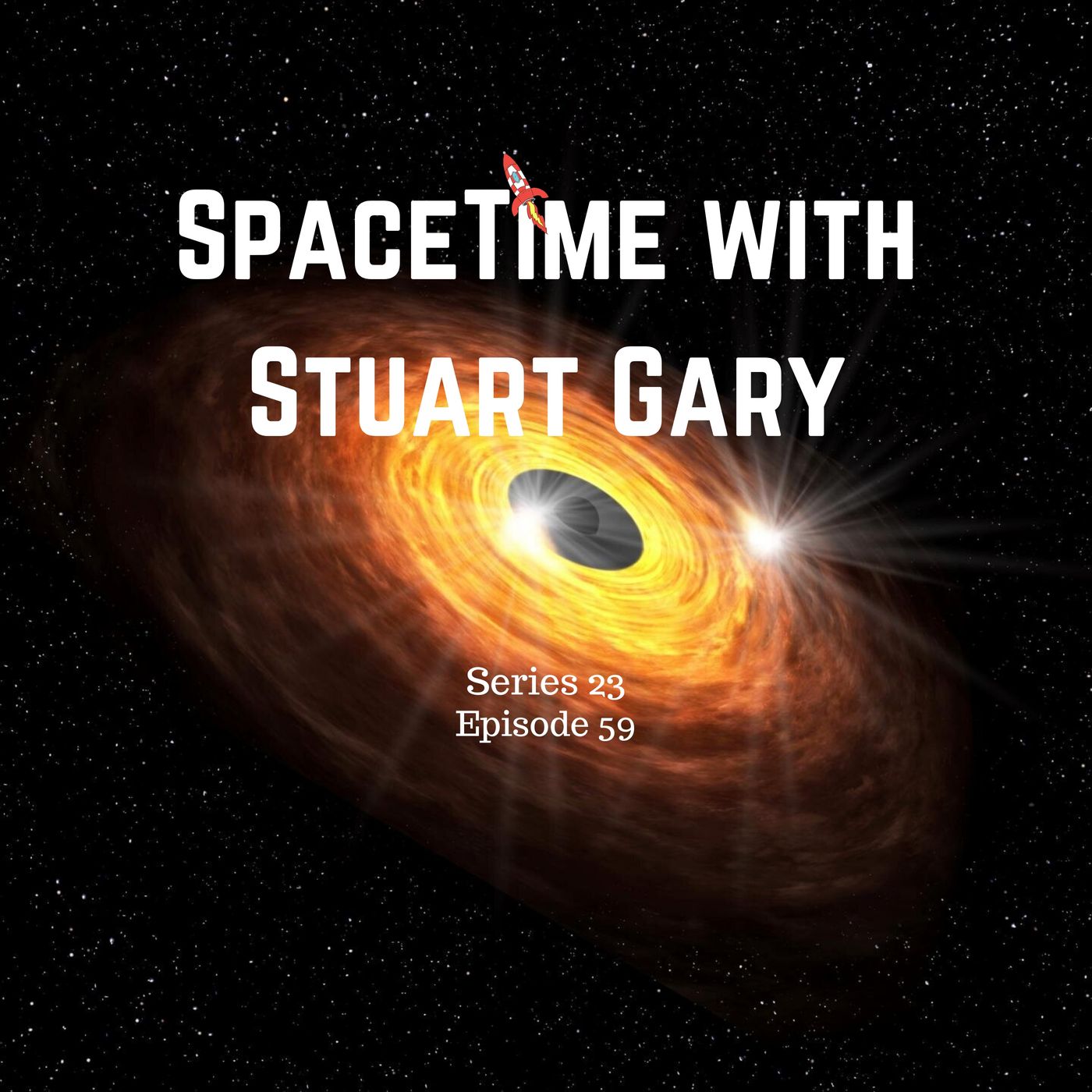
SpaceTime with Stuart GaryDiscovery of a Twinkling Heart to the Milky Way Galaxy*Discovery of a twinkling heart to the Milky Way GalaxyAstronomers have detected twinkling radio emissions from the inner edge of the accretion disk around Sagittarius A* -- the supermassive black hole at the centre of our Milky Way Galaxy. *Zooming in on Fast Radio BurstsAstronomers are slowly uncovering more of the secrets of mysterious cosmic explosions known as Fast Radio Bursts. *Skywatchers get a penumbral lunar eclipse and annular solar eclipseSky Watchers have been treated to a penumbral lunar eclipse – which appropriately happened to be the traditional strawberry Moon marking the...
2020-06-1534 min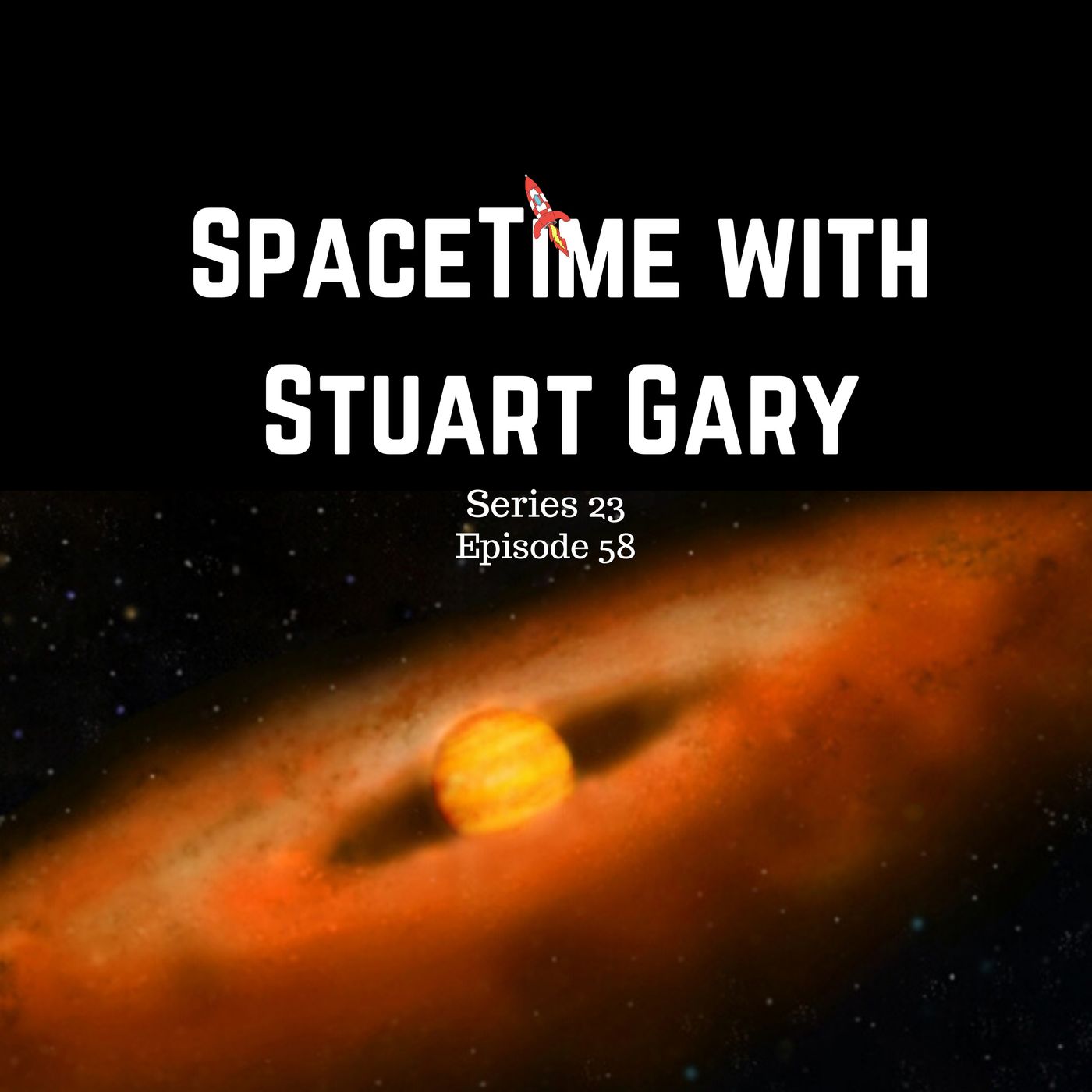
SpaceTime with Stuart GaryDiscovery of a Young Nearby Brown Dwarf Possibly Forming Planets*Discovery of a young nearby Brown Dwarf possibly forming planetsAstronomers have discovered a brown dwarf with the protoplanetary disk system – which could potentially form planets. *SpaceX’s Starship prototype destroyed in massive explosionSpaceX’s Starship SN4 test article has exploded in spectacular fashion erupting in a massive fireball on its South Texas test stand. *Russia developing a new commercial launch systemThe Russian Federal Space Agency Roscosmos says it’s working on a new more economical version of its venerable Soyuz launch system to better compete in the growing global satellite launch mar...
2020-06-1238 min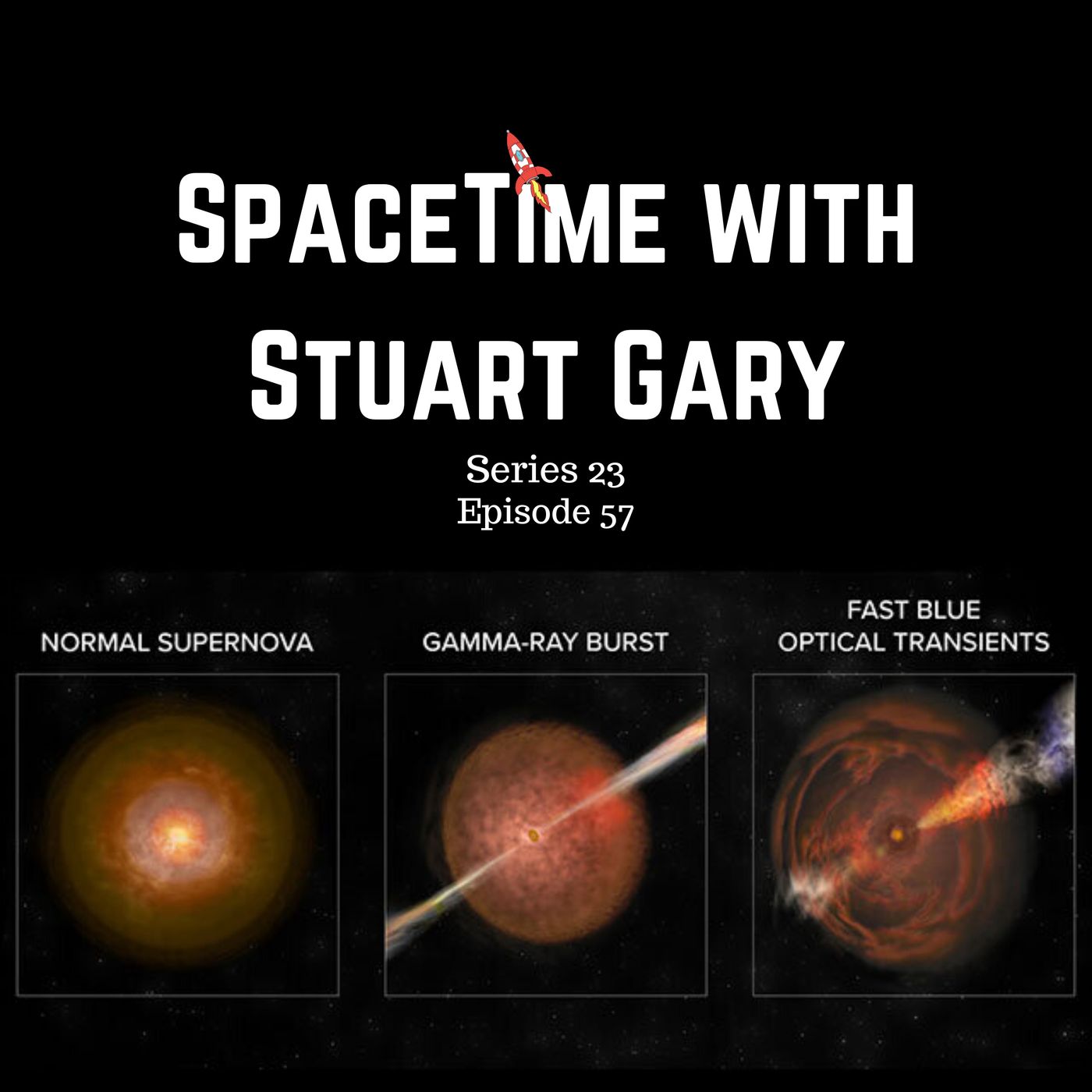
SpaceTime with Stuart GaryNew Type of cosmic explosion New type of cosmic explosion*New type of cosmic explosion Astronomers have discovered two new events similar to a strange inexplicable explosion which mysteriously blasted across the cosmos in 2018. *Galactic collision may have triggered our solar system’s birthThe formation of the Sun, the Solar System and the subsequent emergence of life on Earth may be a consequence of a cosmic collision between our Milky Way Galaxy and a smaller satellite galaxy known as Sagittarius Dwarf. *Europe's Spaceport back to businessThe European Space Agency’s Kourou Space Port in French Guiana is beginning to get back to wo...
2020-06-1032 min
SpaceTime with Stuart GaryConfirmation of a Second Planet Orbiting Proxima Centauri*Confirmation of a second planet orbiting Proxima CentauriAstronomers have confirmed a second exo-planet orbiting around the nearest star to the Earth other than the Sun. *Discovering the universe’s missing matterAstronomers using mysterious explosions in the distant cosmos known as Fast Radio Bursts have solved a decades old riddle about the universe’s missing matter. *New type of matter inside neutron starsA new study suggests neutron stars may contain an exotic substance known as quark matter. *China ramps up its 2020 launch scheduleChina is maintaining its busy launch...
2020-06-0838 min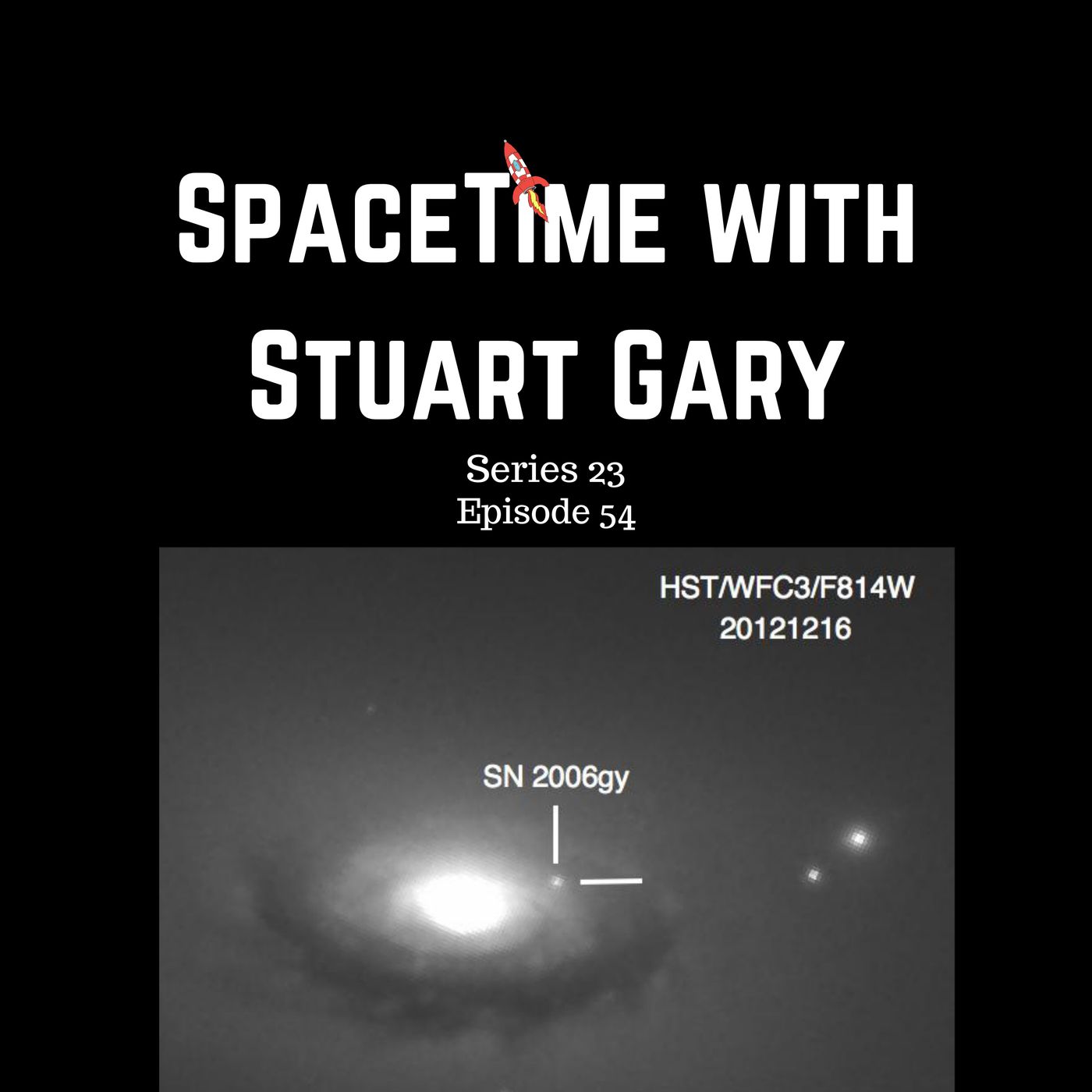
SpaceTime with Stuart GaryThe Brightest Explosions in the Universe*The brightest explosions in the universeMystery still surrounds events known as superluminous supernovae -- which are the brightest explosions in the universe.*The mysterious X-37B Space Shuttle launches on another classified missionThe United States Space Force has launched one of its mysterious X-37 B space shuttles on another classified orbital mission.*Virgin Orbit crash and burns on its maiden flightVirgin Orbit’s new LauncherOne rocket launch system has a failure during its maiden flight.*The Science ReportUnsuccessful trials for a new HIV-AIDS based combination treatment for COVID-19.Re...
2020-06-0326 min
SpaceTime with Stuart GaryAmerican’s Fly into Space from American Soil For the First Time in Nine Years*American’s fly into space from American soil for the first time in nine yearsThe SpaceX Demo two mission successfully blasted off from Space Launch Complex 39A at the Kennedy Space Centre at in the Cape Canaveral Air Force Base in Florida. NASA astronauts Robert Behnken and Douglas Hurley were aboard the Crew Dragon two capsule for the historic Demo-2 mission atop a Falcon 9 rocket which successfully docked with the International Space Station 19 hours after lift-off.*Astrobiologists put the technology of the new Mars rover to the testNASA is slated to launch its Mars 2020 Pe...
2020-06-0141 min
SpaceTime with Stuart GaryComet Swan Swoops Past Earth*Comet Swan swoops past EarthIt seems to be the case of another month means another new comet as C/2020 F8 Swan is currently making its closest approach to Earth passing some 85 million kilometres away.*The Jovian ice moon Europa reveals new detailsNew high-resolution images of the Jovian ice moon Europa are providing scientists with fresh clues about how its frozen surface formed.*The Mercury TelescopeIndia is building a new telescope – with a difference instead of the traditional polished glass primary mirror -- this observatory will use spinning liquid mercury as th...
2020-05-2931 min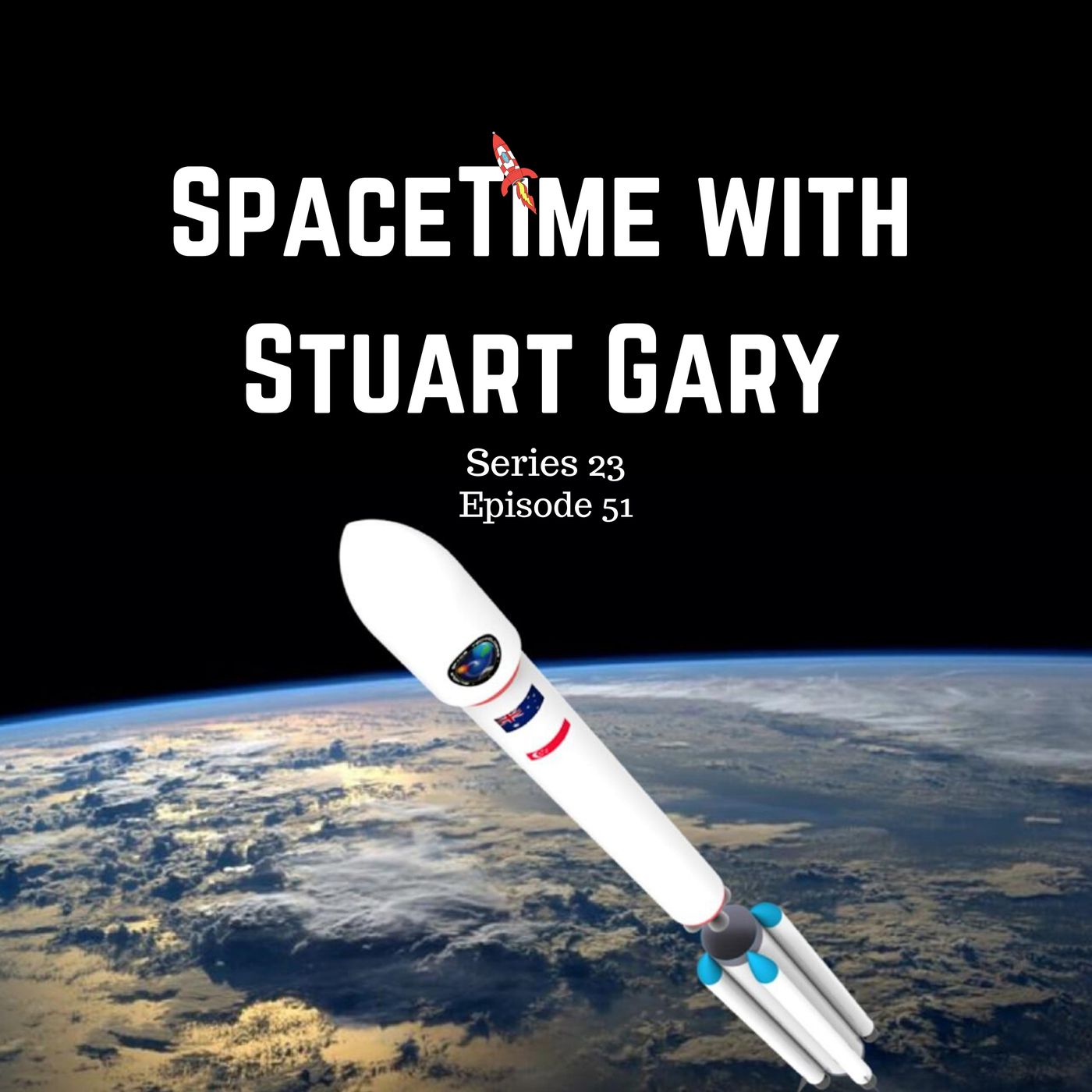
SpaceTime with Stuart GaryQueensland Company Wins Australian Orbital Rocket Contract*Queensland company wins Australian orbital rocket contractThe Australian Department of Defence Science and Technology has awarded Queensland-based Gilmour Space a contract to develop a new orbital rocket launch system.*WFIRST Dark Energy Telescope renamed after Nancy Grace RomanNASA has formally named its Wide Field Infrared Survey Telescope – WFIRST -- in honour of the agency’s first chief astronomer Nancy Grace Roman, who paved the way for space telescopes like Hubble to observe the universe from orbit – above the effects of Earth’s atmosphere.https://spacetimewithstuartgary.tumblr.com/post/618688707026911232https://spacetimewithstuartgary.tumblr.com/post/618...
2020-05-2725 min
SpaceTime with Stuart GaryScientists Create a New Type of Atom*Scientists create a new type of atomPhysicists have created a new never before seen exotic atom called Pionic Helium. Researchers created the particle to study the properties of a subatomic particle called a meson.*The Sun is less active than most starsA new study has found the Sun is at least five times less active than other similar stars. A report in the journal Science based on an analysis of 369 Sun-like stars shows that solar brightness variations are extremely weak – just 0.07 percent -- compared to other stars.*Elongating blobs of molten metals ca...
2020-05-2531 min
SpaceTime with Stuart GaryStunning New Images from the Surface of Asteroid RyuguSpaceTime with Stuart Gary Series 23 Episode 49*Stunning new images from the surface of the asteroid RyuguAstronomers have released amazing new close up high-resolution images and video of the surface of the asteroid Ryugu.*Claims an extraterrestrial protein has been discoveredScientists have found what they think could be the first known extraterrestrial protein discovered inside a meteorite.*Gas giants do form differently to brown dwarfsA new study claims gas giant exoplanets located at the outer edges of their planetary systems are formed in a different way to brown dwarfs.
2020-05-2225 min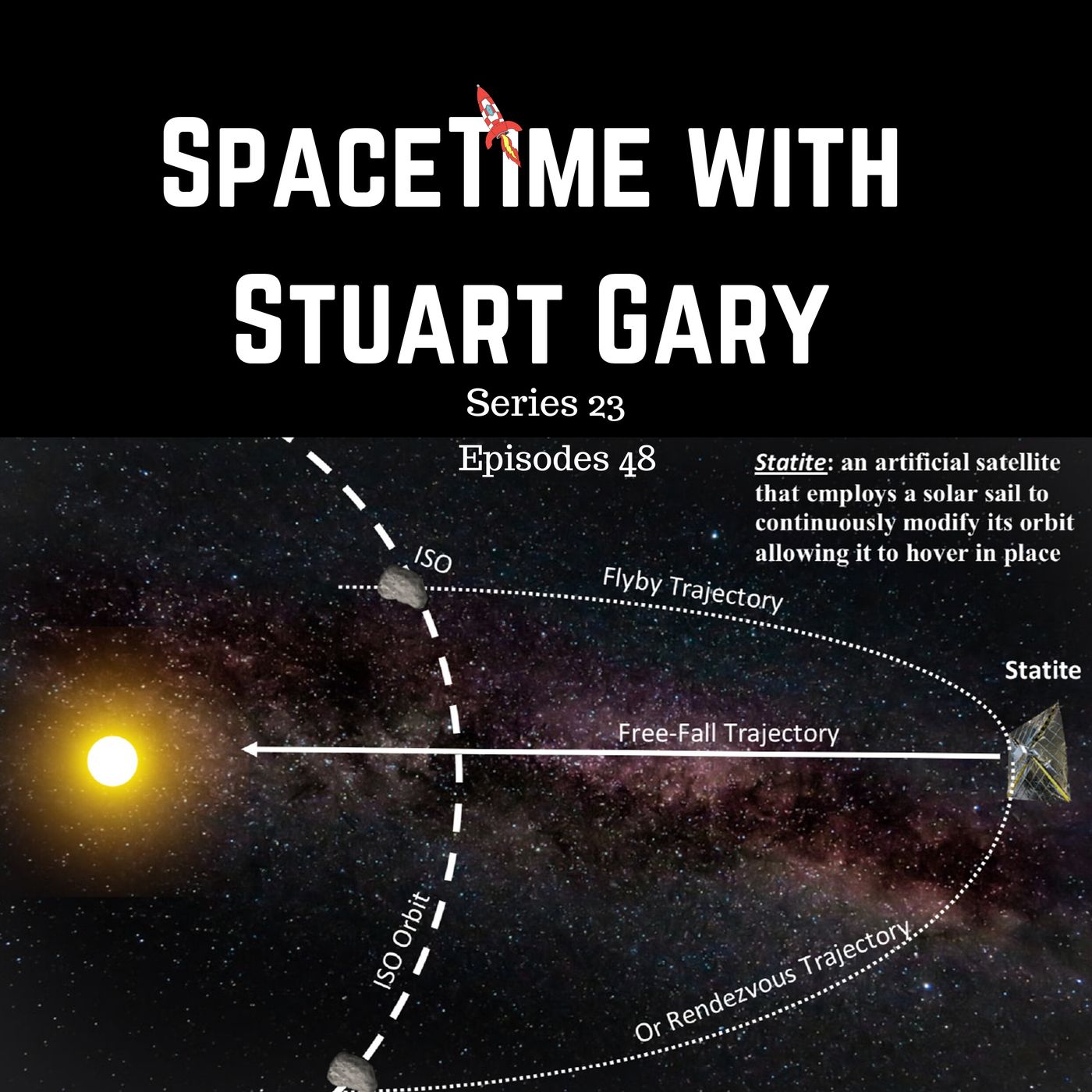
SpaceTime with Stuart GaryNew Plan to Intercept Interstellar Visitors*New plan to intercept interstellar visitorsNASA has provided some seed funding for an idea to develop a fleet of prepositioned spacecraft to study interstellar asteroids and comets before they zoom out of the solar system.*New evidence for watery plumes erupting on EuropaNew computer simulations based on data from NASA’s 1990s vintage Galileo spacecraft are providing more evidence that the Jovian ice moon Europa erupts plumes of water deep into space from its massive subsurface ocean.*Perseverance Rover placed in launch configuration for its flight to MarsNASA scientists and en...
2020-05-2028 min
SpaceTime with Stuart GaryOne of the Oldest Objects in the Milky WaySpaceTime with Stuart Gary Series 23 Episode 47*One of the oldest objects in the Milky WayAstronomers have discovered an ancient globular cluster that appears to be a staggering 13.6 billion years old – making it one of the oldest known objects in the Milky Way galaxy.*Growing doubts about one of the universe’s fundamental constantsA new study suggests one of the fundamental constants of the laws of physics doesn’t appear to be quite so constant across the universe and seems to change depending on where you are.*Australia and United States threatened by out...
2020-05-1835 min
SpaceTime with Stuart GaryVenus Dominated by Atmospheric Tidal Waves*Venus dominated by atmospheric tidal wavesA new study shows Venus’s atmosphere rotates much faster than the planet itself because of a thermal tide generated by solar heating on the planet’s dayside and corresponding cooling on its nightside.*High speed turbulence preventing star birth in galactic centreA new study claims high speed gas collisions suppress star formation along the central bar of barred spiral galaxies.*X-37B Space Shuttle prepares for new missionThe US Space Force is about to launch one of its X-37B space shuttles back into orbi...
2020-05-1528 min
SpaceTime with Stuart GaryDetecting Exotic Quark-Gluon PlasmaSpaceTime with Stuart Gary Series 23 Episode 45*Using colliding neutron stars to detect exotic quark-gluon plasmaNew computer modeling has suggested an exotic substance called quark-gluon plasma generated by the merging neutron stars could be detected through gravitational waves.*Jovian like cloud bands discovered on nearest Brown DwarfAstronomers have discovered that the nearest brown dwarf to Earth – has cloud bands similar to those seen around Jupiter.*Ariane 6 still on track for maiden flight this yearWell despite setbacks caused by the global COVID-19 corona virus pandemic – the Maiden flight of the European Spac...
2020-05-1324 min
SpaceTime with Stuart GaryThree CompaniesSpaceTime with Stuart Gary Series 23 Episode 43*Three companies selected to develop lunar module concepts to return people to the MoonNASA has selected SpaceX, Blue Origin, and Dynetics to further develop their concepts for the next generation of Lunar module. *The US Navy releases its UFO videosThe US Department of Defence has now formally released those three navy videos showing encounters between F/A-18 Super Hornet fighter jets and a series of unexplained aerial phenomena – what most people call UFOs.https://spacetimewithstuartgary.tumblr.com/post/616897100188368896 https://spacetimewithstuartgary.tumblr.com/post/616896919795613696 https://space...
2020-05-0835 min
SpaceTime with Stuart GaryOld - Very OldSpaceTime with Stuart Gary Series 23 Episode 42*Plate Tectonics at least 3.2 billion years oldA new study has found that planet Earth was already experiencing tectonic plate movements 3.2 billion years ago and that the plates back then were moving at similar rates to what they are now. *Hubble celebrates 30 years of scienceThe Hubble Space Telescope has just celebrated its 30th anniversary in space. It’s hard to believe, but for more than a generation now, the Earth orbiting observatory has been redefining our view of the universe providing a new understanding of the cosmos and hu...
2020-05-0627 min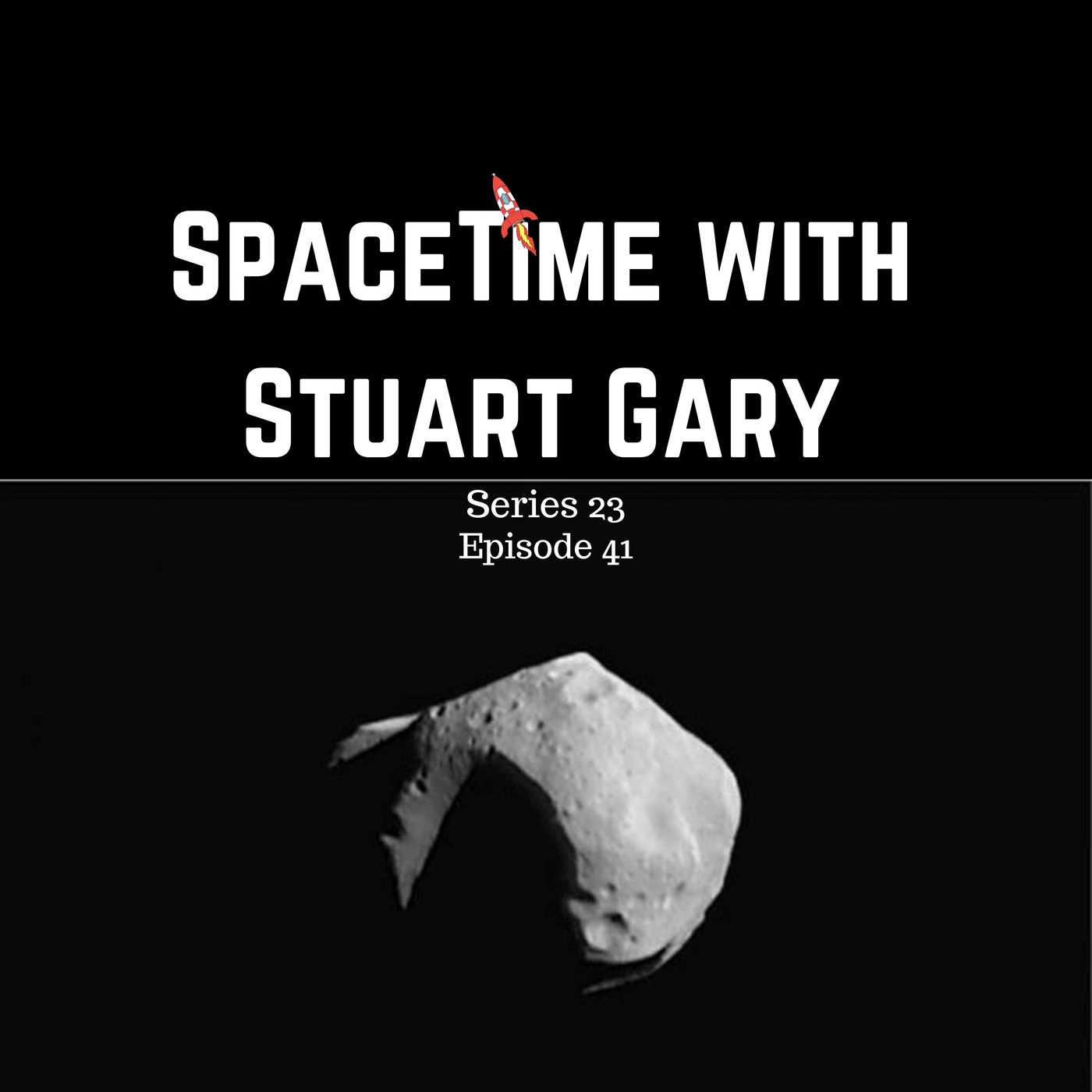
SpaceTime with Stuart GaryCentaurs Identified as Permanent Interstellar Visitors in our Solar SystemSpaceTime with Stuart Gary Series 23 Episode 41*Centaurs identified as permanent interstellar visitors in our solar systemAstronomers have identified the first known permanent population of asteroids originating from outside our solar system.*Asteroid FlybyA two kilometre wide potentially hazardous NEO or Near Earth Object has just flown past Earth space.*Keeping track of Bepi ColumboAs the European Space Agency’s Mercury bound BepiColumbo spacecraft undertook its 30 kilometre per second flyby of Earth the other week scientists with the University of Western Australia were keeping a close eye on it – just to m...
2020-05-0431 min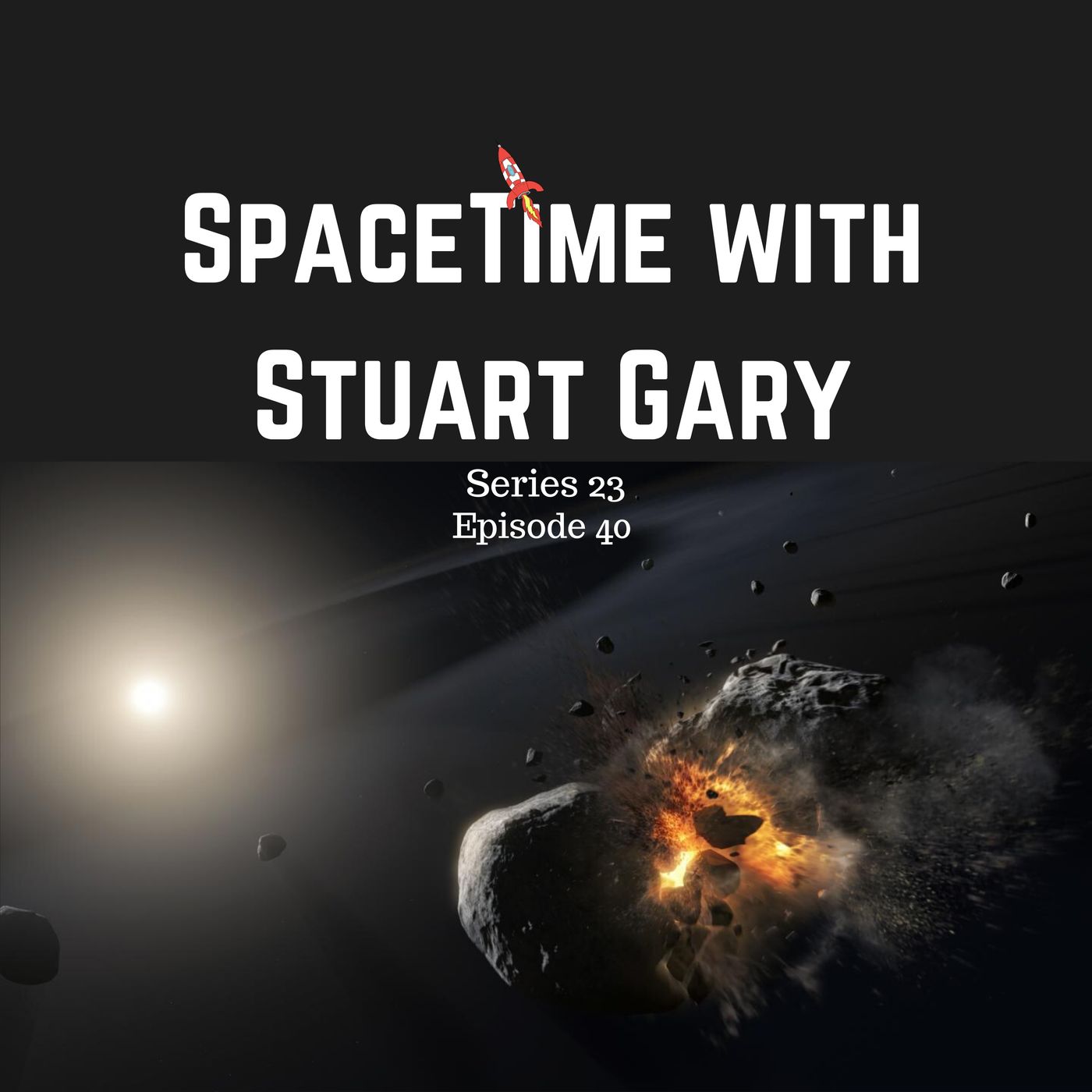
SpaceTime with Stuart GaryWhen Worlds Collide – the titanic collision of two asteroidsSpaceTime with Stuart Gary Series 23 Episode 40*When worlds collide – the titanic collision of two asteroidsAstronomers have observed an expanding cloud of icy debris caused by the catastrophic collision of two asteroids in a distant star system.https://spacetimewithstuartgary.tumblr.com/post/616007736900108288 https://spacetimewithstuartgary.tumblr.com/post/616002631330152448 *Why NASA chose Jezero Crater for the Mars 2020 Perseverance roverPreparations are continuing at the Cape Canaveral air force base for July’s planned launch of the Mars 2020 Perseverance rover. The mission will study the local geology and search for signs of past life on the red pl...
2020-05-0134 min
SpaceTime with Stuart GaryWhy the Universe ExistsSpaceTime with Stuart Gary Series 23 Episode 39*Strongest evidence yet that neutrinos explain why the universe existsThe difference between Neutrinos and their anti-matter counterpart may provide scientists with their best evidence yet to explain why the universe exists. *Possible second planet detected orbiting Proxima CentauriAstronomers have received some tantalizing clues of a possible second planet orbiting Proxima Centauri – our nearest neighbouring star system. *Cheops begins its science missionThe European Space Agency’s exoplanetary mission Cheops has successfully completed three months of in-orbit commissioning and is now ready to begin its scienc...
2020-04-2924 min
SpaceTime with Stuart GarySuperluminal JetsSpaceTime with Stuart Gary Series 23 Episode 37*Discovery of superluminal jets generated by colliding galaxiesAstronomers have discovered jets of charged particles bursting out at close to the speed of light from a pair of merging spiral galaxies.*First ever observation of rare helium white dwarf binaryAstronomers have for the first time ever detected a rare helium white dwarf binary.*Is Interstellar Comet Borisov breaking apartComet Borisov – the Solar Systems second confirmed interstellar visitor is breaking apart.*Final preparations continue for the launch of the Mars 2020 Perseverance roverFi...
2020-04-2427 min
SpaceTime with Stuart GaryBrightest Supernova Ever SeenSpaceTime with Stuart Gary Series 23 Episode 36 *Brightest supernova ever seenAstronomers have discovered the brightest, most energetic, and likely most massive supernova ever seen.*Bepi Columbo swoops past Earth at 30 kilometres per secondThe European Space Agency Bepi Columbo spacecraft has just undertaken a close gravity assist flyby of the Earth – swooping down over the South Atlantic Ocean at an altitude of just 12,677 kilometres.https://spacetimewithstuartgary.tumblr.com/post/614557598847483904 https://spacetimewithstuartgary.tumblr.com/post/614557943031021568 https://spacetimewithstuartgary.tumblr.com/post/614731357069918208 *Fine threads of million degree plasma woven through the Sun’s atmo...
2020-04-2223 min
SpaceTime with Stuart GaryThe Origins of Earth’s WaterSpaceTime with Stuart Gary Series 23 Episode 35 *The origins of Earth’s waterA new study claims Earth’s water was born with the planet and didn’t arrive later through asteroid or comet impacts.*Parkes radio telescope upgradeThe CSIRO’s iconic Parkes radio telescope is getting an upgrade.*Key pre-launch test for the James Webb Space TelescopeThere’s been an important milestone in the development of NASA’s new James Webb Space Telescope with a pre-launch test of its primary mirror being fully unfurled and deployed into the final configuration it will have...
2020-04-2028 min
SpaceTime with Stuart GaryRevolutionary New Images of a QuasarSpaceTime with Stuart Gary Series 23 Episode 34 *Revolutionary new images of a quasarAstronomers have obtained their best view yet of a massive quasar blasting out from a monster black hole a third of the way across the universe.*All systems are go for Vega-C maiden flightThe European Space Agency says all systems are go for the maiden flight of Europe’s new Vega-C launch vehicle.*Expedition 63 launchThe new Expedition 62/63 crew have arrived safely aboard the International Space Station following a rapid rendezvous four orbit flight from the Earth.https://sp...
2020-04-1729 min
SpaceTime with Stuart GaryAre gamma ray bursts powered by a star’s collapsing magnetic fields?SpaceTime with Stuart Gary Series 23 Episode 33 *Are gamma ray bursts powered by a star’s collapsing magnetic fields?New research suggests gamma ray bursts -- the most powerful explosions in the universe since the big bang – may be caused by the collapse of a dying star's magnetic field.*The mysteries of UranusA new study says the strange axis of rotation of the planet Uranus and the unusual properties of its moons and ring system was most likely caused by an ancient collision with another planet up to three times the size of Earth billions of y...
2020-04-1522 min
SpaceTime with Stuart Gary26: Biggest Explosion Since the Big BangSpaceTime with Stuart Gary Series 23 Episode 26*Biggest explosion since the big bangAstronomers have detected the biggest explosion ever recorded anywhere in the universe – other than the big bang itself.*Could fragments of the planet Theia be buried under the lunar surfaceA new study claims fragments of the planet that hit the Earth to create the Moon may still be present below the lunar surface.*More Near-Earth Objects detectedThe European Space Agency’s Near-Earth Objects co-ordination centre has added another 202 asteroids to its list of potentially hazardous objects that pass clos...
2020-03-3022 min
SpaceTime with Stuart Gary24: New Type of Pulsating Star DiscoveredSpaceTime with Stuart Gary Series 23 Episode 24*New type of pulsating star discoveredAstronomers have discovered an unusual star that pulsates on just one side. The strange tear-drop shaped star reported in the journal Nature Astronomy is part of a binary system located some 1500 light-years away.https://spacetimewithstuartgary.tumblr.com/post/612348495540649984 *SpaceX to fly astronauts to the Space Station in MayNASA has confirmed that SpaceX will fly astronauts to the International Space Station in May using a Falcon 9 rocket and Crew Dragon 2 capsule. The historic flight will be the first manned mission launched from...
2020-03-2536 min
SpaceTime with Stuart Gary23: Dark Matter and D-Star HexaquarksSpaceTime with Stuart Gary Series 23 Episode 23*Could dark matter be made up of strange particles called d-star hexaquarksScientists have identified a sub-atomic particle that could have formed the 'dark matter' in the Universe during the Big Bang. *Rare white dwarf mergerAstronomers have identified an unusually massive white dwarf which may be the result of a rare merger between smaller two white dwarfs. *New in orbit satellite salvage spacecraft begins operationsNorthrop Grumman have undertaken their first in orbit satellite refuelling operation successfully linking up with an aging telecommunications satellite in...
2020-03-2034 min
SpaceTime with Stuart Gary21: Rewriting the History of Star Formation at the Heart of the Milky WaySpaceTime with Stuart Gary Series 23 Episode 21*Rewriting the history of star formation at the heart of the Milky WayNew observations have rewritten the history of star formation at the centre of the Milky Way.YouTube URL: https://spacetimewithstuartgary.tumblr.com/post/189733859513 YouTube URL: https://spacetimewithstuartgary.tumblr.com/post/189732690948 YouTube URL: https://spacetimewithstuartgary.tumblr.com/post/189732659093 *ASA HQ officially openedMeanwhile, Prime Minister Scott Morrison has officially opened the fledgling Australian Space Agency’s new headquarters in Adelaide. *New Russian military satellite launchedMoscow has launched a new military sa...
2020-03-1339 min
SpaceTime with Stuart Gary20: Volcanically Active VestaSpaceTime with Stuart Gary Series 23 Episode 20 *Volcanically active VestaNew evidence shows the asteroid 4 Vesta remained volcanically active far longer than it should have.*South Australia back in space flight this year.It’s been many decades since the last spacecraft were launched into orbit from the Woomera rocket range in South Australia’s far north.*Phantom Express project scrappedBoeing has withdrawn from the Phantom Express Experimental Spaceplane Program.*Russia launches 34 satellites on SoyuzA Russian Soyuz rocket has blasted into orbit carrying 34 new internet telecommunications satellites. For enhanced Show...
2020-03-1125 min
SpaceTime with Stuart Gary19: Mars: Rocking and Rolling on the Red PlanetSpaceTime with Stuart Gary Series 23 Episode 19*Mars: rocking and rolling on the red planetNew data has revealed that Mars is very geologically active with regular marsquakes occurring across the red planet. *Understanding the birth of atomsA new study will use new three-dimensional supercomputer simulations to recreate the evolution of different types of stars to better understand the origin of the first atoms and elements on the periodic table.*Looks like Betelgeuse has stopped dimming – at least for nowWeeks of speculation over whether the red supergiant star Betelgeuse is about to go su...
2020-03-0643 min
SpaceTime with Stuart Gary18: Studying Jupiter’s Water ContentSpaceTime with Stuart Gary Series 23 Episode 18*Studying Jupiter’s water contentNASA’s Juno mission has provided its first science results on the amount of water in Jupiter’s atmosphere.*Building a universe without dark matterScientists have for the first time replicated a functioning universe without using dark matter.*Where are we now at - over the idea of Life on Mars?The possibility of life on Mars has long been a subject of significant speculation among astronomers -- especially those interested in planetary science or astrobiology. So where are we really at?...
2020-02-2843 min
SpaceTime with Stuart Gary17: Mars Could Have Liquid Water on its SurfaceSpaceTime with Stuart Gary Series 23 Episode 17*Mars could have liquid water on its surfaceA new study suggests that Mars might have liquid salty water on its surface for a few days every year.*New exoplanetary discoveryAstronomers have confirmed the discovery of a new exoplanet located some 250 light years away.*Discovery of a stellar auroraeAstronomers have detected auroral activity around a star for the first time.*Iran’s fake manned space programStraight out of 'the you couldn’t make this stuff up' category comes news that Iran’s Information and te...
2020-02-2636 min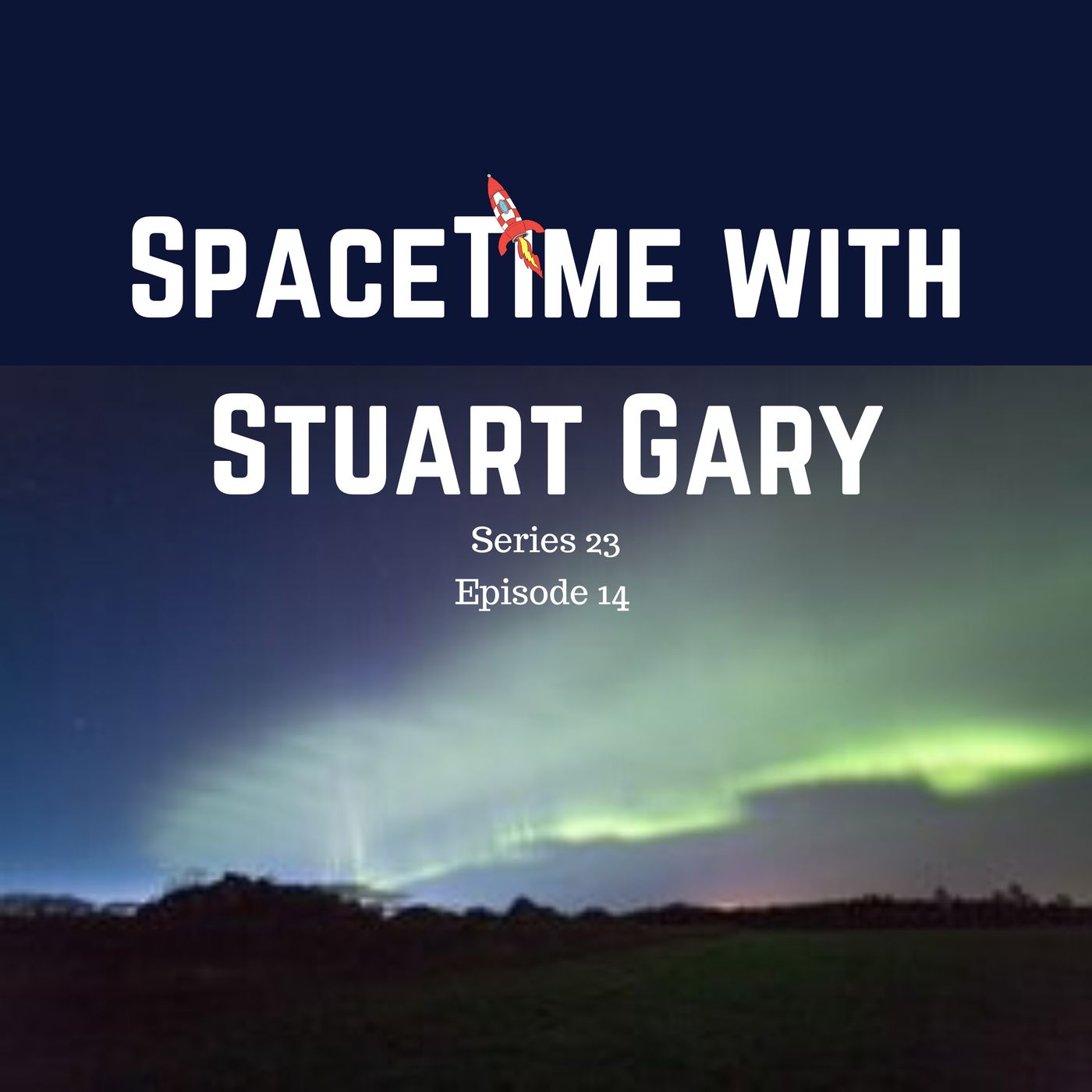
SpaceTime with Stuart Gary14: New Type of Aurorae DiscoveredSpaceTime with Stuart Gary Series 23 Episode 14*New type of aurorae discoveredA new type of aurora called the dunes has been discovered in the skies above Finland.*Rare Atiras asteroid discoveredAstronomers have discovered a rare asteroid orbiting inside the orbit of Venus.*Astronauts wrap up refurbishment of cosmic ray detectorAstronauts aboard the International Space Station have successfully completed their fourth spacewalk designed to refurbish the Alpha Magnetic Spectrometer.*Orion spacecraft under testNASA’s new manned spacecraft for missions to the Moon, Mars and beyond is now un...
2020-02-1444 min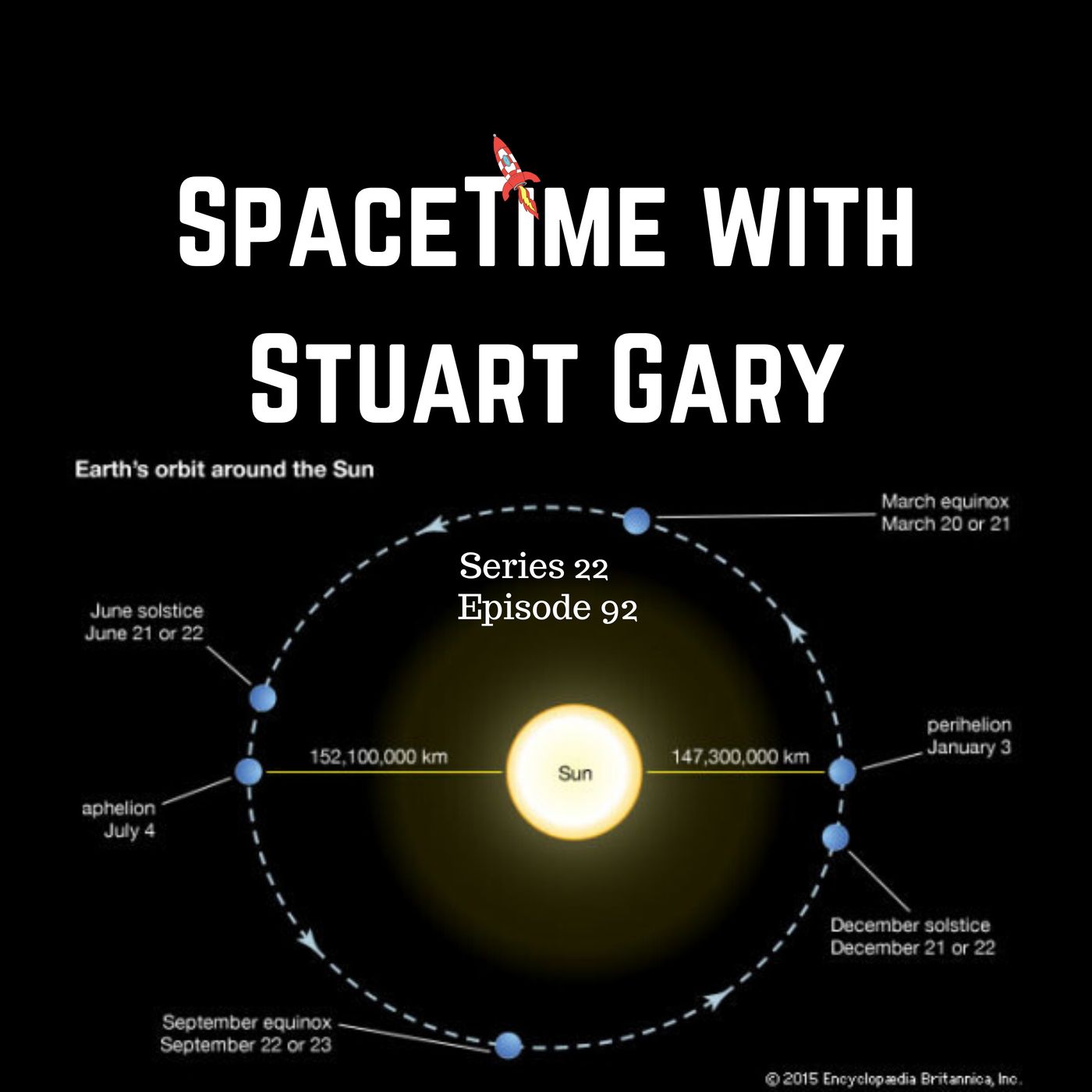
SpaceTime with Stuart Gary92: Neutrino's - A New MeasurementSpaceTime with Stuart Gary S22E92The astronomy and space science news podcast.Stream podcast episodes on demand from www.bitesz.com/spacetime (mobile friendly). *A new measurement for the mass of the most common particle in the universeScientists have set the upper limit for the mass of the neutrino -- the most common particle in the universe.*Wreckage found from India’s crashed lunar landerNASA has found the remains of India’s ill-fated Vikram lunar lander which crashed on to the surface of the Moon during a failed landing attempt in September.*All systems go for CHEOPS launchThe European Space...
2019-12-1343 min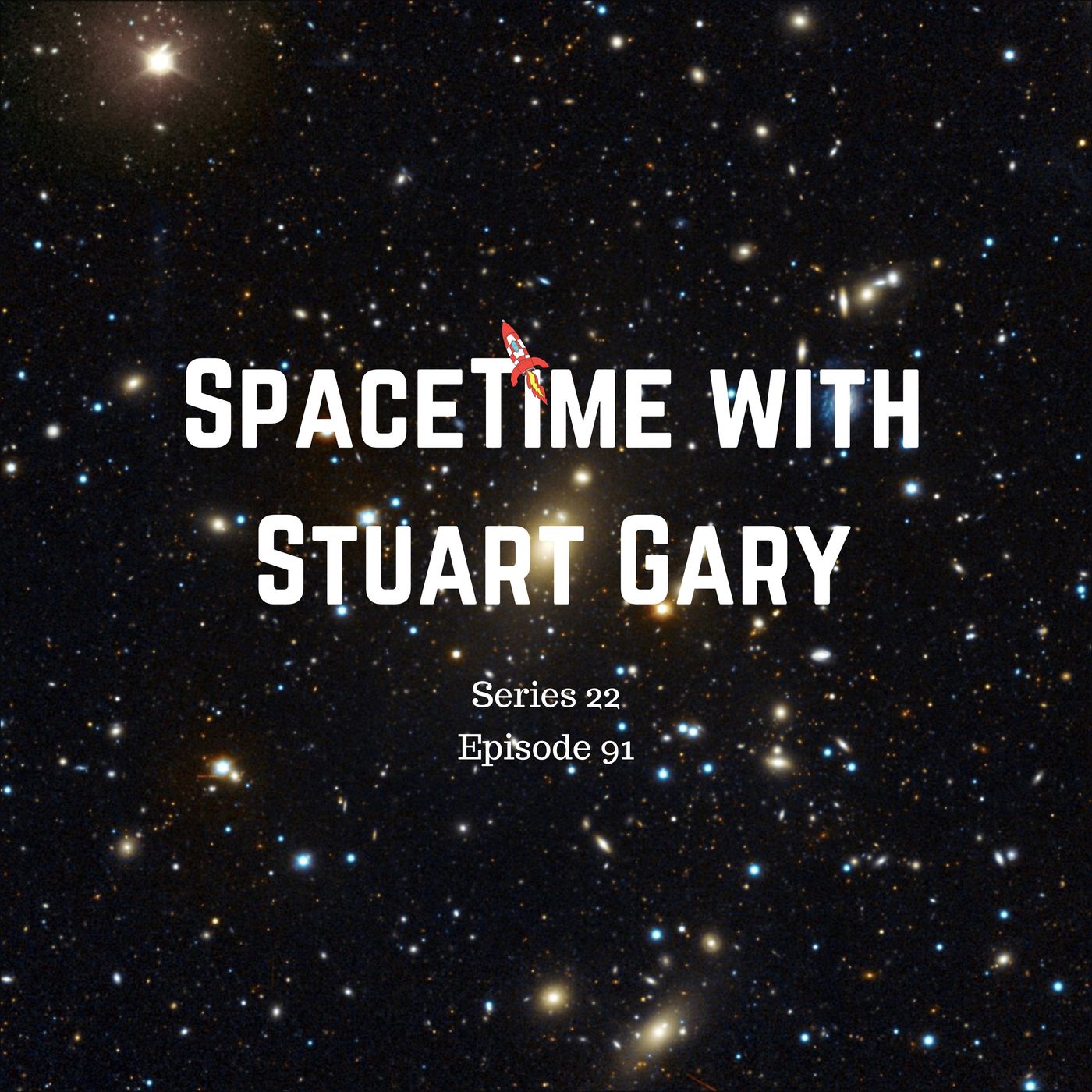
SpaceTime with Stuart Gary91: Biggest Supermassive Black Hole in the Local UniverseStream podcast episodes on demand from www.bitesz.com/spacetime (mobile friendly). SpaceTime with Stuart Gary S22E91 *Biggest supermassive black hole in the local universeAstronomers have identified a record-setting supermassive black hole – some 40 billion times the mass of our Sun –making it easily the biggest in the local universe.*The Sun’s secrets being revealedThe first detailed results from NASA’s Parker Solar Probe are revealing some surprising secrets about the Sun.YouTube URL: https://spacetimewithstuartgary.tumblr.com/post/189488131203*Determining the size of a protonPhysicists are getting closer to solving the proton radius puzzle with one of the most precise ne...
2019-12-1151 min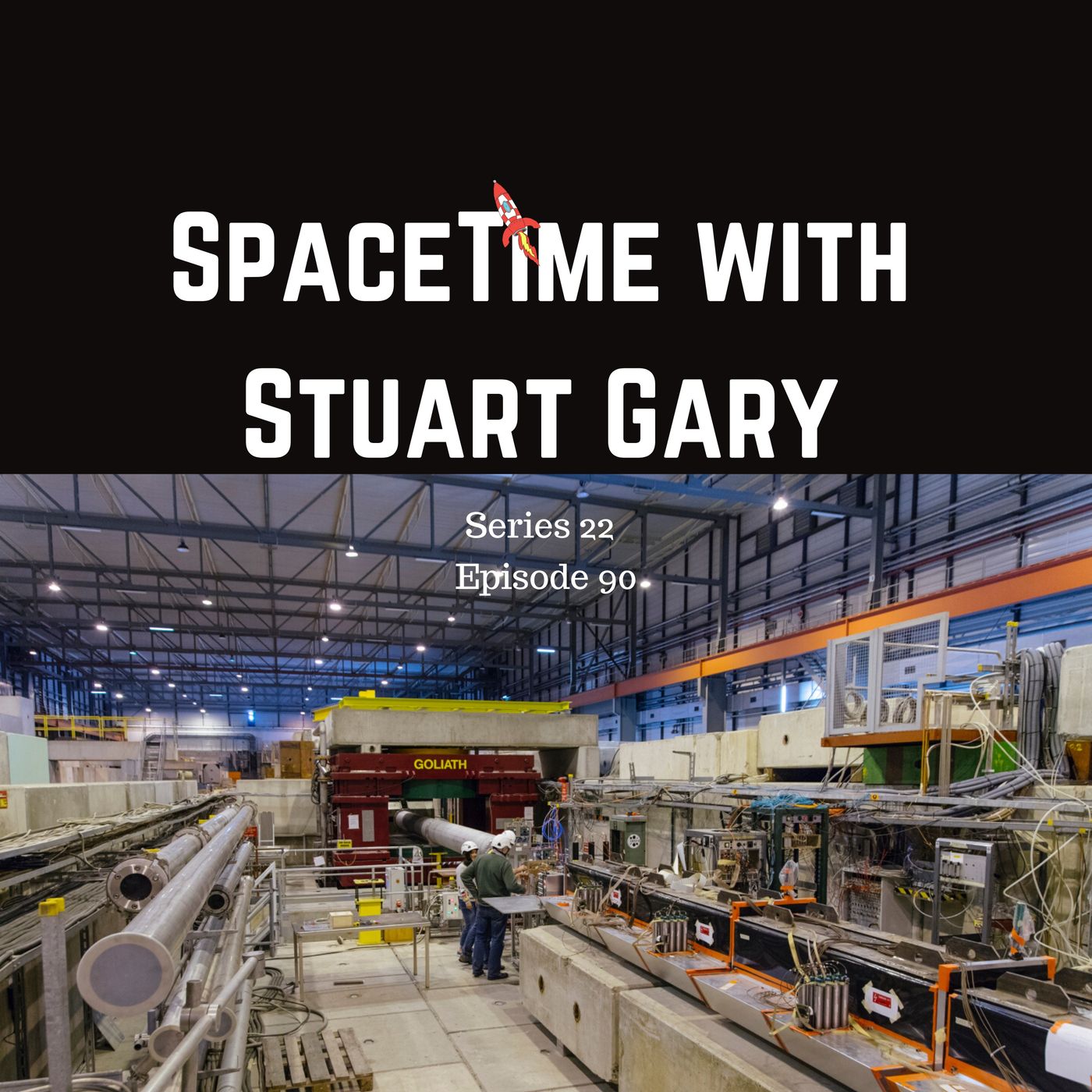
SpaceTime with Stuart Gary90: Have Scientists Detected a Mysterious Fifth Force in Nature?SpaceTime with Stuart Gary Series 22 Episode 90The astronomy and space science news podcast.Stream podcast episodes on demand from www.bitesz.com/spacetime (mobile friendly). *Have scientists detected a mysterious fifth force in natureScientists with CERN the European Organisation for Nuclear Research are investigating fresh claims of the detection of an unknown particle that could carry a fifth force of nature.*Record-setting X-ray burstInstruments aboard the International Space Station have detected their brightest ever X-ray burst.https://www.youtube.com/watch?v=1FkoWncpMYg *Rewriting the text books on the origins of globular clustersAstronomers have discovered relatively young globular clusters in a g...
2019-12-0631 min
SpaceTime with Stuart Gary89: Massive Explosion Rocks the Centre of the Milky WaySpaceTime 20191204 Series 22 Episode 89 Stream podcast episodes on demand from www.bitesz.com/spacetime (mobile friendly). *A massive explosion rocks the centre of the Milky WayAstronomers have found evidence of a cataclysmic flare that exploded out from the centre of the Milky Way effecting the Magellanic stream linking our galaxy with two nearby dwarf galaxies 200,000 light-years away. *Milky Way stealing galaxies from its neighboursA new study has found that the Milky Way galaxy has been stealing satellite galaxies from a nearby galaxy known as the Large Magellanic Cloud. *Global storms launch dust towers into the Martian skyA new study suggests massive glob...
2019-12-0439 min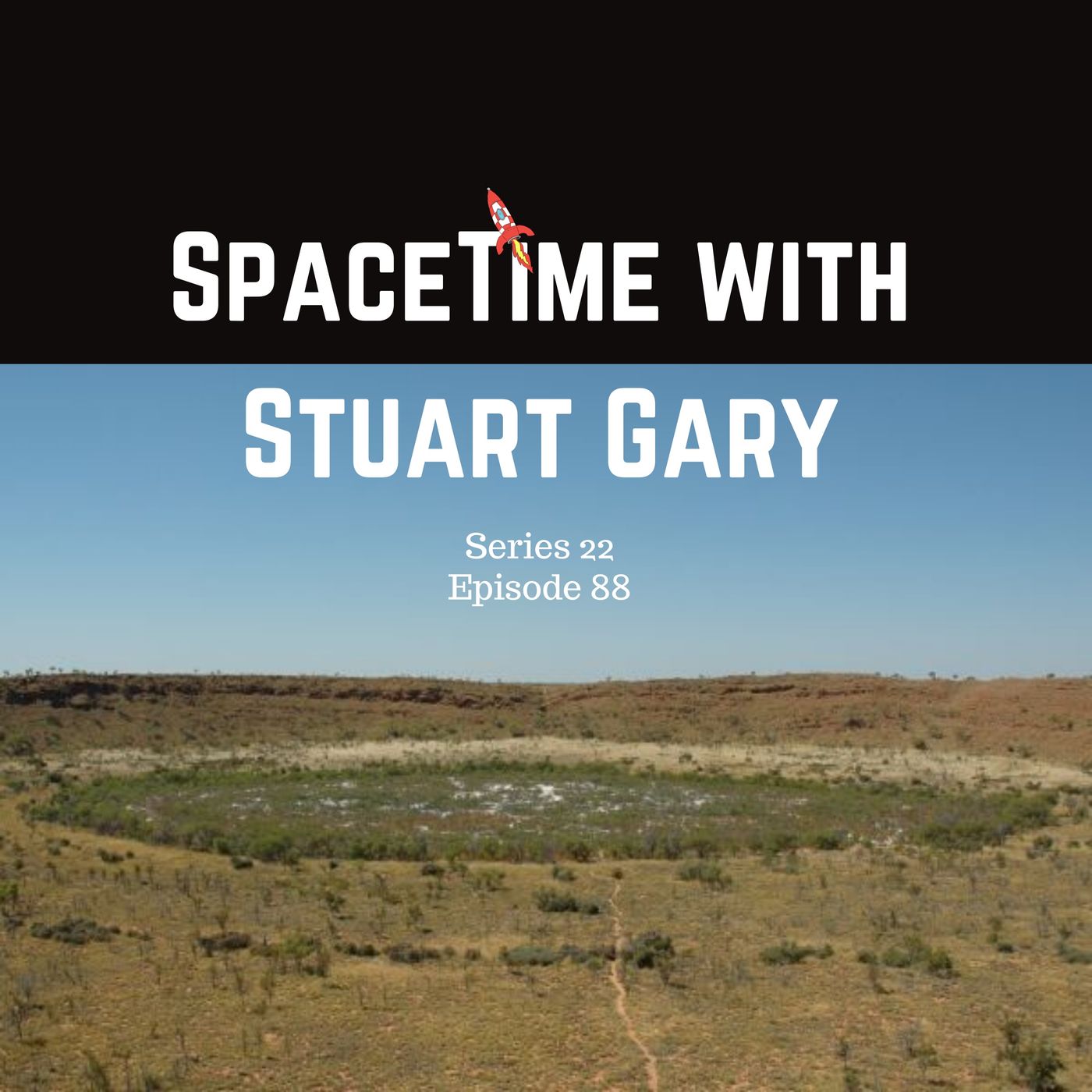
SpaceTime with Stuart Gary88: Wolfe Creek Crater Younger Than ThoughtStream podcast episodes on demand from www.bitesz.com/spacetime (mobile friendly). SpaceTime with Stuart Gary S22E88 *Wolfe Creek Crater younger than thoughtWolfe Creek Crater, one of the world's largest meteorite impact structures is much younger than previously thought.*The first global map of Titan completedThe first map showing the global geology of Saturn’s largest moon, Titan, has been completed revealing a dynamic world of dunes, lakes, plains, craters and other terrains.*Astronauts carry out space walks to service the AMSAstronauts aboard the International Space Station have carried out the first two of a planned four space walks to s...
2019-11-2935 min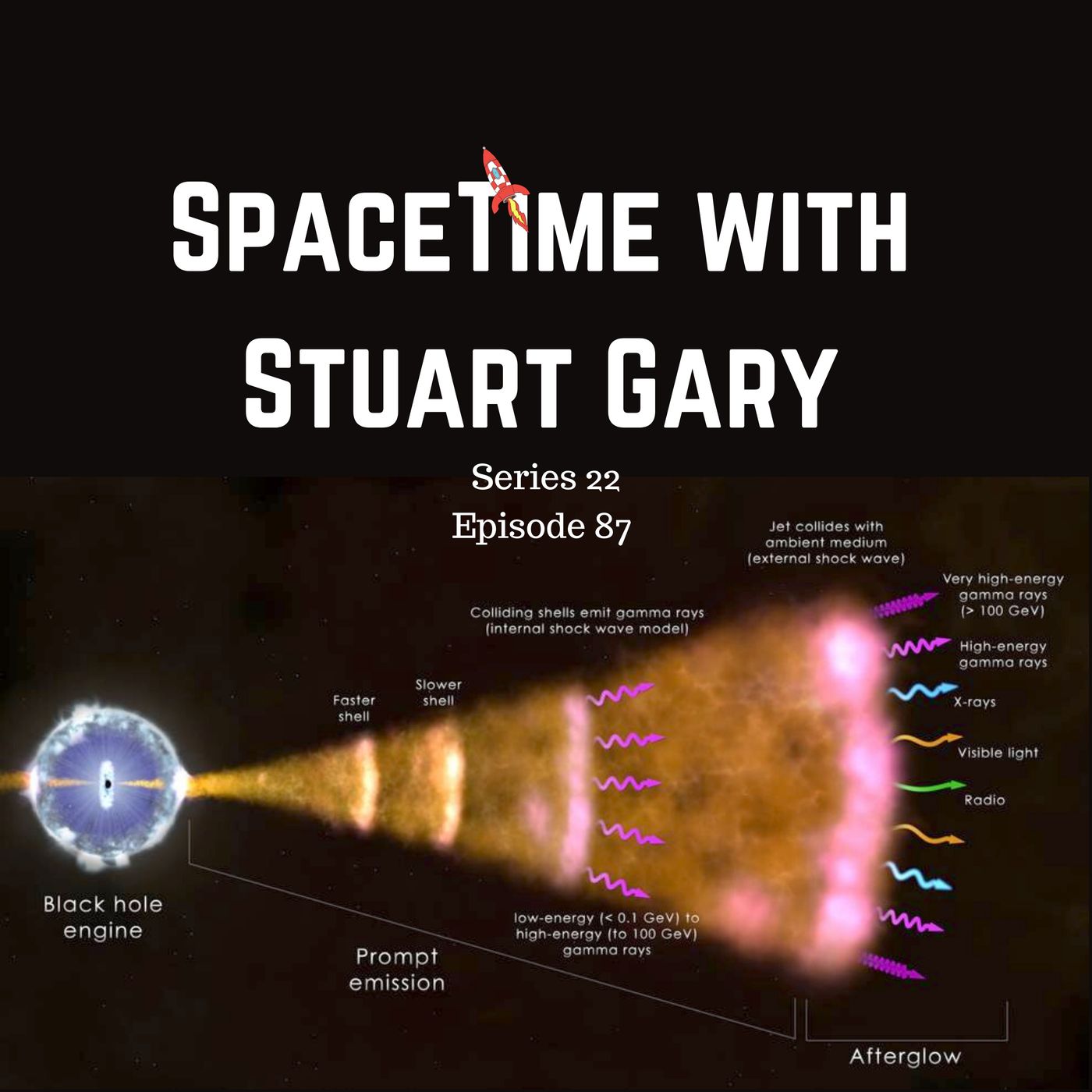
SpaceTime with Stuart Gary87: Gamma Ray Bursts Reveal More of Their SecretsStream podcast episodes on demand from www.bitesz.com/spacetime (mobile friendly). SpaceTime with Stuart Gary S22E87 *Gamma Ray Bursts reveal more of their secretsA violent explosion in a distant galaxy has broken the record for the brightest source of high-energy electro-magnetic radiation in the universe.*Evidence of missing neutron star inside Supernova 1987AAstronomers have finally uncovered evidence of the missing neutron star that has been hidden at the heart of Supernova 1987A for over 30 years.*Blobs said to be evidence of life on MarsAs scientists continue their research to determine whether life has ever or could ever have ex...
2019-11-2729 min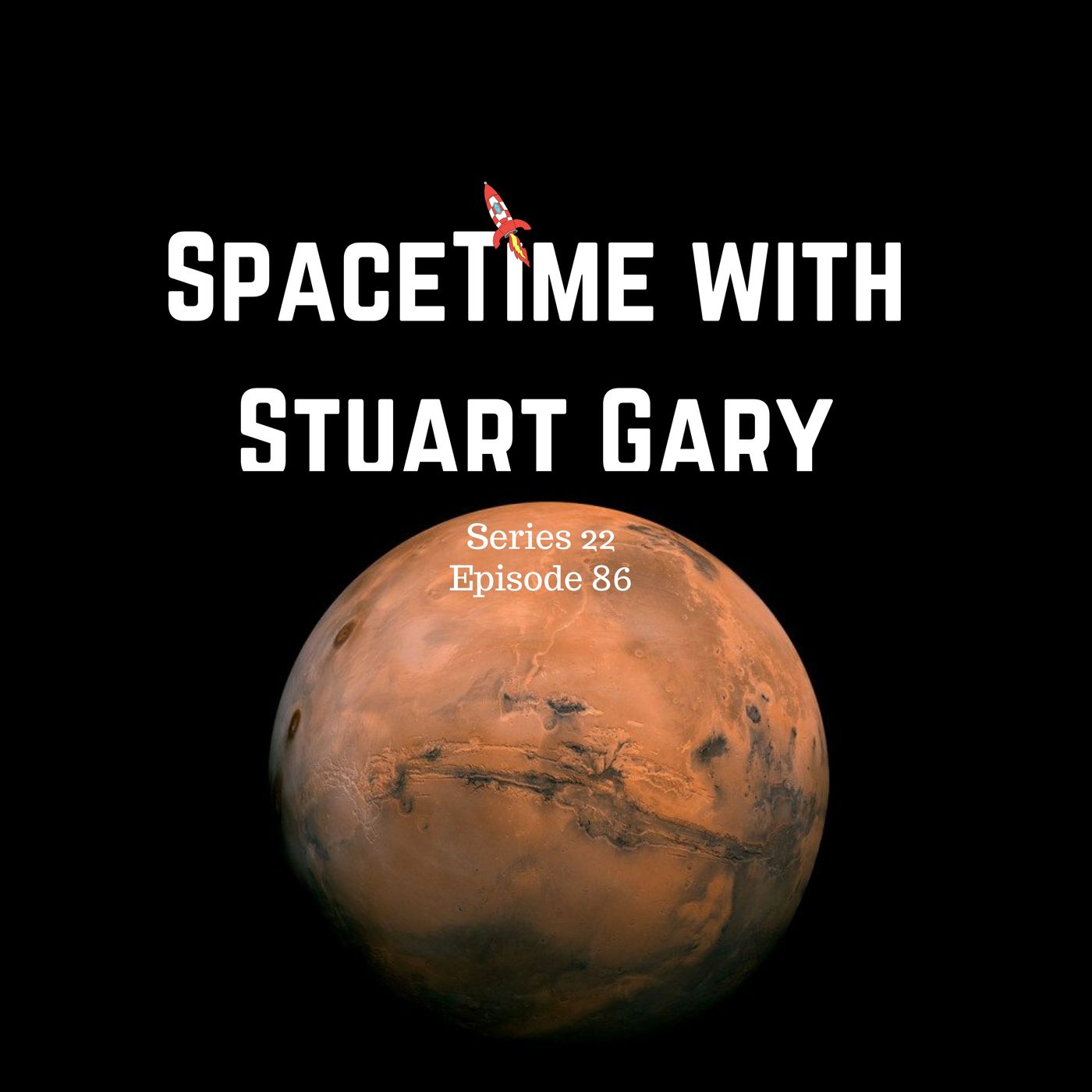
SpaceTime with Stuart Gary86: Unexplained Martian Oxygen LevelsStream podcast episodes on demand from www.bitesz.com/spacetime (mobile friendly). *Unexplained seasonal changes discovered in Martian oxygen levelsScientists have detected mysterious seasonal changes in oxygen levels in the air directly above the surface of Gale Crater on Mars.*Water detected on interstellar visitorAstronomers have detected signs of water spewing from the interstellar comet 2i Borisov which is about to make its closest approach to the Sun before beginning its trek back out of the solar system.*Hundreds more Near Earth Objects detectedThe European Space Agency’s Near Earth Objects Co-ordination Centre has detected another 350 previously unknown NEO’s or Ne...
2019-11-2239 min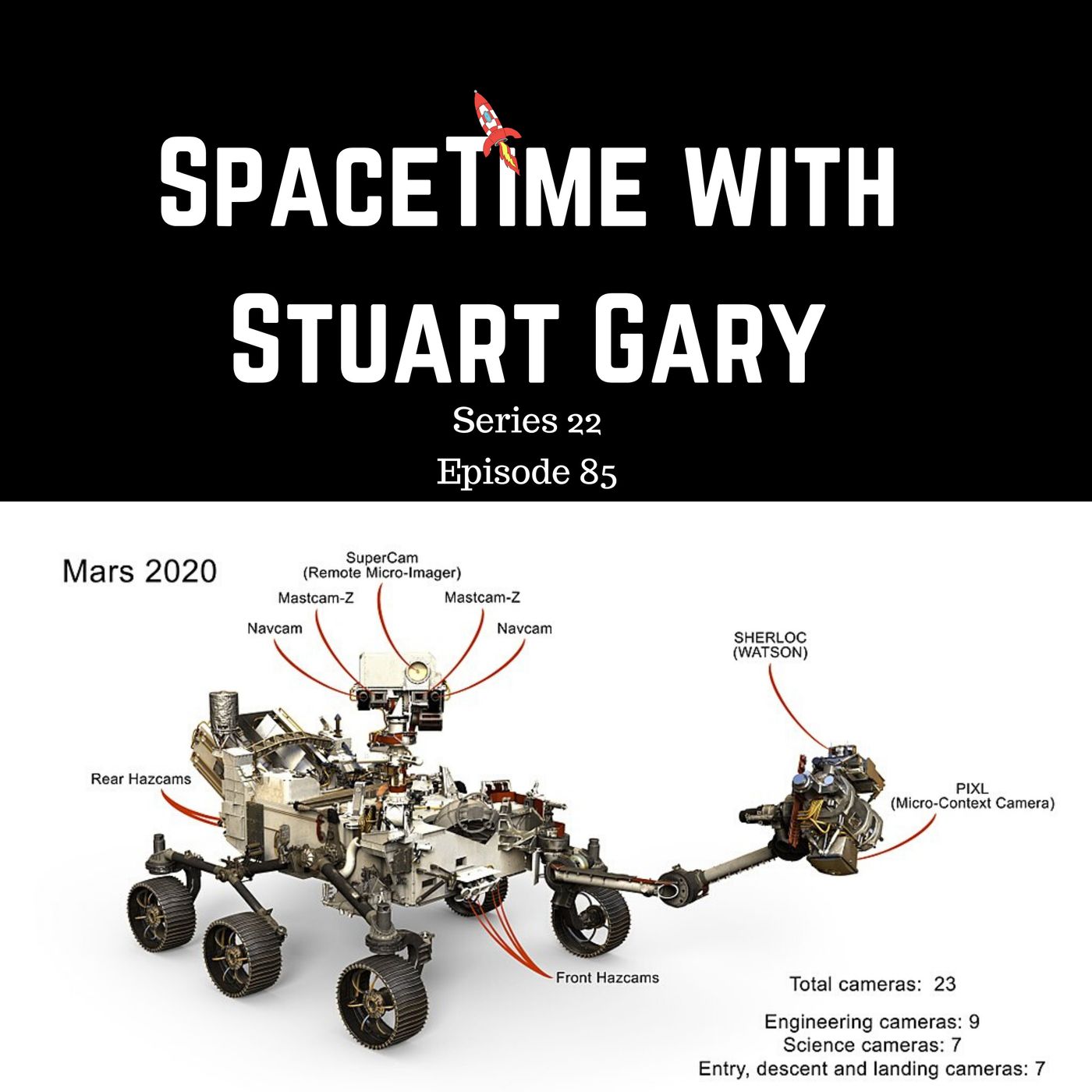
SpaceTime with Stuart Gary85: Mars 2020 Rover - The Hunt Is OnStream podcast episodes on demand from www.bitesz.com/spacetime (mobile friendly). SpaceTime with Stuart Gary S22E85 *Mars 2020 rover to search for microscopic fossilsNASA’s Mars 2020 rover will land on the Red Planet’s JEZERO Crater. The landing site was selected as it’s considered the best place on the planet to look for signs of microscopic fossils and ancient life.YouTube URL https://spacetimewithstuartgary.tumblr.com/post/189029639023 *New comet interceptor missionThe European Space Agency is planning a new mission to study a comet. The comet interceptor mission will follow on from the Rosetta spacecraft mission which spent two years study...
2019-11-2041 min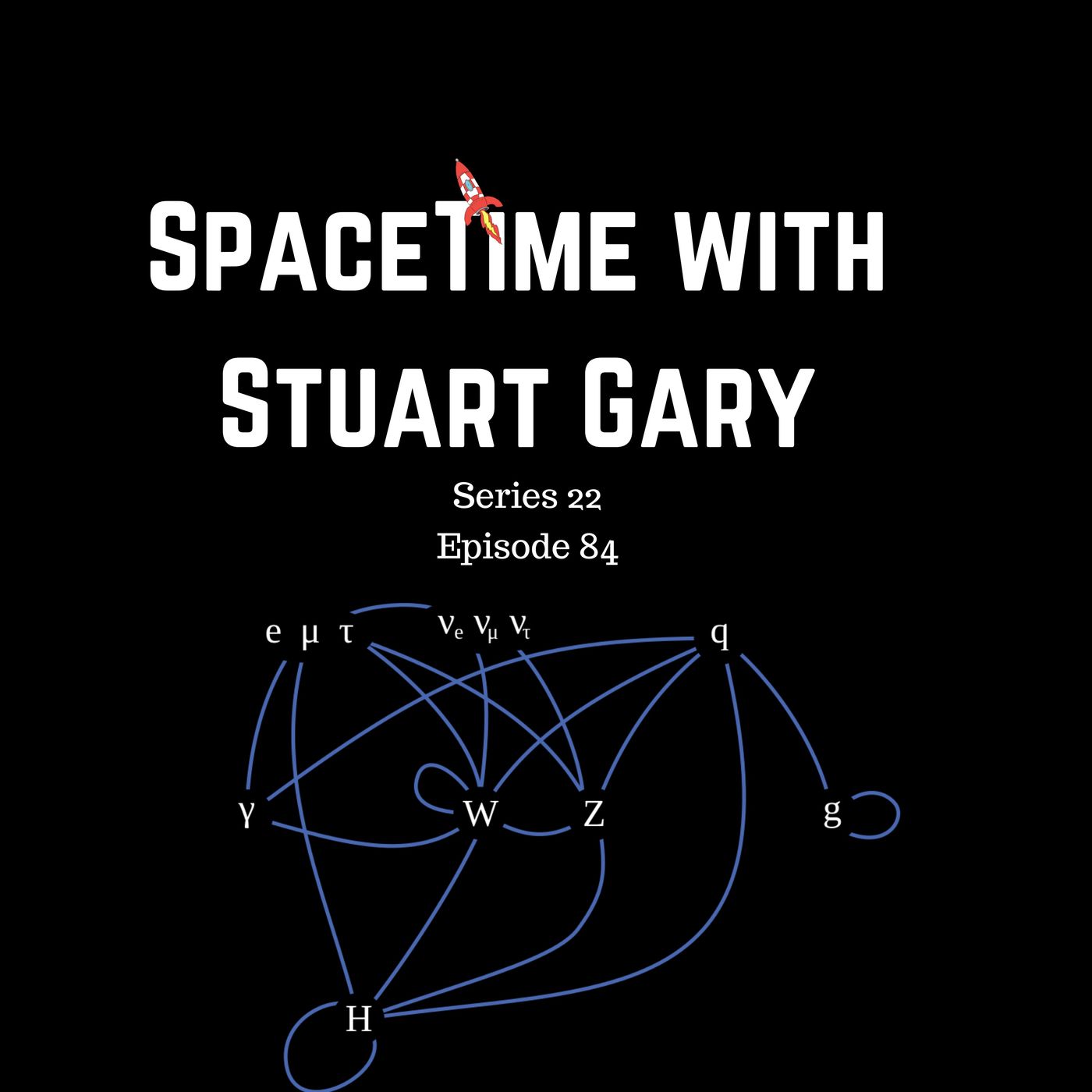
SpaceTime with Stuart Gary84: Measuring the Higgs BosonThe astronomy and space science news podcast.SpaceTime with Stuart Gary S22E84Stream podcast episodes on demand from www.bitesz.com/spacetime (mobile friendly). *New measurement for the mass of the Higgs bosonPhysicists have achieved a new level of precision in their efforts to measure the Higgs boson – finding it to have a mass of 125.35 GeV with a precision of 0.15 GeV -- an uncertainty of roughly 0.1%. *Voyager 2 illuminates the boundary of interstellar spaceScientists publish five new research papers detailing the stunning findings of Voyager 2 from the boundary between the solar system and interstellar space. *Climate satellite celebrates ten years in orbi...
2019-11-1542 min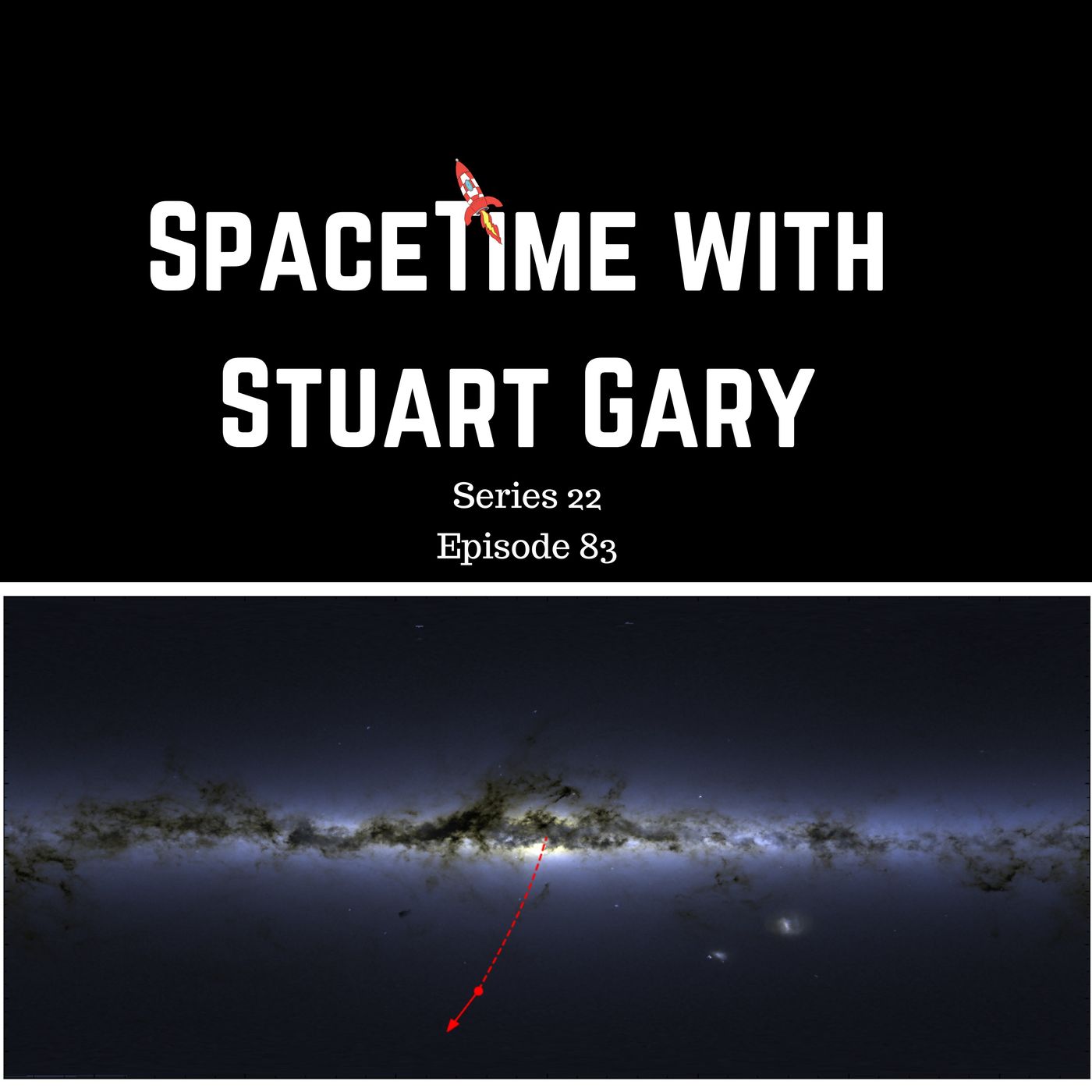
SpaceTime with Stuart Gary83: Tossed OutStream podcast episodes on demand from www.bitesz.com/spacetime (mobile friendly). *Star thrown out of galaxy by a black holeAstronomers have detected a star that’s being flung out of the Milky Way galaxy at a record breaking speed of over six million kilometres per hour by the super massive black hole at the galactic centre.YouTube URL: https://spacetimewithstuartgary.tumblr.com/post/189025267073 *Signs of the next solar cycle increaseThere’s more confirmation today that the Sun’s magnetic poles have flipped marking the start of solar cycle 25. *Gaia’s astronomical revolutionThe European Space Agency’s Gaia spacecraft has now completed i...
2019-11-1333 min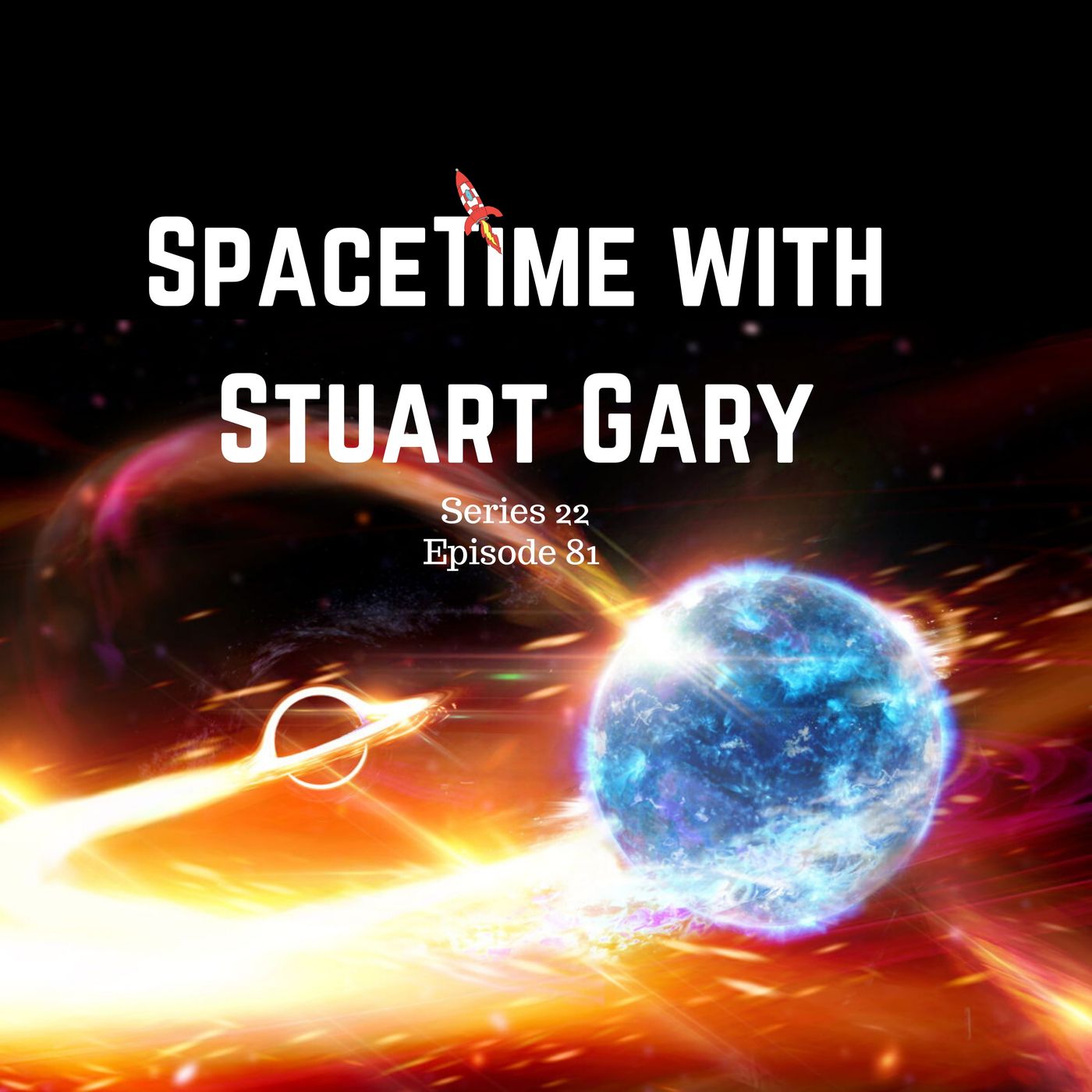
SpaceTime with Stuart Gary81: Quantum SqueezingStream podcast episodes on demand from www.bitesz.com/spacetime (mobile friendly). SpaceTime 20191106 Series 22 Episode 81*Quantum squeezing to detect every stellar-mass black hole merger in the universeScientists have found a way to detect virtually every stellar black hole collision in the universe by refining a technique called quantum squeezing. *New evidence that the first stars formed very quicklyAstronomers studying and ancient quasar have discovered a primitive gas cloud providing new clues about the birth of the universe’s first stars. *A mission to slam an impactor into an asteroidNASA and the European Space Agency are planning a double mission to slam a...
2019-11-0635 min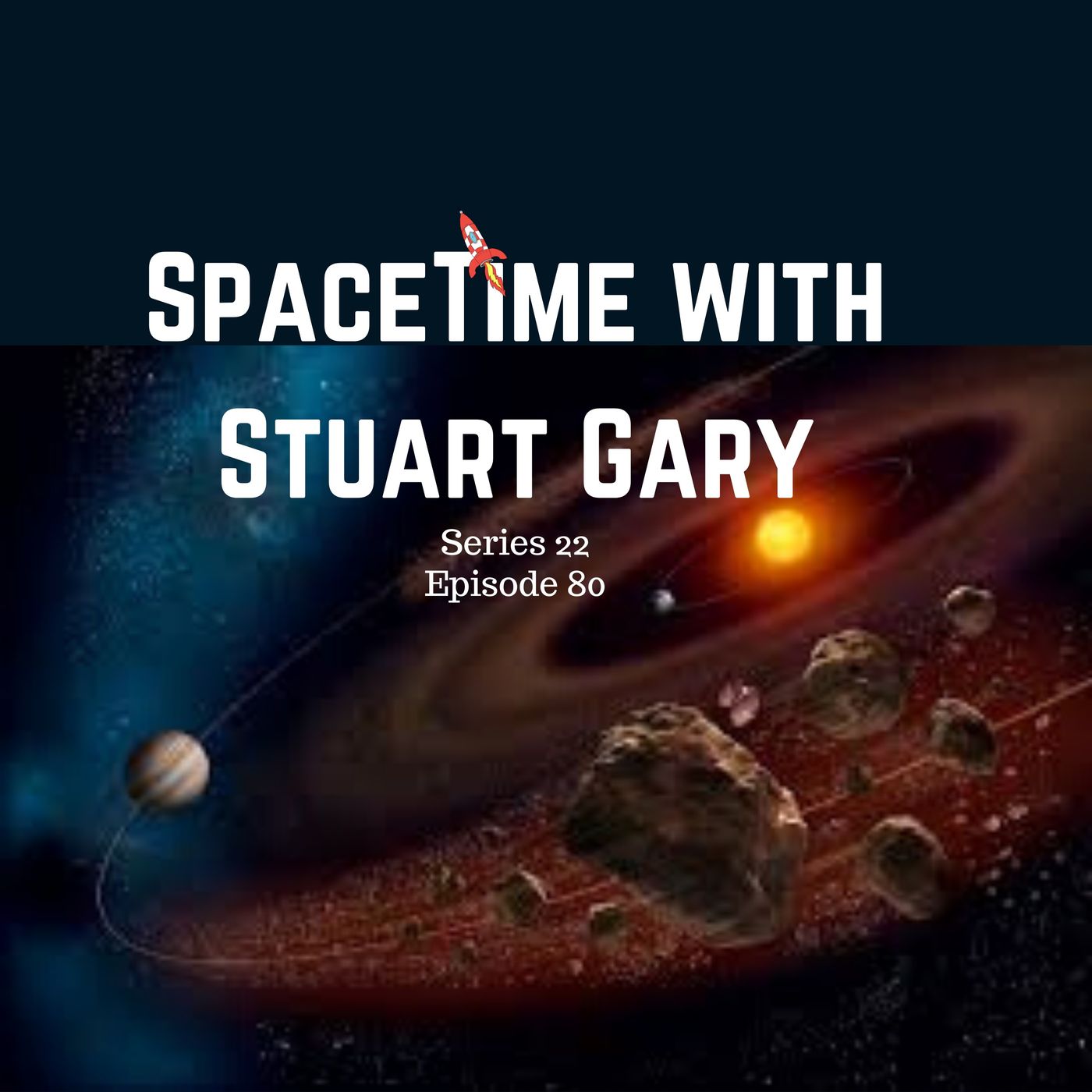
SpaceTime with Stuart Gary80: Construction About to Begin for the Lucy Trojan Asteroid MissionStream podcast episodes on demand from www.bitesz.com/spacetime (mobile friendly). SpaceTime 20191101 Series 22 Episode 80 *Construction about to begin for the Lucy trojan asteroid missionNASA’s Lucy mission to study Jupiter’s trojan asteroids has passed its final design review and has now moved into the construction phase -- bringing it one step closer to its 2021 launch date.You tube URL: https://spacetimewithstuartgary.tumblr.com/post/188537172673 *Solar Orbiter on its way to the launch padThe European Space Agency’s Solar Orbiter spacecraft has completed its test campaign in Europe and is now on its way to Cape Canaveral ahead of its launch...
2019-11-0131 min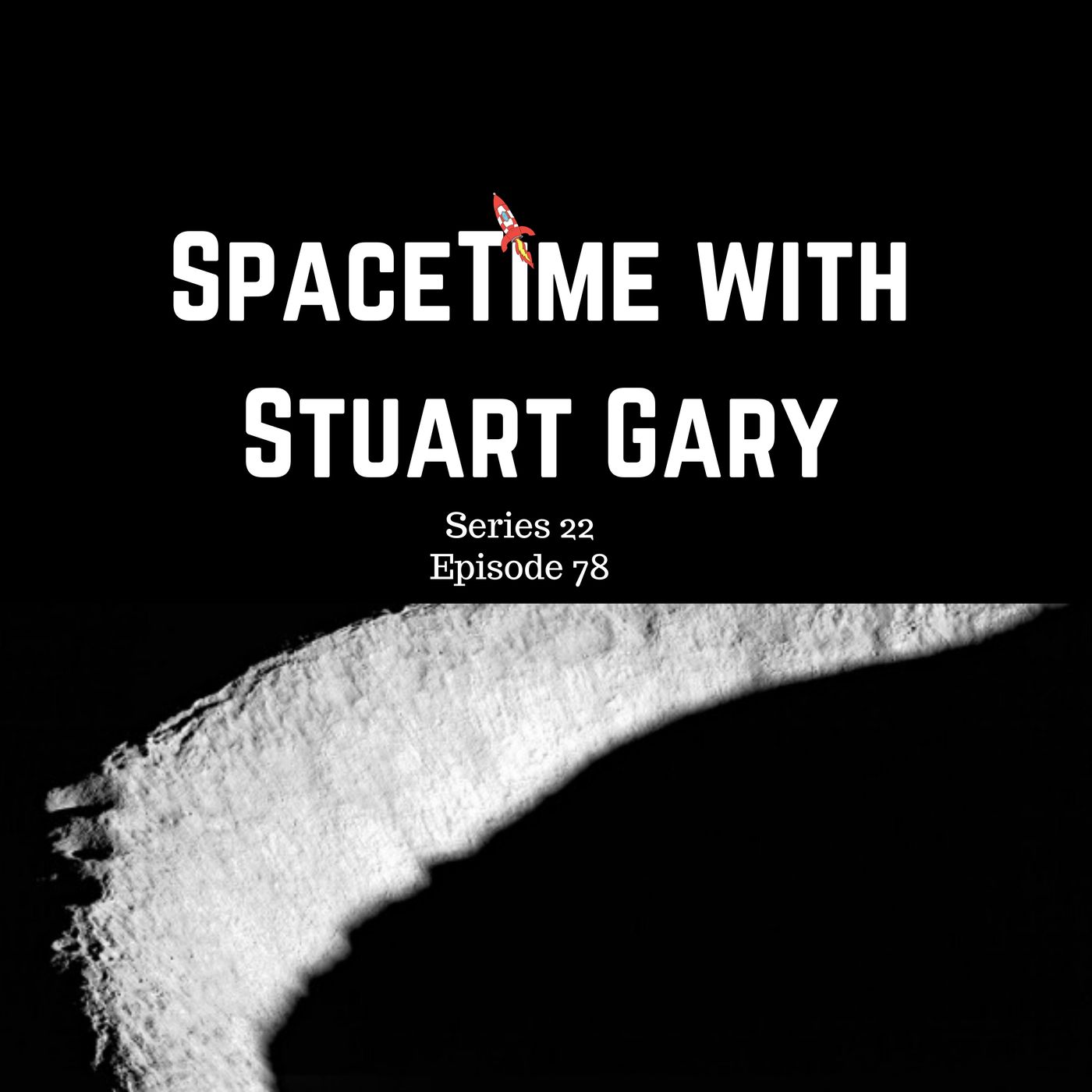
SpaceTime with Stuart Gary78: Some Water On the Moon May Be Fairly RecentThe astronomy and space science news podcast.Stream podcast episodes on demand from www.bitesz.com/spacetime (mobile friendly). SpaceTime 20191025 Series 22 Episode 78*Some water on the Moon may be fairly recentA new study suggests water ice discovered on the lunar surface didn’t all arrive at once by may have accumulated over billions of years with some deposits being relatively young. *New organic compounds found in Enceladus iceNew kinds of organic compounds, the ingredients of amino acids, have been detected in the plumes erupting from Saturn’s ice moon Enceladus. *What happens under the Yellowstone volcanoA new study has found that the...
2019-10-2536 min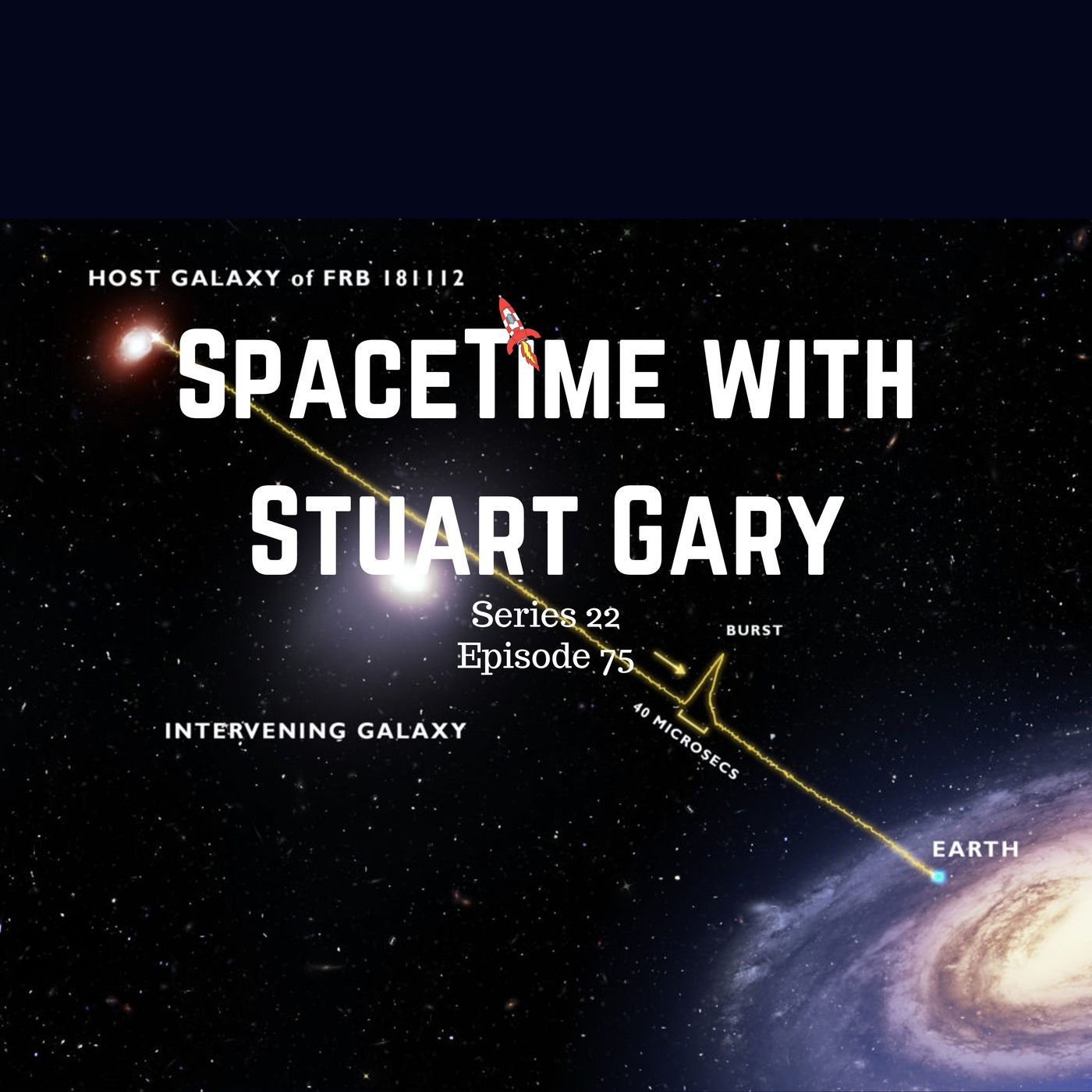
SpaceTime with Stuart Gary75: Galaxies Sitting In Serene Halos of GasSpaceTime with Stuart Gary S22E75Stream podcast episodes on demand from www.bitesz.com/spacetime (mobile friendly). *New discoveries show galaxies sit in serene halos of gasAstronomers studying the origins of a mysterious cosmic blast known as a Fast Radio Burst have unexpectedly uncovered important clues about the properties of the vast halos of gas surrounding galaxies. *The Milky Way’s active galactic haloA new study has discovered that the Milky Way galaxy is constantly exchanging matter with the neighbouring intergalactic medium. *The origins of the Interstellar Comet 2I/Borisov A new study claims the recently discovered interstellar comet 2I Borisov...
2019-10-1635 min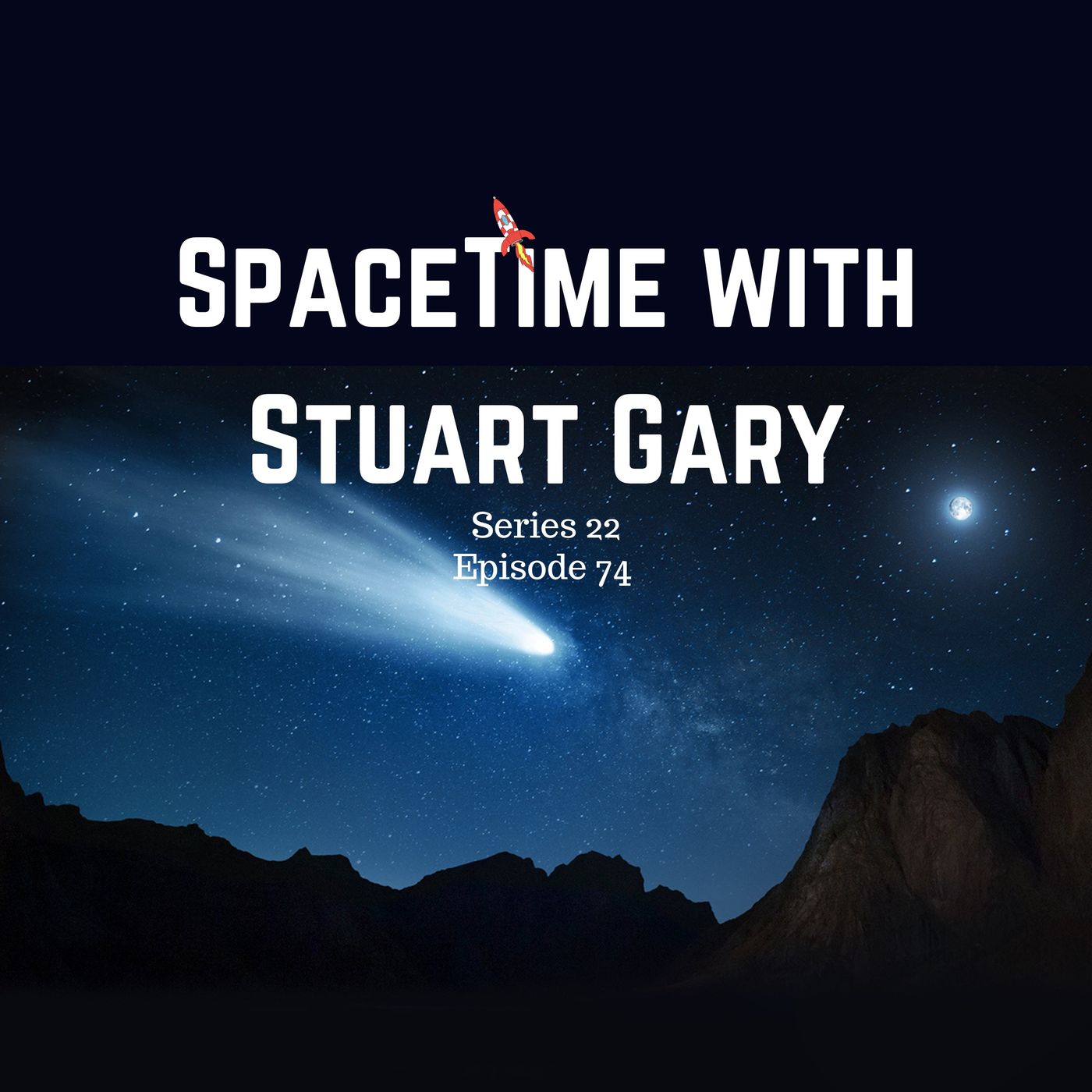
SpaceTime with Stuart Gary74: Cometary Orbital Gateway DiscoveredSpaceTime with Stuart Gary S22E74 Stream podcast episodes on demand from www.bitesz.com/spacetime (mobile friendly). *Cometary orbital gateway discovered Science’s understanding of how comets are funneled into the inner solar system may have fundamentally changed following the discovery of an orbital gateway. *ASA and NASA sign formal agreement to work together ASA the Australian Space Agency has signed a formal agreement to work closely with NASA on future robotic and manned missions including America’s return to the Moon and eventually Mars and beyond. *Japan launches new cargo ship to the International Space Station Japan has finally lau...
2019-10-1134 min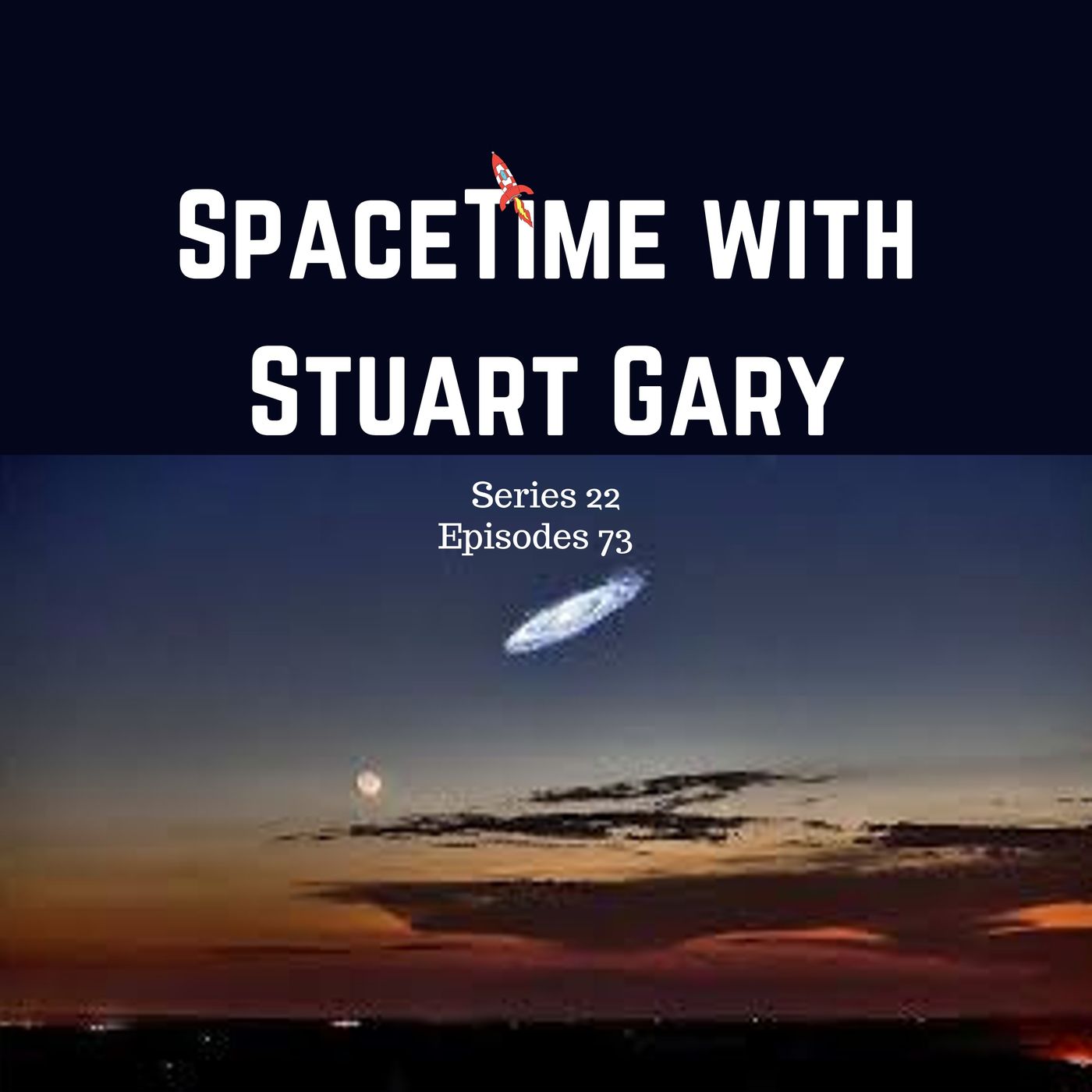
SpaceTime with Stuart Gary73: Andromeda’s Violent HistorySpaceTime with Stuart Gary S22E73Stream podcast episodes on demand from www.bitesz.com/spacetime (mobile friendly). *Andromeda’s violent history Astronomers have pieced together the cannibalistic past of our neighbouring large galaxy Andromeda, which has now set its sights on the Milky Way as its next main course. *How old are Saturn’s rings A team of researchers has reignited the debate about the age of Saturn’s rings with a study that dates the rings as most likely to have formed early in the solar system. *Orion Launch Abort System test success NASA has carried out a successful tes...
2019-10-0940 min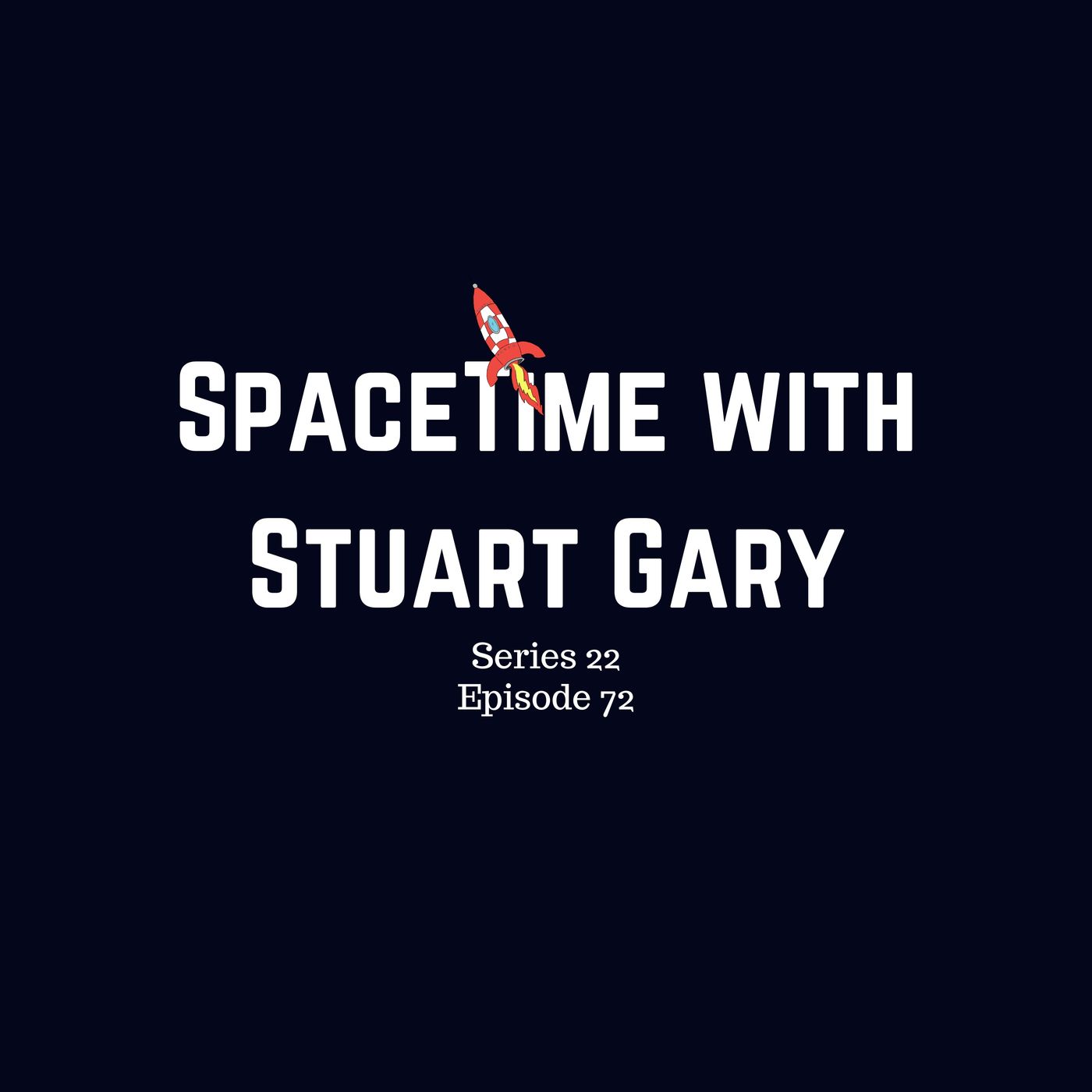
SpaceTime with Stuart Gary72: Indian Moon Hopes FadeFor access to the special double episode commercial-free version of SpaceTime plus bonus content, simply help support the show. Show your love via Patreon....and share in the rewards. Details at www.patreon.com/spacetimewithstuartgary Stream podcast episodes on demand from www.bitesz.com/spacetime (mobile friendly). SpaceTime with Stuart Gary S22E72 *Indian Moon hopes fadeHopes are fading for Indian space officials to re-establish contact with their lost Vikram lunar lander. *The Moon cameraThe story of the camera Apollo astronauts took to the Moon.YouTube link: https://spacetimewithstuartgary.tumblr.com/post/186372679523 *Roscosmos keeping quiet about leakA Russian Board of Enqu...
2019-09-2733 min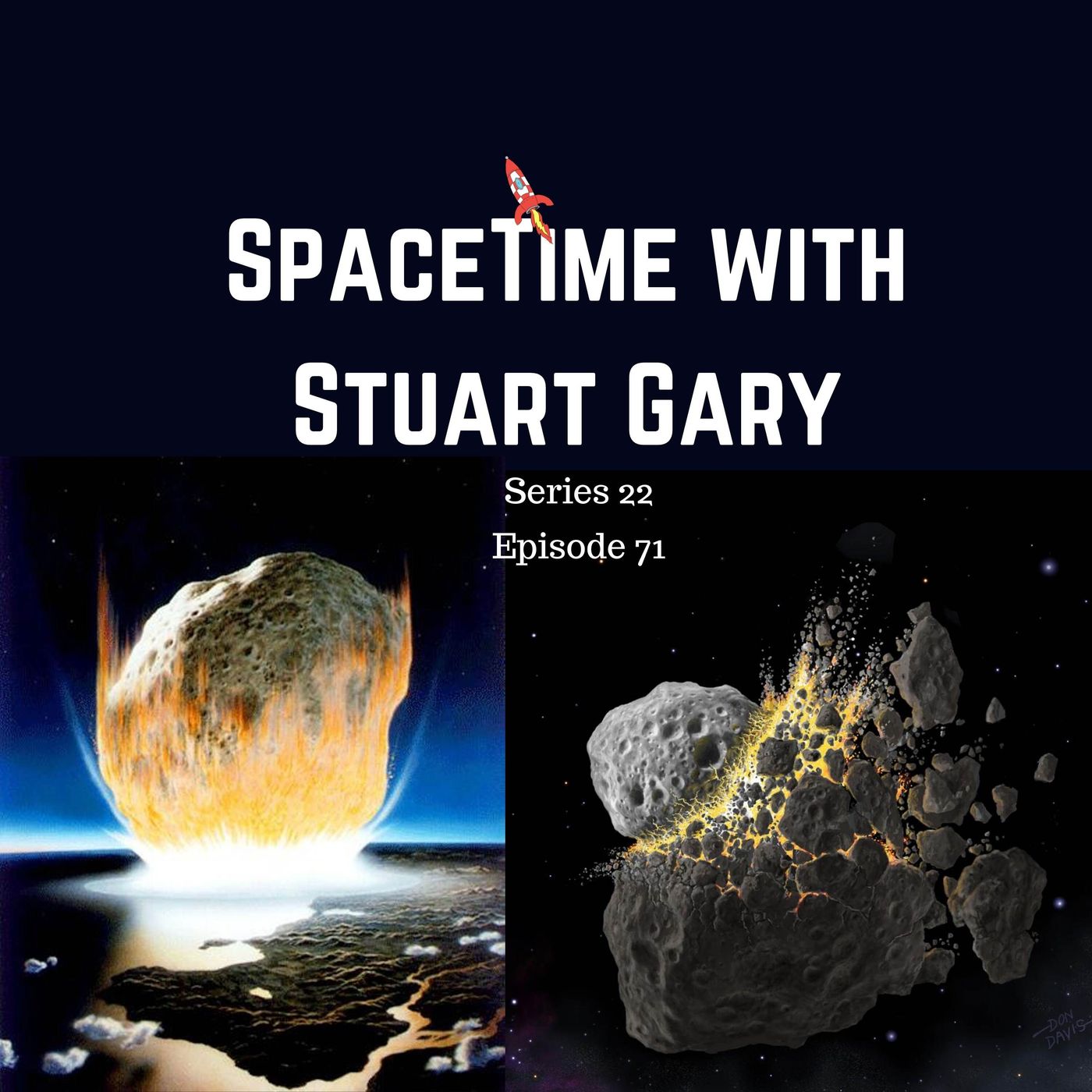
SpaceTime with Stuart Gary71: The Day The Dinosaurs DiedSpaceTime with Stuart Gary S22E71For more SpaceTime visit www.bitesz.com/spacetime (mobile friendly). *What the geologic record tells us about the day the dinosaurs diedA new study has provided scientists with their most detailed look yet at the events which ended the age of dinosaurs – creating one of the Earth’s worst-ever mass extinction events. *Asteroid triggered ice age changed life on Earth foreverScientists have found that a cataclysmic collision in the main asteroid belt 466 million years ago eventually lead to a major ice age on Earth which changed the evolution of life on the planet forever. *Most m...
2019-09-2527 min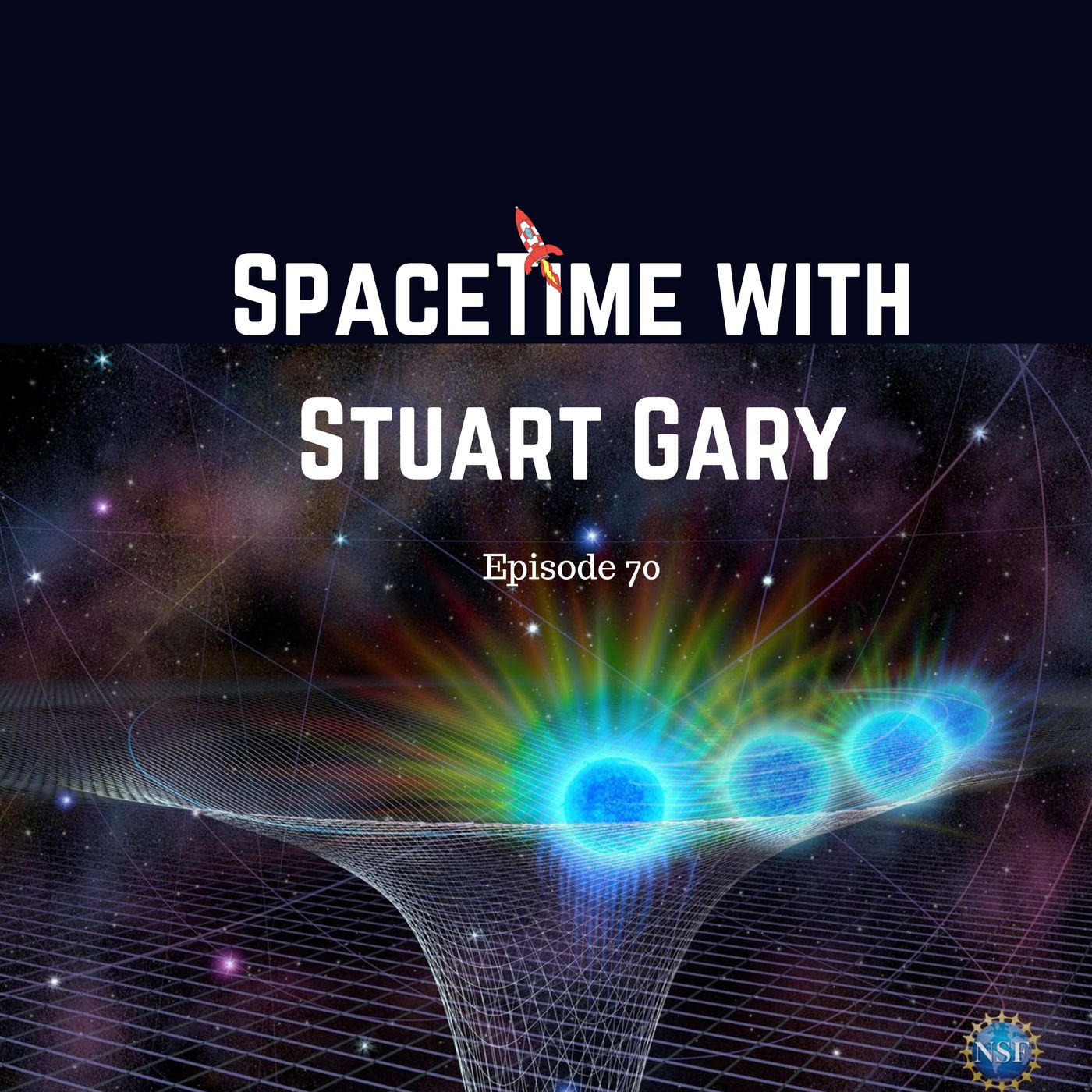
SpaceTime with Stuart Gary70: The Monster at the Centre of the Milky Way Is Getting ActiveStream podcast episodes on demand from www.bitesz.com/spacetime (mobile friendly). *The monster at the centre of the Milky Way is getting activeThere’s growing evidence that the supermassive black hole at the center of our Milky Way galaxy is getting more active. *Nitrogen explosions may have created lakes on TitanNew research suggests the lakes of liquid methane on Saturn’s largest moon Titan were probably formed by pressurized nitrogen exploding just below the moon’s surface. *Water detected for the first time on a potentially habitable planetWater vapour has been detected for the first time in the atmosphere of a habit...
2019-09-2024 min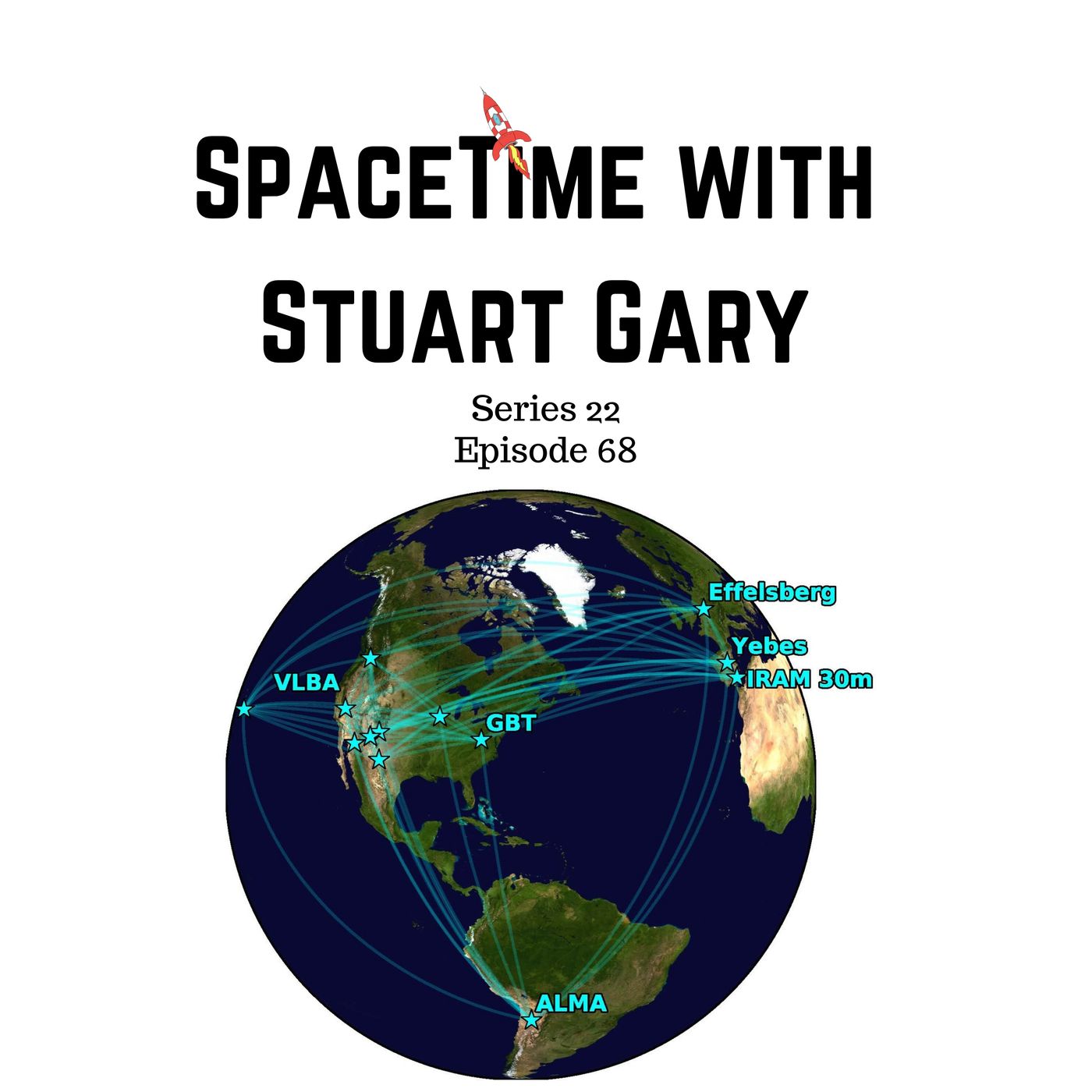
SpaceTime with Stuart Gary68: Monster Black Hole Firing an Energy Beam Towards EarthThe astronomy and space science news podcast.Stream podcast episodes on demand from www.bitesz.com/spacetime (mobile friendly). *The Monster black hole firing an energy beam towards EarthNew observations of the supermassive black hole at the centre of our galaxy suggest it’s shooting a powerful energy beam almost directly towards our solar system. *Discovery of eight more repeating Fast Radio BurstsAstronomers may be a step closer to finally solving the mystery of Fast Radio Bursts following the discovery of eight rare repeating bursts. *A treasure trove of ancient galaxies uncovered in the distant universeAstronomers have discovered vast treasure tro...
2019-09-1329 min
SpaceTime with Stuart Gary66: Catastrophic Iranian Rocket FailureThe astronomy and space science news podcast.Stream podcast episodes on demand from www.bitesz.com/spacetime (mobile friendly). *A catastrophic rocket failure at a top-secret Iranian missile complexNew satellite images show what appears to have been a catastrophic rocket failure at a top-secret Iranian missile complex. *India’s manned space mission set for 2022 launchIndia has ordered Russian technology for its first manned space mission. *Indian space junk remains a problemA new report claims there are still more than a hundred pieces of space debris floating around in orbit from an Indian anti-satellite missile test. *Unmanned Soyuz test flight forced to...
2019-09-0628 min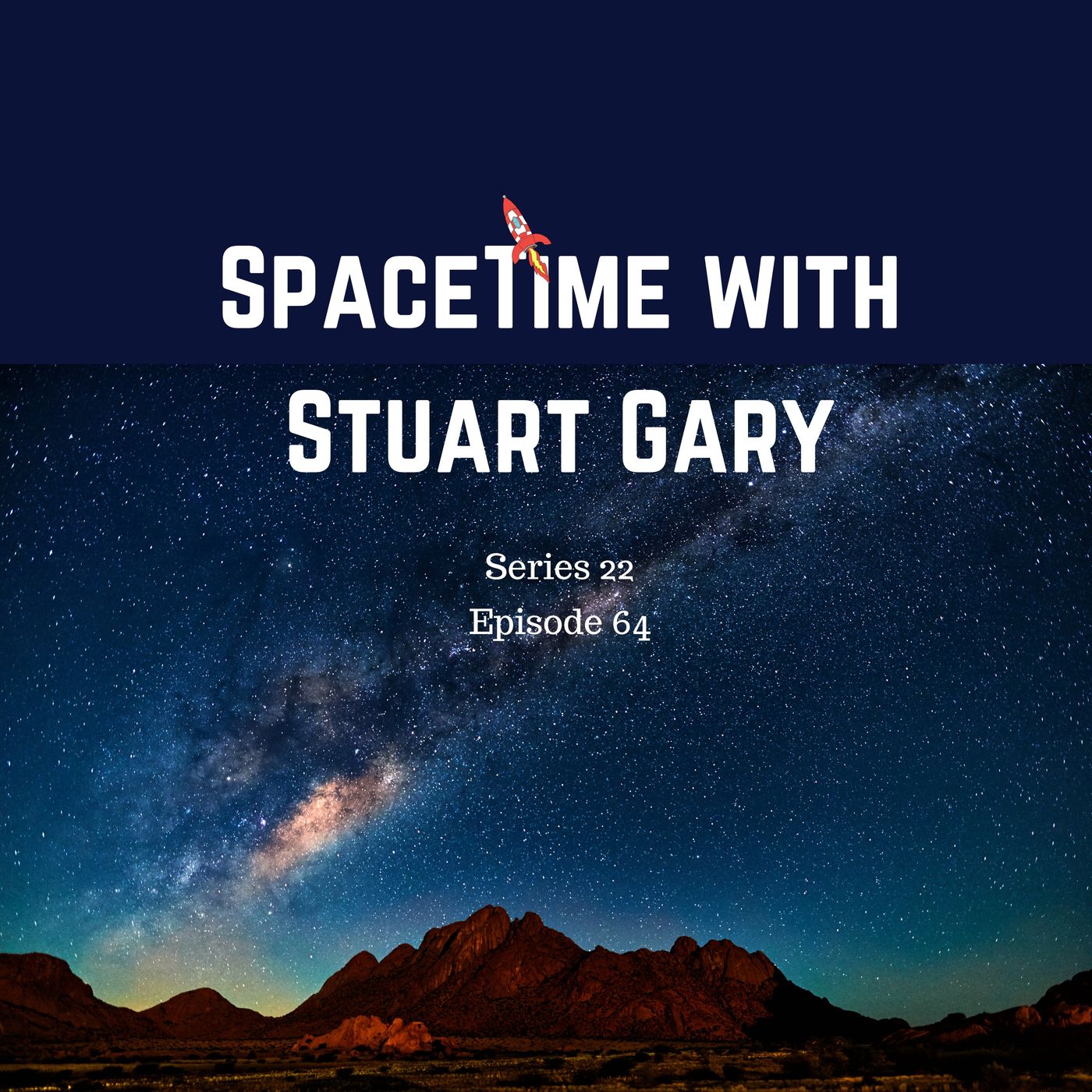
SpaceTime with Stuart Gary64: A New Map of the Milky Way’s Place In the UniverseStream podcast episodes on demand from www.bitesz.com/spacetime (mobile friendly). *A new map of the Milky Way’s place in the universeA new map of the local universe has confirmed that the large scale structure of the universe appears to be a honeycomb-like pattern composed of interconnecting filaments and strands full of galaxies, galaxy clusters, and superclusters surrounding vast empty voids. *Mission to Jupiter's Icy Moon ConfirmedNASA has approved a new mission to study Jupiter’s ice moon Europa. *The Science ReportA big turn-around by the Heart Foundation greenlights full-fat milk, yogurt and cheese as healthy eating.Living in ci...
2019-08-3029 min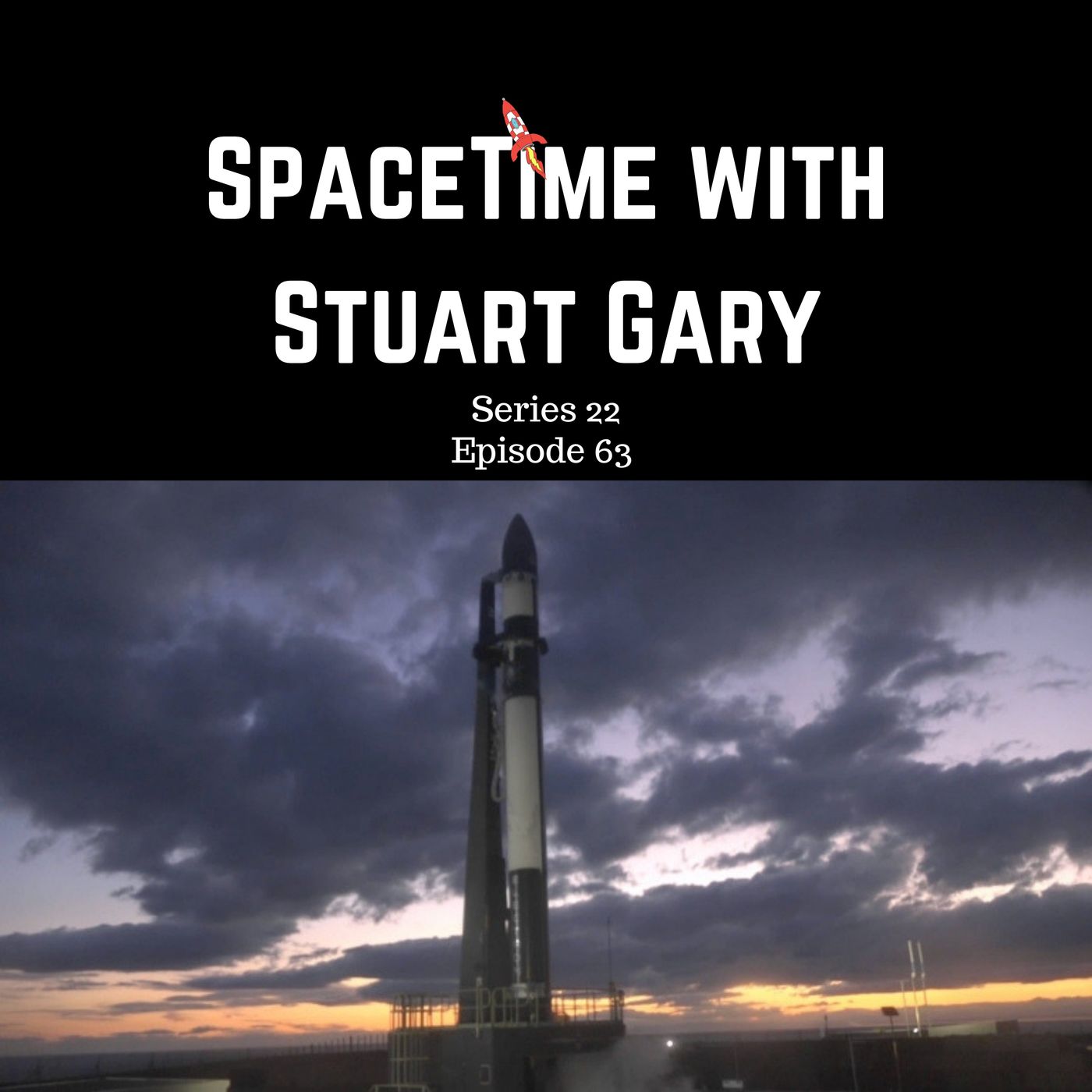
SpaceTime with Stuart Gary63: Four Potential Sites for Asteroid Sample Return MissionThe astronomy and space science news podcast.Stream podcast episodes on demand from www.bitesz.com/spacetime (mobile friendly). *Four potential sites for asteroid sample return missionNASA has selected four potential sample sites for its OSIRIS-Rex mission to the asteroid Bennu.You tube video url: https://spacetimewithstuartgary.tumblr.com/post/187047766578 *Scientists expose one of the secrets of the neutrinoScientists have finally determined the upper mass boundary of the lightest known neutrino – finding the abundant ‘ghost’ particle to be at least 10 million times less massive than an electron. *Mars at Solar ConjunctionThe red planet Mars is about to reach Solar Conjunction – the period...
2019-08-2830 min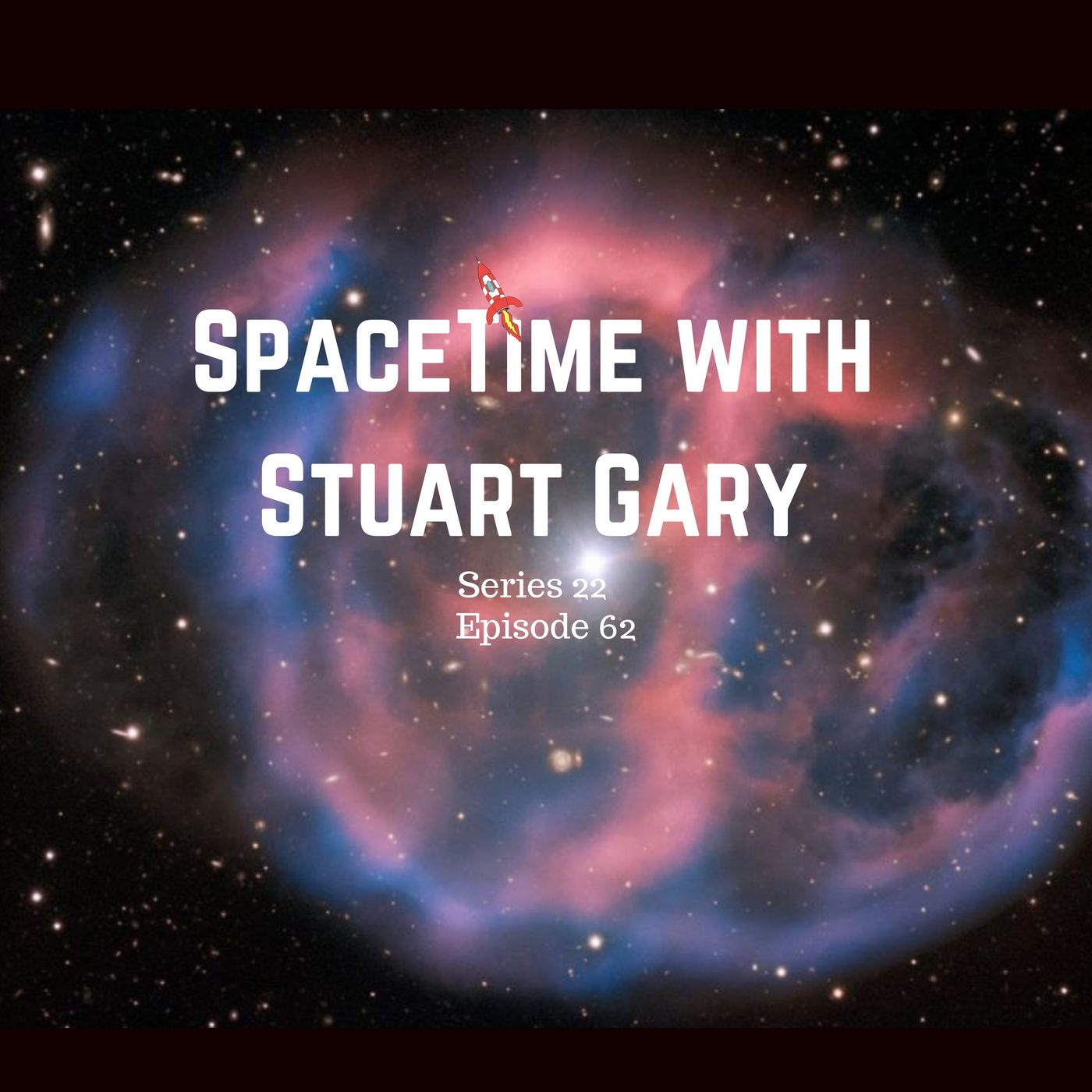
SpaceTime with Stuart Gary62: A New Type of Pulsating StarThe astronomy and space science news podcast.Stream podcast episodes on demand from www.bitesz.com/spacetime (mobile friendly). *A new type of pulsating starAstronomers have discovered a new type of pulsating subdwarf star. *A glitch in a neutron starAstronomers are a step closer to solving one of the great mysteries of neutron stars – why they glitch. *Massive radiation leak from secret Russian weapons project blastNew readings are showing gamma radiation levels 16 times higher than the normal background in town and villages up to 30 kilometres from a Russian Missile test site which was rocked by a massive explosion last week. *Chi...
2019-08-2331 min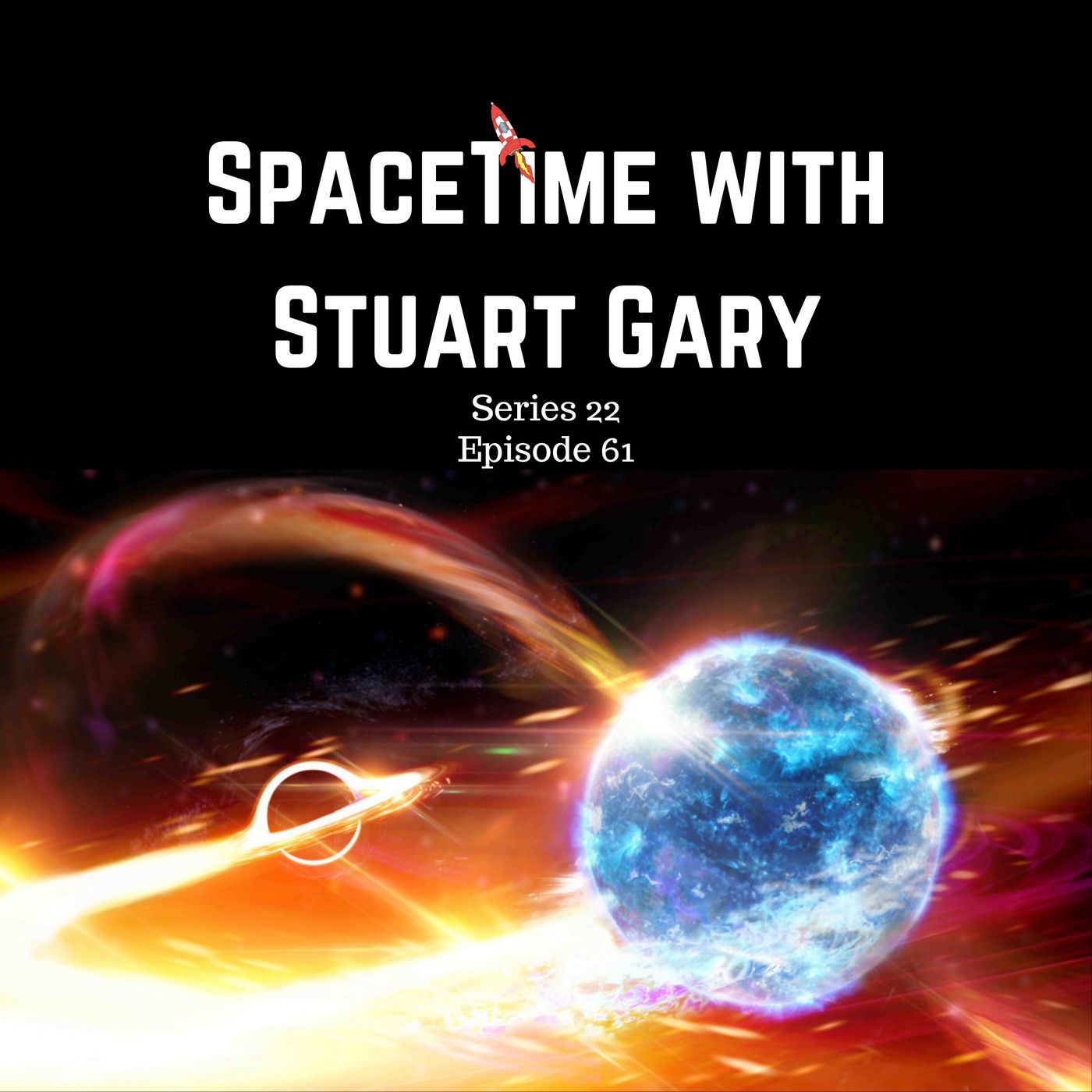
SpaceTime with Stuart Gary61: Black Hole Detected Devouring Neutron StarThe astronomy and space science news podcast.Stream podcast episodes on demand from www.bitesz.com/spacetime (mobile friendly). *The historic first-ever detection of a Black Hole devouring a Neutron StarThe astronomical community is in overdrive following reports of the possible first-ever detection of gravitational waves generated by a black hole devouring a neutron star. *Jupiter’s ancient planetary collisionA new study claims the solar system’s largest planet – the gas giant Jupiter – may have been involved in a colossal planetary collision 4.5 billion years ago.YouTube URL: https://spacetimewithstuartgary.tumblr.com/post/187041970213 *India Moon mission enters lunar orbitIndia’s second lunar mission...
2019-08-2129 min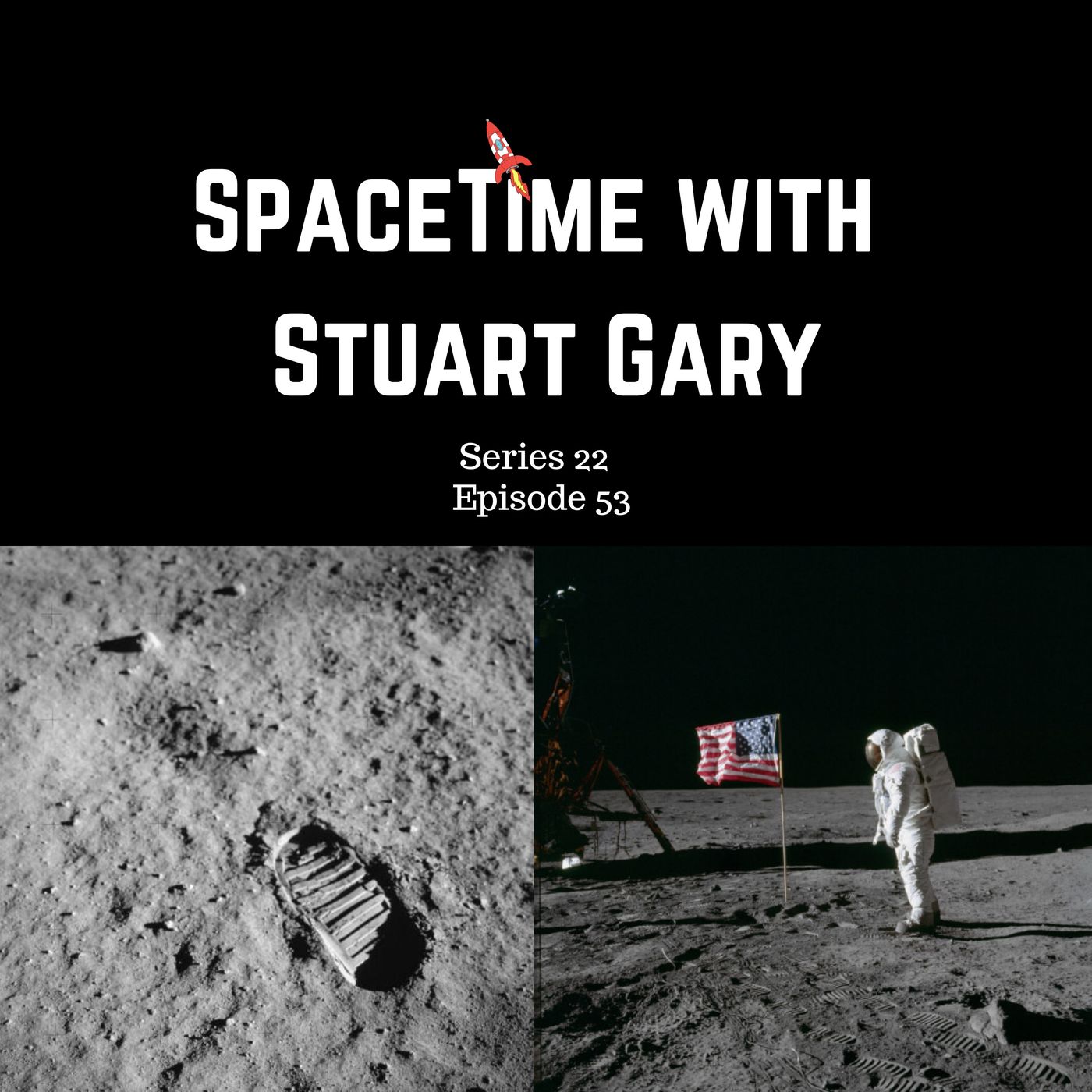
SpaceTime with Stuart Gary53: Man on the Moon: Apollo 11 Celebrates Half a CenturySpaceTime with Stuart Gary Series 22 Episode 53 The astronomy and space science news podcast.Stream podcast episodes on demand from www.bitesz.com/spacetime (mobile friendly). *Man on the Moon: Apollo 11 celebrates half a centuryA special SpaceTime documentary looking back at what is arguably the greatest scientific achievement of mankind. 50 years ago, on July 20th, 1969 human’s set foot on the surface of another world for the first time. SpaceTime places the Apollo 11 mission into its true context with its origins in the pure evil of Nazi Germany and its political weaponization during the height of the cold war. We tell the...
2019-07-1839 min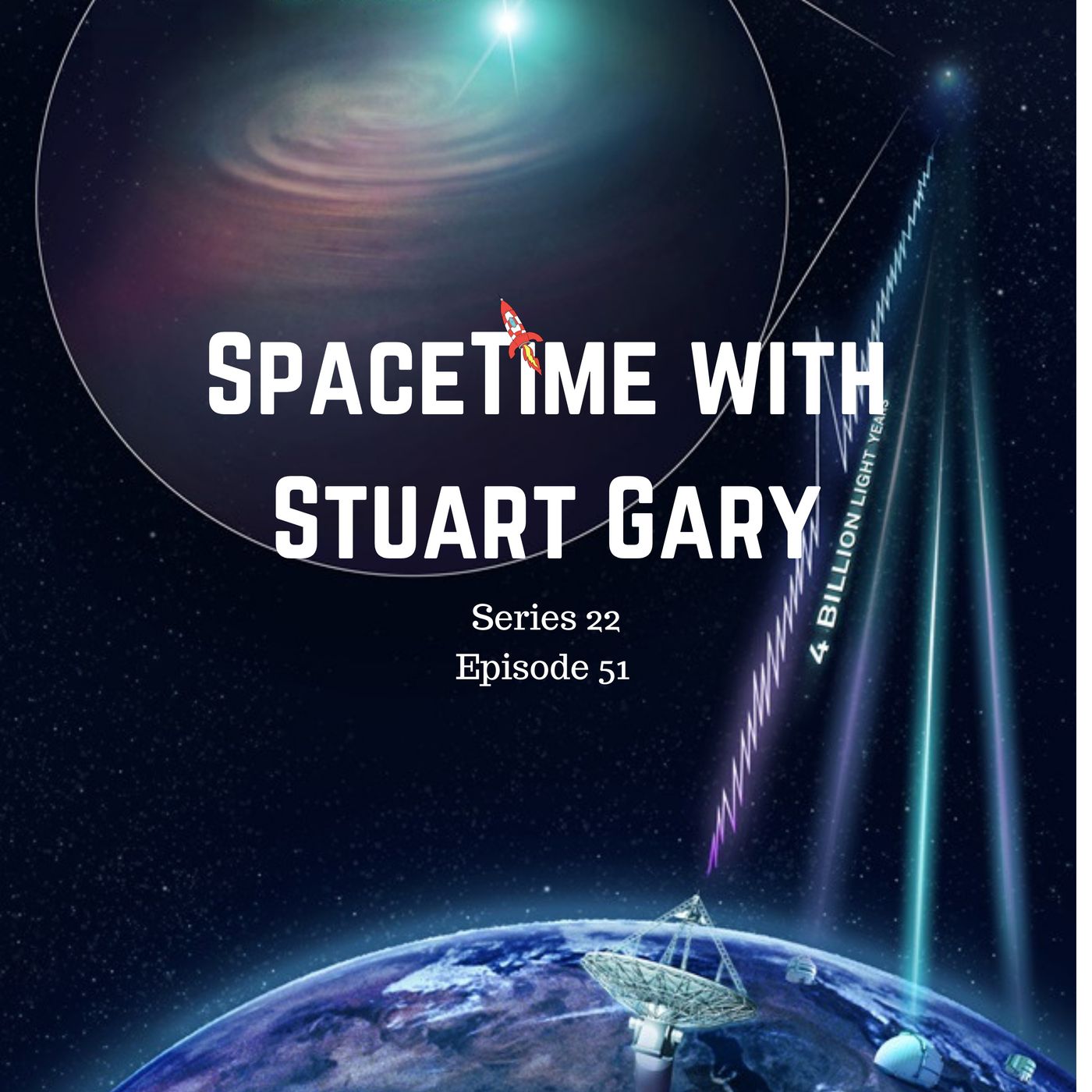
SpaceTime with Stuart Gary51: First Images of the Origins of FRBsThe astronomy and space science news podcast.Stream podcast episodes on demand from www.bitesz.com/spacetime (mobile friendly). SpaceTime with Stuart Gary S22E51 *First images of the origins of Fast Radio BurstsAstronomers have for the first time ever imaged the exact location of a one-off Fast Radio Burst – one of the most mysterious events in the universe. *All systems go for a new spacecraft to study the SunThe European Space Agency’s Solar Orbiter is continuing with a long series of tests as mission managers prepares the 1.8 tonne spacecraft for its seven year mission to study the Sun. *Dust...
2019-07-1035 min